:max_bytes(150000):strip_icc():format(webp)/GettyImages-1353420724-65161751b9924195880d3273e327cb54.jpg)
New Chromebook Linux Installation A Beginners Tutorial

Chromebook Linux Installation: A Beginner’s Tutorial
How to Install Linux on Chromebook

Ollie Mattison
Mar 27, 2024• Proven solutions
Chromebooks are an excellent choice for educational institutions or businesses that require their employees to have constant access to the Internet. Even though these devices are a perfect tool that can accompany you on business trips and enable you to answer important emails or have access to crucial information stored on the cloud, performing more demanding tasks, like video editing, is still a challenge. However, it is far from impossible, although you may have to take a few extra steps before running a video editing software on your Chromebook.
Chrome OS is a Linux based environment and for that reason, Chromebook owners who would like to use professional editing software on their Chromebooks can install a Linux OS that will enable them to use programs such as Lightworks that are perfectly suited for high-end video editing. There are two different ways to install Linux on a Chromebook, you can either do it using Gallium OS or ChrUbuntu or in a Chroot environment using Crouton. Each of these methods is relatively easy and we will take you through the process step by step. Here’s how you can install Linux on your Chromebook.
- Part 1: Preparing before installing Linux OS on Chromebook
- Part 2: How to Install Linux as a Chroot Using Crouton on Chromebook
- Part 3: How to Dual-Boot a Chromebook Using ChrUbuntu
- Part 4: How to Install Linux as a Chroot Using Crouton on Chromebook
- Part 5: Recommended Linux Video Editing Software
Part 1: Preparing before installing Linux OS on Chromebook
The first step of the process of installing the Linux OS is the decision itself, and you need to have all the necessary information before you decide to install a Linux OS on your Chromebook.
- Make sure that the version of Chromebook you have is capable of supporting a Linux OS. Your device must be equipped with an ARM or Intel chip in order to be able to run the version of Linux OS you want to install. Although both chips will allow you to go through the process, running closed source software such the Steam is only possible with Intel chips.
- Regardless of which method of installing Linux OS you choose, you will have to switch to the Developer Mode, a special built-in function that allows you to install the unapproved operating system, among other things.
- Now that you are aware of the requirements and risks, you will have to backup all the files you have on your Chromebook because once you switch to the Developer Mode all the information stored locally will be erased. You can save the files on another computer or on the cloud depending on how much data you need to move and which one is more convenient for you.
Part 2: How to Install Linux as a Chroot Using Crouton on Chromebook
After you have stored all your data safely, your Chromebook is ready for the beginning of the installation process of the secondary operating system. You will have to perform a series of actions that will allow you to start the installation, starting from accessing the Developer Mode.
1. Acessing the developer mode
The first step of the process is to reboot your system, while your Chromebook is on. In order to do so hold Escape and Refresh keys on your keyboard and then hit the power button. Once your device is back online you will find yourself in the recovery mode, and you will see a message telling you to insert a recovery disc. Instead of inserting the disc, hold Ctrl+D and wait for OS verification menu to appear on the screen. At this point, if you are still having second thoughts about this process, you can hit the spacebar to return to recovery mode, or press Enter to proceed. Hitting Enter will delete all the data stored on your device and take you into the Developer Mode. Once your Chromebook lets you know that you are now in the Developer Mode, reboot the system and install a fresh version of the Chrome OS. Insert your login information and follow the instructions until you are looking at the Chrome OS desktop.

2. Installing Chroot
At this stage of the process, your Chromebook is ready for the installation of the Crouton environment. Crouton is a series of scripts that makes running a Linux OS much easier, especially for inexperienced users. In order to download Crouton, go to GitHub and find the download link, detailed instructions or extensions that can add more functionality to your OS. Once the installation file or files are in the Download folder, your next step is to access the Chromebook’s terminal a feature called ‘Crosh’. The fastest way to do this is to hold CTRL + ALT keys and then hit the T key. This action will cause the Chrome window to appear on the screen, and you will need to type the ‘shell’ command without using quotation marks. Afterwards, enter the following command: ‘sudo sh ~/Downloads/crouton -t xfce’ and if you want to install extensions you will have to add ‘xfce,extension’ command at the end.

Press the Enter key and wait for the system to start setting up the Chroot. This process may take a while, so it is important to be patient, but more importantly, do not interfere with it in any way. Installation of your secondary OS is now on the way, and you may be asked to insert your login data, like your Gmail username and password. Wait patiently until the process is over and then return to shell and enter this command: ‘sudo enter-chroot startxfce4’. Your screen will go black for a while, but after the black screen is gone your Chromebook will be in the freshly installed Linux OS.
3. Optimizing your new OS
You may have to optimize your new OS in order to improve the experience of using it. Enabling your keyboard’s brightness and volume keys inside the new OS can be done easily by holding CTRL+ALT+T and then typing shell once you’ve accessed Chrome OS’s shell and hit Enter. Issue the following command: ‘sudo sh -e ~/Downloads/crouton-r precise-t keyboard–u’ and then press Enter again. Removing the screen saver or installing more extensions may also be a good way to enable more options in the new OS. Most importantly, you can now download and install the video editing software you want to use for editing your footage.
4. Remove Chroot from your Chromebook
If for some reason you want to uninstall Linux from your Chromebook, simply reboot the system and press the spacebar when the ‘OS verification is off’ message appears on the screen. In this manner, you will exit the Developer Mode and all locally stored data, including all installed environments, will be deleted.
Part 3: How to Dual-Boot a Chromebook Using ChrUbuntu
An alternative option is available for Chromebook users that have Intel based devices like recently released Haswell models. The ChrUbuntu can be installed on the USB stick or external hard-drive or directly to the local memory of your Chromebook. Even though ARM-based machines can also use ChrUbuntu it isn’t advisable because they may perform poorly due to slower processor speeds and less RAM power. Unlike Chroot, ChrUbuntu will not allow you to switch between operating systems without a reboot, and if the system is stored locally, you may need to go through the full system recovery.
1. Preparation for the installation
Like with the previous method you will have to go into the Developer Mode and make sure that you have access to a WiFi connection. When you are asked to provide your login details, instead of entering them press Ctrl+Alt+Forward and then type ‘chronos’ and press Enter. The next step will require you to issue the following command: ‘curl -L -O http://goo.gl/9sgchs ; sudo bash 9sgchs’ and then once more hit Enter. Again press Enter after the information about the installation is displayed on the screen and then you will be asked to decide how much space you want to allocate for Linux installation. Experts say that 9GB is the upper limit. After you’ve made your choice press Enter.
2. Installing ChrUbuntu
Once the partitioning of your hard-drive is completed, you will have to repeat the first several steps from typing ‘chronos’ to pressing enter when information about the installation is displayed on the screen. The installation process is now in progress and you will be occasionally asked to select a few settings, make sure you always click on default. At the end of the installation process, you will have to choose the location where GRUB should be installed, please select /dev/sda, because the failure to do so may interrupt the installation.
Once the installation is completed, restart your Chromebook to finalize the process, and when you see the ‘OS Verification is Off’ notification press Ctrl+L to access Linux or Ctrl+D boot into Chrome OS.

3. Uninstall ChrUbuntu
Removing ChrUbuntu is a relatively painless process that can be completed with just a few simple commands. If the OS is stored locally the only way to erase it is to perform a full system recovery. While all your data located on the cloud will re-sync with your Chromebook, the data stored locally will be deleted, which is why it is important to backup all the important files before starting a system recovery process. The fastest and easiest way to perform a system recovery is by creating a recovery disk from your device. Insert ‘chrome://imageburner’ in your browser’s address bar, and carefully read and follow the instructions.
This Linux removal method will also require you to have a USB stick with a minimum of 4GB of storage space. After you created the disk, you can go into the Recovery Mode, by holding Esc and Refresh buttons simultaneously and then pressing the Power button. In the Recovery Mode, you will be asked to insert the recovery disk and the process will be on the way.
Part 4: How to Dual-Boot a Chromebook Using Gallium OS
If neither Chroot nor ChrUbuntu work for you, using Gallium OS may be the right choice. The Gallium is Xbuntu-based OS that is equipped with touchpad mouse drivers among other advantages it offers over other operating systems. The installation process isn’t complicated, although it may require more effort than installing Crouton.
1. Preparation for the installation
In order to be aware of all the preparation steps, you need to take, you must first find out your device’s Hardware ID number and you can obtain this information by navigating to Chrome://System, Hardware Class within the Chrome OS. Hardware Compatibility page will provide the information regarding the CPU’s family, which can be crucial for the OS’ performance. You can run the installation either from an ISO image on an external USB drive or from the Chrome OS command line using Chrx. We will describe how to install Gallium OS from the Chrome OS command line because the other option doesn’t allow you to dual-boot your Chromebook.
2. Enabling the Legacy Mode
Like previously described, enter the Developer Mode and when the ‘ OS verification is OFF’ notification appears on the screen proceed to enable the Legacy Mode. You can do this by holding CTRL+D keys to enable the Chrome OS to boot in the Developer Mode. After you’ve successfully made this step, press CTRl+ALT+T to access the ‘Crosh’ terminal and then type ‘shell’. At the ‘chronos/localhost/$ issue the following command: ‘sudo crossystem dev_boot_legacy=1’. Update and install all the necessary firmware by running the Firmware Utility Script.
3. Installation process
If you choose to install Gallium OS through Chrome OS command line using Chrx that will enable you to dual-boot your Chromebook, you should start by booting the device into Chrome OS and configuring networking. The next step you’ll need to take is switching to a virtual terminal by holding Ctrl+Alt+F2, and then you should log in as user chronos without a password. Once you’ve completed this step issue the following command: ‘curl -O https://chrx.org/go && sh go’ and follow the on-screen instructions to repartition your hard-drive and install the Gallium OS. Once the installation is over reboot the device and press Ctrl+L when the ‘OS Verification is Off’ notification appears on the screen to boot Gallium OS or hold Ctrl+D to access Chrome OS. After the Gallium OS is successfully installed on your Chromebook you can start using programs such as Skype or Lightworks.
Which Method is the Best?
Each of the options to install a Linux OS on your Chromebook we described has its advantages and disadvantages. It is our opinion that the Crouton method is the easiest and the fastest. Furthermore, this method enables you to switch between your primary and secondary OS without the need to reboot the device and the Downloads folder makes working in both environments much easier.
On the other hand, other methods require more knowledge about the Linux OS installation process and switching between OS’ is not that simple. If you are looking for an easy way to dual-boot your Chromebook that best way to do it is to install Linux as a Chroot using Crouton.
Part 5: Recommended Linux Video Editing Software: Lightworks
Price: $24.99/month, although free versions of the software are also available.
What we like: A powerful video and audio editor perfectly suited for the production of professional video content.
What we don’t like: The software isn’t easy to use and inexperienced editors will find it difficult to use at first.
Lightworks Resolve may not be as popular as Adobe Premiere Pro or Final Cut Pro, but that doesn’t mean that this video editing software isn’t as capable as its more popular counterparts.
The software is compatible with Mac, Windows, and Linux OS, which makes it a perfect choice for Chromebook users that have a Linux OS installed on their devices. Lightworks features literally every editing tool imaginable and for that reason, it is a perfect choice for editing videos you would like to upload to Vimeo or YouTube or high-end professional projects. This editing software offers plenty of transitions and visual effects that will help its users to create seamless jumps between shots and visually impressive videos.

Ollie Mattison
Ollie Mattison is a writer and a lover of all things video.
Follow @Ollie Mattison
Ollie Mattison
Mar 27, 2024• Proven solutions
Chromebooks are an excellent choice for educational institutions or businesses that require their employees to have constant access to the Internet. Even though these devices are a perfect tool that can accompany you on business trips and enable you to answer important emails or have access to crucial information stored on the cloud, performing more demanding tasks, like video editing, is still a challenge. However, it is far from impossible, although you may have to take a few extra steps before running a video editing software on your Chromebook.
Chrome OS is a Linux based environment and for that reason, Chromebook owners who would like to use professional editing software on their Chromebooks can install a Linux OS that will enable them to use programs such as Lightworks that are perfectly suited for high-end video editing. There are two different ways to install Linux on a Chromebook, you can either do it using Gallium OS or ChrUbuntu or in a Chroot environment using Crouton. Each of these methods is relatively easy and we will take you through the process step by step. Here’s how you can install Linux on your Chromebook.
- Part 1: Preparing before installing Linux OS on Chromebook
- Part 2: How to Install Linux as a Chroot Using Crouton on Chromebook
- Part 3: How to Dual-Boot a Chromebook Using ChrUbuntu
- Part 4: How to Install Linux as a Chroot Using Crouton on Chromebook
- Part 5: Recommended Linux Video Editing Software
Part 1: Preparing before installing Linux OS on Chromebook
The first step of the process of installing the Linux OS is the decision itself, and you need to have all the necessary information before you decide to install a Linux OS on your Chromebook.
- Make sure that the version of Chromebook you have is capable of supporting a Linux OS. Your device must be equipped with an ARM or Intel chip in order to be able to run the version of Linux OS you want to install. Although both chips will allow you to go through the process, running closed source software such the Steam is only possible with Intel chips.
- Regardless of which method of installing Linux OS you choose, you will have to switch to the Developer Mode, a special built-in function that allows you to install the unapproved operating system, among other things.
- Now that you are aware of the requirements and risks, you will have to backup all the files you have on your Chromebook because once you switch to the Developer Mode all the information stored locally will be erased. You can save the files on another computer or on the cloud depending on how much data you need to move and which one is more convenient for you.
Part 2: How to Install Linux as a Chroot Using Crouton on Chromebook
After you have stored all your data safely, your Chromebook is ready for the beginning of the installation process of the secondary operating system. You will have to perform a series of actions that will allow you to start the installation, starting from accessing the Developer Mode.
1. Acessing the developer mode
The first step of the process is to reboot your system, while your Chromebook is on. In order to do so hold Escape and Refresh keys on your keyboard and then hit the power button. Once your device is back online you will find yourself in the recovery mode, and you will see a message telling you to insert a recovery disc. Instead of inserting the disc, hold Ctrl+D and wait for OS verification menu to appear on the screen. At this point, if you are still having second thoughts about this process, you can hit the spacebar to return to recovery mode, or press Enter to proceed. Hitting Enter will delete all the data stored on your device and take you into the Developer Mode. Once your Chromebook lets you know that you are now in the Developer Mode, reboot the system and install a fresh version of the Chrome OS. Insert your login information and follow the instructions until you are looking at the Chrome OS desktop.

2. Installing Chroot
At this stage of the process, your Chromebook is ready for the installation of the Crouton environment. Crouton is a series of scripts that makes running a Linux OS much easier, especially for inexperienced users. In order to download Crouton, go to GitHub and find the download link, detailed instructions or extensions that can add more functionality to your OS. Once the installation file or files are in the Download folder, your next step is to access the Chromebook’s terminal a feature called ‘Crosh’. The fastest way to do this is to hold CTRL + ALT keys and then hit the T key. This action will cause the Chrome window to appear on the screen, and you will need to type the ‘shell’ command without using quotation marks. Afterwards, enter the following command: ‘sudo sh ~/Downloads/crouton -t xfce’ and if you want to install extensions you will have to add ‘xfce,extension’ command at the end.

Press the Enter key and wait for the system to start setting up the Chroot. This process may take a while, so it is important to be patient, but more importantly, do not interfere with it in any way. Installation of your secondary OS is now on the way, and you may be asked to insert your login data, like your Gmail username and password. Wait patiently until the process is over and then return to shell and enter this command: ‘sudo enter-chroot startxfce4’. Your screen will go black for a while, but after the black screen is gone your Chromebook will be in the freshly installed Linux OS.
3. Optimizing your new OS
You may have to optimize your new OS in order to improve the experience of using it. Enabling your keyboard’s brightness and volume keys inside the new OS can be done easily by holding CTRL+ALT+T and then typing shell once you’ve accessed Chrome OS’s shell and hit Enter. Issue the following command: ‘sudo sh -e ~/Downloads/crouton-r precise-t keyboard–u’ and then press Enter again. Removing the screen saver or installing more extensions may also be a good way to enable more options in the new OS. Most importantly, you can now download and install the video editing software you want to use for editing your footage.
4. Remove Chroot from your Chromebook
If for some reason you want to uninstall Linux from your Chromebook, simply reboot the system and press the spacebar when the ‘OS verification is off’ message appears on the screen. In this manner, you will exit the Developer Mode and all locally stored data, including all installed environments, will be deleted.
Part 3: How to Dual-Boot a Chromebook Using ChrUbuntu
An alternative option is available for Chromebook users that have Intel based devices like recently released Haswell models. The ChrUbuntu can be installed on the USB stick or external hard-drive or directly to the local memory of your Chromebook. Even though ARM-based machines can also use ChrUbuntu it isn’t advisable because they may perform poorly due to slower processor speeds and less RAM power. Unlike Chroot, ChrUbuntu will not allow you to switch between operating systems without a reboot, and if the system is stored locally, you may need to go through the full system recovery.
1. Preparation for the installation
Like with the previous method you will have to go into the Developer Mode and make sure that you have access to a WiFi connection. When you are asked to provide your login details, instead of entering them press Ctrl+Alt+Forward and then type ‘chronos’ and press Enter. The next step will require you to issue the following command: ‘curl -L -O http://goo.gl/9sgchs ; sudo bash 9sgchs’ and then once more hit Enter. Again press Enter after the information about the installation is displayed on the screen and then you will be asked to decide how much space you want to allocate for Linux installation. Experts say that 9GB is the upper limit. After you’ve made your choice press Enter.
2. Installing ChrUbuntu
Once the partitioning of your hard-drive is completed, you will have to repeat the first several steps from typing ‘chronos’ to pressing enter when information about the installation is displayed on the screen. The installation process is now in progress and you will be occasionally asked to select a few settings, make sure you always click on default. At the end of the installation process, you will have to choose the location where GRUB should be installed, please select /dev/sda, because the failure to do so may interrupt the installation.
Once the installation is completed, restart your Chromebook to finalize the process, and when you see the ‘OS Verification is Off’ notification press Ctrl+L to access Linux or Ctrl+D boot into Chrome OS.

3. Uninstall ChrUbuntu
Removing ChrUbuntu is a relatively painless process that can be completed with just a few simple commands. If the OS is stored locally the only way to erase it is to perform a full system recovery. While all your data located on the cloud will re-sync with your Chromebook, the data stored locally will be deleted, which is why it is important to backup all the important files before starting a system recovery process. The fastest and easiest way to perform a system recovery is by creating a recovery disk from your device. Insert ‘chrome://imageburner’ in your browser’s address bar, and carefully read and follow the instructions.
This Linux removal method will also require you to have a USB stick with a minimum of 4GB of storage space. After you created the disk, you can go into the Recovery Mode, by holding Esc and Refresh buttons simultaneously and then pressing the Power button. In the Recovery Mode, you will be asked to insert the recovery disk and the process will be on the way.
Part 4: How to Dual-Boot a Chromebook Using Gallium OS
If neither Chroot nor ChrUbuntu work for you, using Gallium OS may be the right choice. The Gallium is Xbuntu-based OS that is equipped with touchpad mouse drivers among other advantages it offers over other operating systems. The installation process isn’t complicated, although it may require more effort than installing Crouton.
1. Preparation for the installation
In order to be aware of all the preparation steps, you need to take, you must first find out your device’s Hardware ID number and you can obtain this information by navigating to Chrome://System, Hardware Class within the Chrome OS. Hardware Compatibility page will provide the information regarding the CPU’s family, which can be crucial for the OS’ performance. You can run the installation either from an ISO image on an external USB drive or from the Chrome OS command line using Chrx. We will describe how to install Gallium OS from the Chrome OS command line because the other option doesn’t allow you to dual-boot your Chromebook.
2. Enabling the Legacy Mode
Like previously described, enter the Developer Mode and when the ‘ OS verification is OFF’ notification appears on the screen proceed to enable the Legacy Mode. You can do this by holding CTRL+D keys to enable the Chrome OS to boot in the Developer Mode. After you’ve successfully made this step, press CTRl+ALT+T to access the ‘Crosh’ terminal and then type ‘shell’. At the ‘chronos/localhost/$ issue the following command: ‘sudo crossystem dev_boot_legacy=1’. Update and install all the necessary firmware by running the Firmware Utility Script.
3. Installation process
If you choose to install Gallium OS through Chrome OS command line using Chrx that will enable you to dual-boot your Chromebook, you should start by booting the device into Chrome OS and configuring networking. The next step you’ll need to take is switching to a virtual terminal by holding Ctrl+Alt+F2, and then you should log in as user chronos without a password. Once you’ve completed this step issue the following command: ‘curl -O https://chrx.org/go && sh go’ and follow the on-screen instructions to repartition your hard-drive and install the Gallium OS. Once the installation is over reboot the device and press Ctrl+L when the ‘OS Verification is Off’ notification appears on the screen to boot Gallium OS or hold Ctrl+D to access Chrome OS. After the Gallium OS is successfully installed on your Chromebook you can start using programs such as Skype or Lightworks.
Which Method is the Best?
Each of the options to install a Linux OS on your Chromebook we described has its advantages and disadvantages. It is our opinion that the Crouton method is the easiest and the fastest. Furthermore, this method enables you to switch between your primary and secondary OS without the need to reboot the device and the Downloads folder makes working in both environments much easier.
On the other hand, other methods require more knowledge about the Linux OS installation process and switching between OS’ is not that simple. If you are looking for an easy way to dual-boot your Chromebook that best way to do it is to install Linux as a Chroot using Crouton.
Part 5: Recommended Linux Video Editing Software: Lightworks
Price: $24.99/month, although free versions of the software are also available.
What we like: A powerful video and audio editor perfectly suited for the production of professional video content.
What we don’t like: The software isn’t easy to use and inexperienced editors will find it difficult to use at first.
Lightworks Resolve may not be as popular as Adobe Premiere Pro or Final Cut Pro, but that doesn’t mean that this video editing software isn’t as capable as its more popular counterparts.
The software is compatible with Mac, Windows, and Linux OS, which makes it a perfect choice for Chromebook users that have a Linux OS installed on their devices. Lightworks features literally every editing tool imaginable and for that reason, it is a perfect choice for editing videos you would like to upload to Vimeo or YouTube or high-end professional projects. This editing software offers plenty of transitions and visual effects that will help its users to create seamless jumps between shots and visually impressive videos.

Ollie Mattison
Ollie Mattison is a writer and a lover of all things video.
Follow @Ollie Mattison
Ollie Mattison
Mar 27, 2024• Proven solutions
Chromebooks are an excellent choice for educational institutions or businesses that require their employees to have constant access to the Internet. Even though these devices are a perfect tool that can accompany you on business trips and enable you to answer important emails or have access to crucial information stored on the cloud, performing more demanding tasks, like video editing, is still a challenge. However, it is far from impossible, although you may have to take a few extra steps before running a video editing software on your Chromebook.
Chrome OS is a Linux based environment and for that reason, Chromebook owners who would like to use professional editing software on their Chromebooks can install a Linux OS that will enable them to use programs such as Lightworks that are perfectly suited for high-end video editing. There are two different ways to install Linux on a Chromebook, you can either do it using Gallium OS or ChrUbuntu or in a Chroot environment using Crouton. Each of these methods is relatively easy and we will take you through the process step by step. Here’s how you can install Linux on your Chromebook.
- Part 1: Preparing before installing Linux OS on Chromebook
- Part 2: How to Install Linux as a Chroot Using Crouton on Chromebook
- Part 3: How to Dual-Boot a Chromebook Using ChrUbuntu
- Part 4: How to Install Linux as a Chroot Using Crouton on Chromebook
- Part 5: Recommended Linux Video Editing Software
Part 1: Preparing before installing Linux OS on Chromebook
The first step of the process of installing the Linux OS is the decision itself, and you need to have all the necessary information before you decide to install a Linux OS on your Chromebook.
- Make sure that the version of Chromebook you have is capable of supporting a Linux OS. Your device must be equipped with an ARM or Intel chip in order to be able to run the version of Linux OS you want to install. Although both chips will allow you to go through the process, running closed source software such the Steam is only possible with Intel chips.
- Regardless of which method of installing Linux OS you choose, you will have to switch to the Developer Mode, a special built-in function that allows you to install the unapproved operating system, among other things.
- Now that you are aware of the requirements and risks, you will have to backup all the files you have on your Chromebook because once you switch to the Developer Mode all the information stored locally will be erased. You can save the files on another computer or on the cloud depending on how much data you need to move and which one is more convenient for you.
Part 2: How to Install Linux as a Chroot Using Crouton on Chromebook
After you have stored all your data safely, your Chromebook is ready for the beginning of the installation process of the secondary operating system. You will have to perform a series of actions that will allow you to start the installation, starting from accessing the Developer Mode.
1. Acessing the developer mode
The first step of the process is to reboot your system, while your Chromebook is on. In order to do so hold Escape and Refresh keys on your keyboard and then hit the power button. Once your device is back online you will find yourself in the recovery mode, and you will see a message telling you to insert a recovery disc. Instead of inserting the disc, hold Ctrl+D and wait for OS verification menu to appear on the screen. At this point, if you are still having second thoughts about this process, you can hit the spacebar to return to recovery mode, or press Enter to proceed. Hitting Enter will delete all the data stored on your device and take you into the Developer Mode. Once your Chromebook lets you know that you are now in the Developer Mode, reboot the system and install a fresh version of the Chrome OS. Insert your login information and follow the instructions until you are looking at the Chrome OS desktop.

2. Installing Chroot
At this stage of the process, your Chromebook is ready for the installation of the Crouton environment. Crouton is a series of scripts that makes running a Linux OS much easier, especially for inexperienced users. In order to download Crouton, go to GitHub and find the download link, detailed instructions or extensions that can add more functionality to your OS. Once the installation file or files are in the Download folder, your next step is to access the Chromebook’s terminal a feature called ‘Crosh’. The fastest way to do this is to hold CTRL + ALT keys and then hit the T key. This action will cause the Chrome window to appear on the screen, and you will need to type the ‘shell’ command without using quotation marks. Afterwards, enter the following command: ‘sudo sh ~/Downloads/crouton -t xfce’ and if you want to install extensions you will have to add ‘xfce,extension’ command at the end.

Press the Enter key and wait for the system to start setting up the Chroot. This process may take a while, so it is important to be patient, but more importantly, do not interfere with it in any way. Installation of your secondary OS is now on the way, and you may be asked to insert your login data, like your Gmail username and password. Wait patiently until the process is over and then return to shell and enter this command: ‘sudo enter-chroot startxfce4’. Your screen will go black for a while, but after the black screen is gone your Chromebook will be in the freshly installed Linux OS.
3. Optimizing your new OS
You may have to optimize your new OS in order to improve the experience of using it. Enabling your keyboard’s brightness and volume keys inside the new OS can be done easily by holding CTRL+ALT+T and then typing shell once you’ve accessed Chrome OS’s shell and hit Enter. Issue the following command: ‘sudo sh -e ~/Downloads/crouton-r precise-t keyboard–u’ and then press Enter again. Removing the screen saver or installing more extensions may also be a good way to enable more options in the new OS. Most importantly, you can now download and install the video editing software you want to use for editing your footage.
4. Remove Chroot from your Chromebook
If for some reason you want to uninstall Linux from your Chromebook, simply reboot the system and press the spacebar when the ‘OS verification is off’ message appears on the screen. In this manner, you will exit the Developer Mode and all locally stored data, including all installed environments, will be deleted.
Part 3: How to Dual-Boot a Chromebook Using ChrUbuntu
An alternative option is available for Chromebook users that have Intel based devices like recently released Haswell models. The ChrUbuntu can be installed on the USB stick or external hard-drive or directly to the local memory of your Chromebook. Even though ARM-based machines can also use ChrUbuntu it isn’t advisable because they may perform poorly due to slower processor speeds and less RAM power. Unlike Chroot, ChrUbuntu will not allow you to switch between operating systems without a reboot, and if the system is stored locally, you may need to go through the full system recovery.
1. Preparation for the installation
Like with the previous method you will have to go into the Developer Mode and make sure that you have access to a WiFi connection. When you are asked to provide your login details, instead of entering them press Ctrl+Alt+Forward and then type ‘chronos’ and press Enter. The next step will require you to issue the following command: ‘curl -L -O http://goo.gl/9sgchs ; sudo bash 9sgchs’ and then once more hit Enter. Again press Enter after the information about the installation is displayed on the screen and then you will be asked to decide how much space you want to allocate for Linux installation. Experts say that 9GB is the upper limit. After you’ve made your choice press Enter.
2. Installing ChrUbuntu
Once the partitioning of your hard-drive is completed, you will have to repeat the first several steps from typing ‘chronos’ to pressing enter when information about the installation is displayed on the screen. The installation process is now in progress and you will be occasionally asked to select a few settings, make sure you always click on default. At the end of the installation process, you will have to choose the location where GRUB should be installed, please select /dev/sda, because the failure to do so may interrupt the installation.
Once the installation is completed, restart your Chromebook to finalize the process, and when you see the ‘OS Verification is Off’ notification press Ctrl+L to access Linux or Ctrl+D boot into Chrome OS.

3. Uninstall ChrUbuntu
Removing ChrUbuntu is a relatively painless process that can be completed with just a few simple commands. If the OS is stored locally the only way to erase it is to perform a full system recovery. While all your data located on the cloud will re-sync with your Chromebook, the data stored locally will be deleted, which is why it is important to backup all the important files before starting a system recovery process. The fastest and easiest way to perform a system recovery is by creating a recovery disk from your device. Insert ‘chrome://imageburner’ in your browser’s address bar, and carefully read and follow the instructions.
This Linux removal method will also require you to have a USB stick with a minimum of 4GB of storage space. After you created the disk, you can go into the Recovery Mode, by holding Esc and Refresh buttons simultaneously and then pressing the Power button. In the Recovery Mode, you will be asked to insert the recovery disk and the process will be on the way.
Part 4: How to Dual-Boot a Chromebook Using Gallium OS
If neither Chroot nor ChrUbuntu work for you, using Gallium OS may be the right choice. The Gallium is Xbuntu-based OS that is equipped with touchpad mouse drivers among other advantages it offers over other operating systems. The installation process isn’t complicated, although it may require more effort than installing Crouton.
1. Preparation for the installation
In order to be aware of all the preparation steps, you need to take, you must first find out your device’s Hardware ID number and you can obtain this information by navigating to Chrome://System, Hardware Class within the Chrome OS. Hardware Compatibility page will provide the information regarding the CPU’s family, which can be crucial for the OS’ performance. You can run the installation either from an ISO image on an external USB drive or from the Chrome OS command line using Chrx. We will describe how to install Gallium OS from the Chrome OS command line because the other option doesn’t allow you to dual-boot your Chromebook.
2. Enabling the Legacy Mode
Like previously described, enter the Developer Mode and when the ‘ OS verification is OFF’ notification appears on the screen proceed to enable the Legacy Mode. You can do this by holding CTRL+D keys to enable the Chrome OS to boot in the Developer Mode. After you’ve successfully made this step, press CTRl+ALT+T to access the ‘Crosh’ terminal and then type ‘shell’. At the ‘chronos/localhost/$ issue the following command: ‘sudo crossystem dev_boot_legacy=1’. Update and install all the necessary firmware by running the Firmware Utility Script.
3. Installation process
If you choose to install Gallium OS through Chrome OS command line using Chrx that will enable you to dual-boot your Chromebook, you should start by booting the device into Chrome OS and configuring networking. The next step you’ll need to take is switching to a virtual terminal by holding Ctrl+Alt+F2, and then you should log in as user chronos without a password. Once you’ve completed this step issue the following command: ‘curl -O https://chrx.org/go && sh go’ and follow the on-screen instructions to repartition your hard-drive and install the Gallium OS. Once the installation is over reboot the device and press Ctrl+L when the ‘OS Verification is Off’ notification appears on the screen to boot Gallium OS or hold Ctrl+D to access Chrome OS. After the Gallium OS is successfully installed on your Chromebook you can start using programs such as Skype or Lightworks.
Which Method is the Best?
Each of the options to install a Linux OS on your Chromebook we described has its advantages and disadvantages. It is our opinion that the Crouton method is the easiest and the fastest. Furthermore, this method enables you to switch between your primary and secondary OS without the need to reboot the device and the Downloads folder makes working in both environments much easier.
On the other hand, other methods require more knowledge about the Linux OS installation process and switching between OS’ is not that simple. If you are looking for an easy way to dual-boot your Chromebook that best way to do it is to install Linux as a Chroot using Crouton.
Part 5: Recommended Linux Video Editing Software: Lightworks
Price: $24.99/month, although free versions of the software are also available.
What we like: A powerful video and audio editor perfectly suited for the production of professional video content.
What we don’t like: The software isn’t easy to use and inexperienced editors will find it difficult to use at first.
Lightworks Resolve may not be as popular as Adobe Premiere Pro or Final Cut Pro, but that doesn’t mean that this video editing software isn’t as capable as its more popular counterparts.
The software is compatible with Mac, Windows, and Linux OS, which makes it a perfect choice for Chromebook users that have a Linux OS installed on their devices. Lightworks features literally every editing tool imaginable and for that reason, it is a perfect choice for editing videos you would like to upload to Vimeo or YouTube or high-end professional projects. This editing software offers plenty of transitions and visual effects that will help its users to create seamless jumps between shots and visually impressive videos.

Ollie Mattison
Ollie Mattison is a writer and a lover of all things video.
Follow @Ollie Mattison
Ollie Mattison
Mar 27, 2024• Proven solutions
Chromebooks are an excellent choice for educational institutions or businesses that require their employees to have constant access to the Internet. Even though these devices are a perfect tool that can accompany you on business trips and enable you to answer important emails or have access to crucial information stored on the cloud, performing more demanding tasks, like video editing, is still a challenge. However, it is far from impossible, although you may have to take a few extra steps before running a video editing software on your Chromebook.
Chrome OS is a Linux based environment and for that reason, Chromebook owners who would like to use professional editing software on their Chromebooks can install a Linux OS that will enable them to use programs such as Lightworks that are perfectly suited for high-end video editing. There are two different ways to install Linux on a Chromebook, you can either do it using Gallium OS or ChrUbuntu or in a Chroot environment using Crouton. Each of these methods is relatively easy and we will take you through the process step by step. Here’s how you can install Linux on your Chromebook.
- Part 1: Preparing before installing Linux OS on Chromebook
- Part 2: How to Install Linux as a Chroot Using Crouton on Chromebook
- Part 3: How to Dual-Boot a Chromebook Using ChrUbuntu
- Part 4: How to Install Linux as a Chroot Using Crouton on Chromebook
- Part 5: Recommended Linux Video Editing Software
Part 1: Preparing before installing Linux OS on Chromebook
The first step of the process of installing the Linux OS is the decision itself, and you need to have all the necessary information before you decide to install a Linux OS on your Chromebook.
- Make sure that the version of Chromebook you have is capable of supporting a Linux OS. Your device must be equipped with an ARM or Intel chip in order to be able to run the version of Linux OS you want to install. Although both chips will allow you to go through the process, running closed source software such the Steam is only possible with Intel chips.
- Regardless of which method of installing Linux OS you choose, you will have to switch to the Developer Mode, a special built-in function that allows you to install the unapproved operating system, among other things.
- Now that you are aware of the requirements and risks, you will have to backup all the files you have on your Chromebook because once you switch to the Developer Mode all the information stored locally will be erased. You can save the files on another computer or on the cloud depending on how much data you need to move and which one is more convenient for you.
Part 2: How to Install Linux as a Chroot Using Crouton on Chromebook
After you have stored all your data safely, your Chromebook is ready for the beginning of the installation process of the secondary operating system. You will have to perform a series of actions that will allow you to start the installation, starting from accessing the Developer Mode.
1. Acessing the developer mode
The first step of the process is to reboot your system, while your Chromebook is on. In order to do so hold Escape and Refresh keys on your keyboard and then hit the power button. Once your device is back online you will find yourself in the recovery mode, and you will see a message telling you to insert a recovery disc. Instead of inserting the disc, hold Ctrl+D and wait for OS verification menu to appear on the screen. At this point, if you are still having second thoughts about this process, you can hit the spacebar to return to recovery mode, or press Enter to proceed. Hitting Enter will delete all the data stored on your device and take you into the Developer Mode. Once your Chromebook lets you know that you are now in the Developer Mode, reboot the system and install a fresh version of the Chrome OS. Insert your login information and follow the instructions until you are looking at the Chrome OS desktop.

2. Installing Chroot
At this stage of the process, your Chromebook is ready for the installation of the Crouton environment. Crouton is a series of scripts that makes running a Linux OS much easier, especially for inexperienced users. In order to download Crouton, go to GitHub and find the download link, detailed instructions or extensions that can add more functionality to your OS. Once the installation file or files are in the Download folder, your next step is to access the Chromebook’s terminal a feature called ‘Crosh’. The fastest way to do this is to hold CTRL + ALT keys and then hit the T key. This action will cause the Chrome window to appear on the screen, and you will need to type the ‘shell’ command without using quotation marks. Afterwards, enter the following command: ‘sudo sh ~/Downloads/crouton -t xfce’ and if you want to install extensions you will have to add ‘xfce,extension’ command at the end.

Press the Enter key and wait for the system to start setting up the Chroot. This process may take a while, so it is important to be patient, but more importantly, do not interfere with it in any way. Installation of your secondary OS is now on the way, and you may be asked to insert your login data, like your Gmail username and password. Wait patiently until the process is over and then return to shell and enter this command: ‘sudo enter-chroot startxfce4’. Your screen will go black for a while, but after the black screen is gone your Chromebook will be in the freshly installed Linux OS.
3. Optimizing your new OS
You may have to optimize your new OS in order to improve the experience of using it. Enabling your keyboard’s brightness and volume keys inside the new OS can be done easily by holding CTRL+ALT+T and then typing shell once you’ve accessed Chrome OS’s shell and hit Enter. Issue the following command: ‘sudo sh -e ~/Downloads/crouton-r precise-t keyboard–u’ and then press Enter again. Removing the screen saver or installing more extensions may also be a good way to enable more options in the new OS. Most importantly, you can now download and install the video editing software you want to use for editing your footage.
4. Remove Chroot from your Chromebook
If for some reason you want to uninstall Linux from your Chromebook, simply reboot the system and press the spacebar when the ‘OS verification is off’ message appears on the screen. In this manner, you will exit the Developer Mode and all locally stored data, including all installed environments, will be deleted.
Part 3: How to Dual-Boot a Chromebook Using ChrUbuntu
An alternative option is available for Chromebook users that have Intel based devices like recently released Haswell models. The ChrUbuntu can be installed on the USB stick or external hard-drive or directly to the local memory of your Chromebook. Even though ARM-based machines can also use ChrUbuntu it isn’t advisable because they may perform poorly due to slower processor speeds and less RAM power. Unlike Chroot, ChrUbuntu will not allow you to switch between operating systems without a reboot, and if the system is stored locally, you may need to go through the full system recovery.
1. Preparation for the installation
Like with the previous method you will have to go into the Developer Mode and make sure that you have access to a WiFi connection. When you are asked to provide your login details, instead of entering them press Ctrl+Alt+Forward and then type ‘chronos’ and press Enter. The next step will require you to issue the following command: ‘curl -L -O http://goo.gl/9sgchs ; sudo bash 9sgchs’ and then once more hit Enter. Again press Enter after the information about the installation is displayed on the screen and then you will be asked to decide how much space you want to allocate for Linux installation. Experts say that 9GB is the upper limit. After you’ve made your choice press Enter.
2. Installing ChrUbuntu
Once the partitioning of your hard-drive is completed, you will have to repeat the first several steps from typing ‘chronos’ to pressing enter when information about the installation is displayed on the screen. The installation process is now in progress and you will be occasionally asked to select a few settings, make sure you always click on default. At the end of the installation process, you will have to choose the location where GRUB should be installed, please select /dev/sda, because the failure to do so may interrupt the installation.
Once the installation is completed, restart your Chromebook to finalize the process, and when you see the ‘OS Verification is Off’ notification press Ctrl+L to access Linux or Ctrl+D boot into Chrome OS.

3. Uninstall ChrUbuntu
Removing ChrUbuntu is a relatively painless process that can be completed with just a few simple commands. If the OS is stored locally the only way to erase it is to perform a full system recovery. While all your data located on the cloud will re-sync with your Chromebook, the data stored locally will be deleted, which is why it is important to backup all the important files before starting a system recovery process. The fastest and easiest way to perform a system recovery is by creating a recovery disk from your device. Insert ‘chrome://imageburner’ in your browser’s address bar, and carefully read and follow the instructions.
This Linux removal method will also require you to have a USB stick with a minimum of 4GB of storage space. After you created the disk, you can go into the Recovery Mode, by holding Esc and Refresh buttons simultaneously and then pressing the Power button. In the Recovery Mode, you will be asked to insert the recovery disk and the process will be on the way.
Part 4: How to Dual-Boot a Chromebook Using Gallium OS
If neither Chroot nor ChrUbuntu work for you, using Gallium OS may be the right choice. The Gallium is Xbuntu-based OS that is equipped with touchpad mouse drivers among other advantages it offers over other operating systems. The installation process isn’t complicated, although it may require more effort than installing Crouton.
1. Preparation for the installation
In order to be aware of all the preparation steps, you need to take, you must first find out your device’s Hardware ID number and you can obtain this information by navigating to Chrome://System, Hardware Class within the Chrome OS. Hardware Compatibility page will provide the information regarding the CPU’s family, which can be crucial for the OS’ performance. You can run the installation either from an ISO image on an external USB drive or from the Chrome OS command line using Chrx. We will describe how to install Gallium OS from the Chrome OS command line because the other option doesn’t allow you to dual-boot your Chromebook.
2. Enabling the Legacy Mode
Like previously described, enter the Developer Mode and when the ‘ OS verification is OFF’ notification appears on the screen proceed to enable the Legacy Mode. You can do this by holding CTRL+D keys to enable the Chrome OS to boot in the Developer Mode. After you’ve successfully made this step, press CTRl+ALT+T to access the ‘Crosh’ terminal and then type ‘shell’. At the ‘chronos/localhost/$ issue the following command: ‘sudo crossystem dev_boot_legacy=1’. Update and install all the necessary firmware by running the Firmware Utility Script.
3. Installation process
If you choose to install Gallium OS through Chrome OS command line using Chrx that will enable you to dual-boot your Chromebook, you should start by booting the device into Chrome OS and configuring networking. The next step you’ll need to take is switching to a virtual terminal by holding Ctrl+Alt+F2, and then you should log in as user chronos without a password. Once you’ve completed this step issue the following command: ‘curl -O https://chrx.org/go && sh go’ and follow the on-screen instructions to repartition your hard-drive and install the Gallium OS. Once the installation is over reboot the device and press Ctrl+L when the ‘OS Verification is Off’ notification appears on the screen to boot Gallium OS or hold Ctrl+D to access Chrome OS. After the Gallium OS is successfully installed on your Chromebook you can start using programs such as Skype or Lightworks.
Which Method is the Best?
Each of the options to install a Linux OS on your Chromebook we described has its advantages and disadvantages. It is our opinion that the Crouton method is the easiest and the fastest. Furthermore, this method enables you to switch between your primary and secondary OS without the need to reboot the device and the Downloads folder makes working in both environments much easier.
On the other hand, other methods require more knowledge about the Linux OS installation process and switching between OS’ is not that simple. If you are looking for an easy way to dual-boot your Chromebook that best way to do it is to install Linux as a Chroot using Crouton.
Part 5: Recommended Linux Video Editing Software: Lightworks
Price: $24.99/month, although free versions of the software are also available.
What we like: A powerful video and audio editor perfectly suited for the production of professional video content.
What we don’t like: The software isn’t easy to use and inexperienced editors will find it difficult to use at first.
Lightworks Resolve may not be as popular as Adobe Premiere Pro or Final Cut Pro, but that doesn’t mean that this video editing software isn’t as capable as its more popular counterparts.
The software is compatible with Mac, Windows, and Linux OS, which makes it a perfect choice for Chromebook users that have a Linux OS installed on their devices. Lightworks features literally every editing tool imaginable and for that reason, it is a perfect choice for editing videos you would like to upload to Vimeo or YouTube or high-end professional projects. This editing software offers plenty of transitions and visual effects that will help its users to create seamless jumps between shots and visually impressive videos.

Ollie Mattison
Ollie Mattison is a writer and a lover of all things video.
Follow @Ollie Mattison
Don’t Miss Out: The Top Benefits of Reading Our Mp3 Converter Windows Article
Why This Article About Mp3 Converter Windows Deserves to Read?
An easy yet powerful editor
Numerous effects to choose from
Detailed tutorials provided by the official channel
We’ve got you there! In this article, not only have we compiled a list of the best FREE MP3 converters for Windows 10/11.
We’ve also included a list of the best MP3 editor Windows & Mac, and a list for the best MP3 player Windows & Mac! There’s even a quick tutorial in the end that can help you trim MP3 (Windows) files that you’ve converted so that you can more cleanly include it in your own project.
In this article
01 [6 Best Free MP3 Converter for Windows 10 / 11](#Part 1)
02 [6 Best Free and Paid Audio Editor for PC and Mac](#Part 2)
03 [5 MP3 Music Players for Windows 10/11 PC](#Part 3)
04 [How to Trim Mp3 on Windows 10 Easily](#Part 4)
Part 1 6 Best Free MP3 Converter for Windows 10 / 11
As promised, we start this off with the best audio converter (Windows 10/11) tools. We’ve decided to go very simple with this list, providing a brief description of all of the FREE MP3 Converters (Windows), a URL that will lead you to the website where you can get the converter, and an image that should show you how the converter’s interface looks like.
01EaseUs MobiMover
EaseUs MobiMover is an audio converter for Windows 10 and 11 that you can use in order to easily convert videos (in various formats) into MP3 (as is shown in the image below. It’s a FREEmium software though — which means that it’s use is limited until you purchase the paid version of the software.
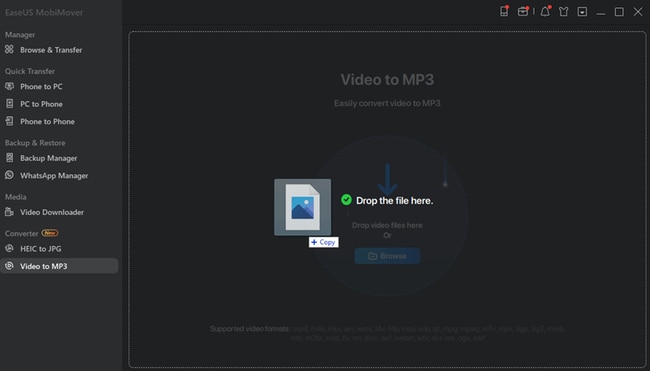
02Freemake Video Converter
Freemake Video Converter is the first 100% FREE MP3 converter for Windows 10 on this list! They keep the software updated from donations, so you can choose how much money you can spare for using the service! It’s a very simple software besides (as is shown in the image below). It does feature some video editing tools, but its main function is conversion (which includes video-to-audio conversion!)
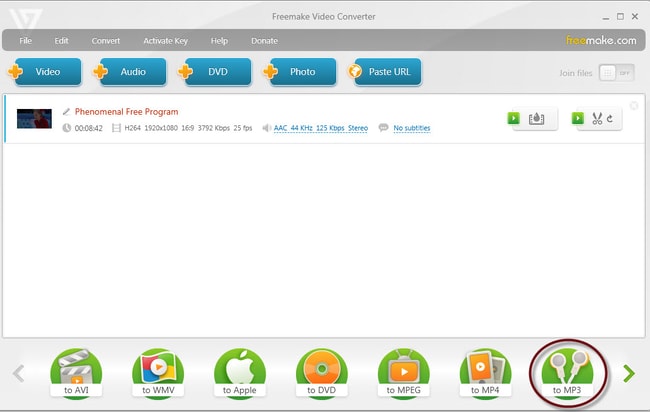
03VSDC
Much like Freemake, our next MP3 converter for Windows 10 and 11, called VSDC, is completely FREE — as they run primarily on donations. That does mean that it’s not the most advanced program though — evident from the rather old-school interface (shown in the image below). But, regardless of the lack of abundance in tools, it should function just fine as an audio-video-converter for Windows 10 (and vice versa.)
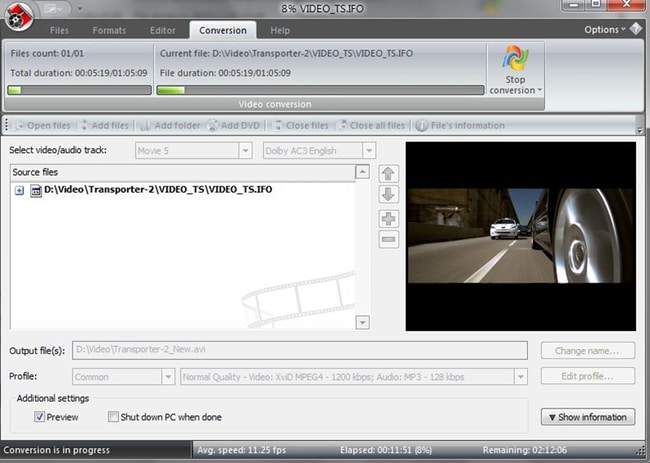
04Convertio.co
With Convertio.co, we break the mold a bit! This is not a software, but it does still work for Windows users — as it requires only that you have a working browser from which you can access the website (URL linked below!) As you can see from the image, it works much like most online MP3 converters — you upload a file from your desktop, wait for it to finish converting, and then download it!

05Free Convert
Free Convert is another online MP3 convert for Windows 10 users that would prefer not to download or install software. And, just like Covertio, it works by uploading the files you want to convert from your computer, waiting for the converters tool to finish converting it, and then downloading the finished product. It is, of course, FREE — but, similar to the first tool on this list, if you want to unlock some of its features, you’ll have to pay for the premium version.
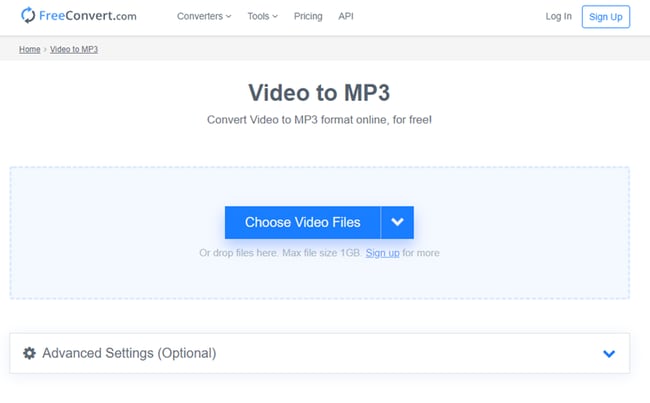
06DVDVideoSoft
With DVDVideoSoft, we’re back to an audio-video converter for Windows 10 that you have to download and install to work! It’s a FREEmium software too. That means that you’ll have to pay in order to unlock certain features. But, it works as a solid converter even without that.
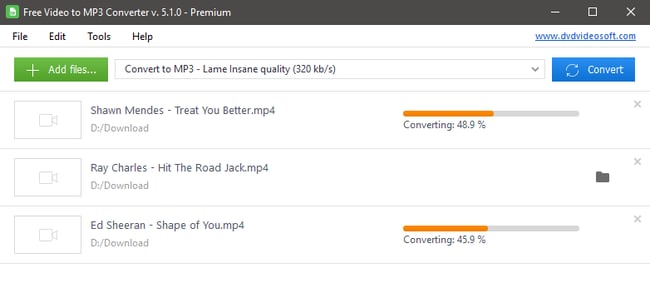
Part 2 6 Best Free and Paid Audio Editor for PC and Mac
For this next section, we turn our attention to a couple of MP3 editors (Windows 10 and Mac compatible.) This list will be a little more detailed than the first, since there are many differences between the tools that we’ll be introducing (both FREE and PAID), but it should give you a clear idea on which would work best for you.
01Wondershare Filmora
Operating System: Windows/Mac
Today’s Best Deals: US$89.99 (one-time)
The first on our list is the MP3 editor Windows 10 and Mac compatible, Wondershare Filmora Video Editor This is an advanced video editing software that you can use in order to work on just about any digital project — including, of course, editing your MP3 audio files.
Reasons to Buy:
● Lots of editing tools for MP3 files
● Exports high-quality end-products
● FREE to try, multiple-packages available
Reasons to Avoid:
● Premium software (subscription/one-time fee)
● Advanced tools might make it harder to get used to
● Download and installation is required
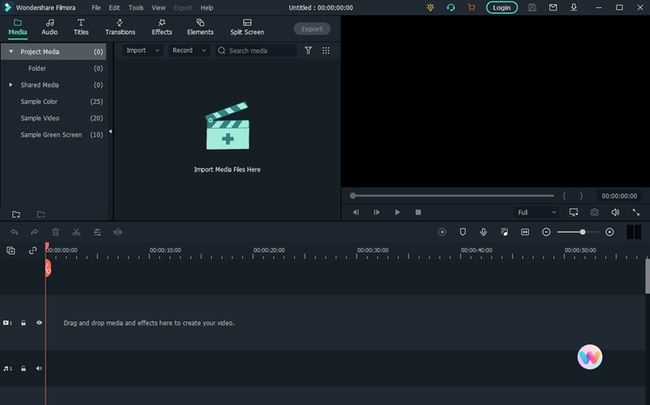
02Audacity
Operating System: Windows/Mac/Linux
Today’s Best Deals: FREE
Audacity is an MP3 editor (Windows 10, Max, and Linux compatible!) The difference between this tool and our first pick, Filmora Pro, is that Audacity is an open-source software — this means that it is free to use, but it also means that it might not be the most reliable as it is not updated quite as often.
Reasons to Buy:
● FREE, open-source software
● Advanced video and audio editing tools
● MP3 trimming/cutting feature
Reasons to Avoid:
● Not updated as often
● Confusing interface
● Difficult to use for beginners
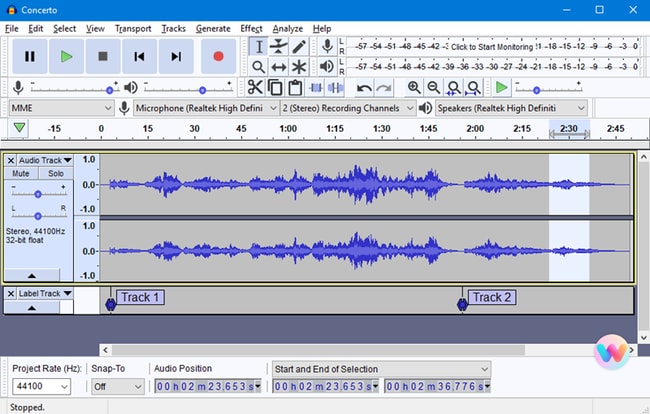
03Ashampoo Music Studio 8
Operating System: Windows
Today’s Best Deals: US$29.99
Next up is Ashampoo’s Music Studio 8! Here’s another freemium software that you can try for free — just to make sure it’s the tool that you’re looking for, but you’ll have to pay a price to use in its entirety! As you can see from the interface (shown in the image below) though, it’s quite the effective MP3 cutter for Windows 10 (among other things). So, if that’s what you’re looking for, then it’s a good choice to consider.
Reasons to Buy:
● Clean, modern interface
● Beginner-friendly editing tools
● One-time fee only
Reasons to Avoid:
● Freemium software (one-time payment required)
● Available only for Windows!
● Cannot support multiple tracks
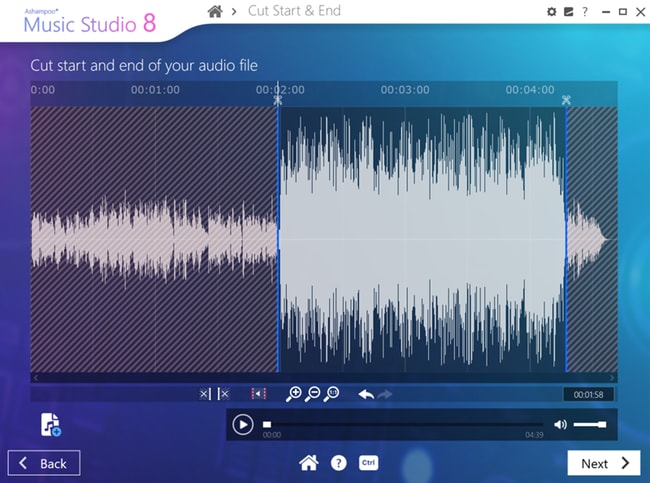
04Ocenaudio
Operating System: Windows/Mac/Linux
Today’s Best Deals: FREE
As far as audio-editing goes, you’re probably going to have a difficult time finding one that is as specialized as Ocenaudio. As you can probably guess from the name, it is, primarily, an audio editing tool. Making it a good choice if that’s all you’re looking for in a software, as it certainly keeps things simpler.
Reasons to Buy:
● Beginner-friendly audio editor
● Simple, clean interface
● Available for Windows/Mac/Linux
Reasons to Avoid:
● Older software
● Open-source, not updated as often
● Only an audio-editing software
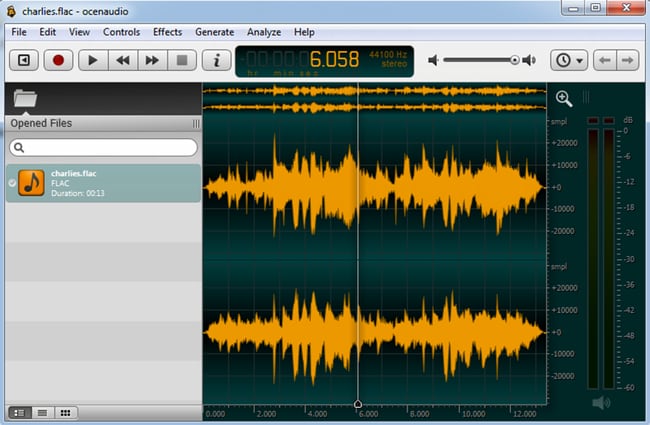
05Acoustica
Operating System: Windows
Today’s Best Deals: FREE
Our next pick is another open-source, MP3 editor for Windows 10. It’s called Acoustica. And, as you can see from the image shared below, it’s a fairly advanced audio editing tool. You should note, however, that the newer versions of this product are PAID (only older models are free), which is the topic of our discussion today.
Reasons to Buy:
● FREE, open-source product
● Advanced audio editing tools
● Advanced exporting formats
Reasons to Avoid:
● Older version of the software
● Updated version is PAID
● Available only for Windows
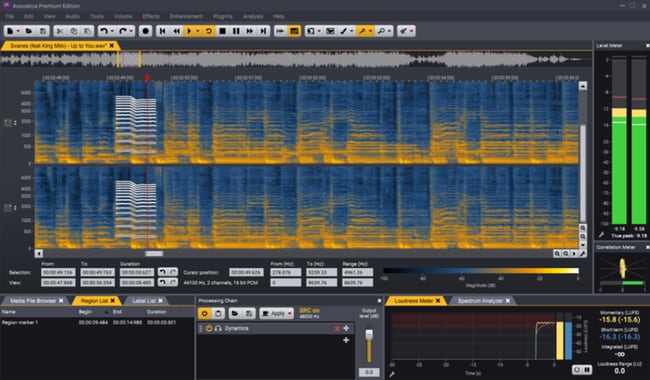
06Audiotool
Operating System: Windows/Mac/Linux
Today’s Best Deals: FREE
Finally, we finish things off with Audiotool, it’s certainly not your traditional audio editor (as is evident from the image shown below). But, the funky interface doesn’t mean that it won’t work for you! You never know, it might be exactly the kind that helps you zoom through your projects more quickly.
Reasons to Buy:
● FREE, open-source software
● Available for Windows/Mac/Linux users
● Advanced audio editing
Reasons to Avoid:
● Complex editing interface
● Requires internet to work (Linux)
● Not regularly updated
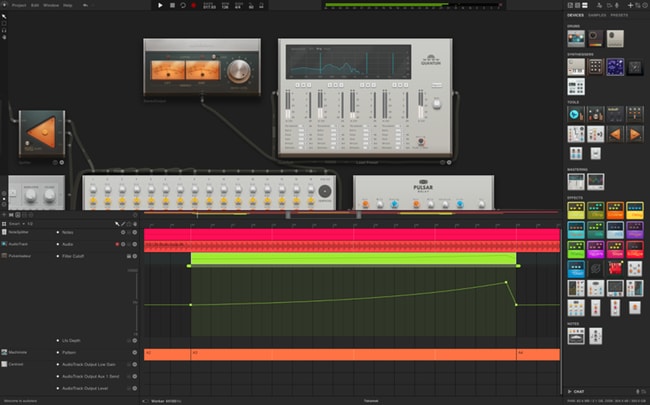
Part 3 5 MP3 Music Players for Windows 10/11 PC
The last of the lists in this article is a short one for the best MP3 players for Windows 10! This is a straightforward list, much like the first. And, we’ll be focusing on MP3 players for Windows 10 only (although some of these will work for Mac as well!)
01iTunes
Despite appearances, iTunes actually makes for a great MP3 player for Windows 10 users. After all, it’s interface is clean and it is regularly updated. So, you never have to deal with bugs! (And just in case you weren’t aware, you can add your own original audio to your iTunes library! So, it isn’t like you have to purchase media from the iTunes store just to listen to it.)

02Groove Music
Groove Music is a local Mp3 player for Windows 10 that you can download from the Microsoft App Store. It functions much like iTunes — in that you can add original music or audio to the app library (as well as purchase audio from the store — if that’s what you want.)
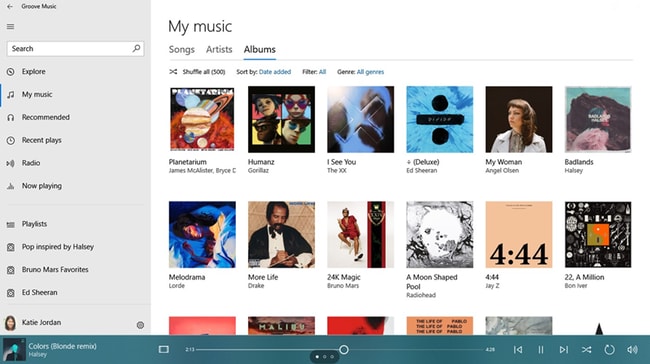
03Macgo Media Player
Our next pick, Macgo, is not strictly an MP3 player for Windows 10, but it can work for that purpose if that’s all you need it for. As a media player though, it does function as a video player as well. And, like our previous picks, it’s FREE so you don’t have to worry about paying in order to use it.
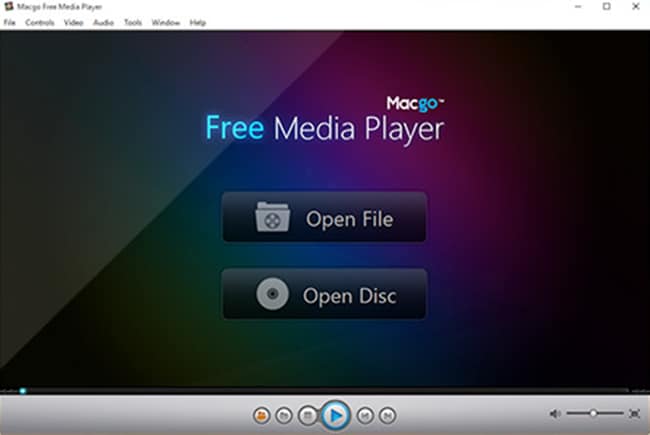
04PowerDVD
Again, our next pick is more of a general media player than strictly a MP3 Player for Windows 10 users, but it works just as well if all you’re looking for is to occasionally play the audio that you’ve converted or trimmed!
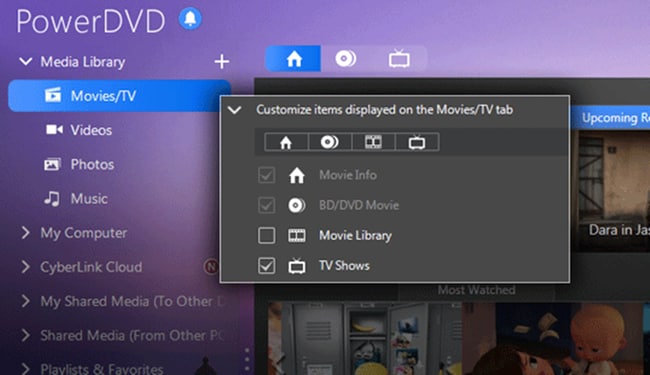
05Musicbee
We’re back to strictly MP3 players for Windows with Musicbee! The best part of this app is, undoubtedly, the fact that it has several view options. So, if you want, you have your audio playing from a mini audio player (rather than the full interface — as is shown below). It’s also useful for organizing your media collection!
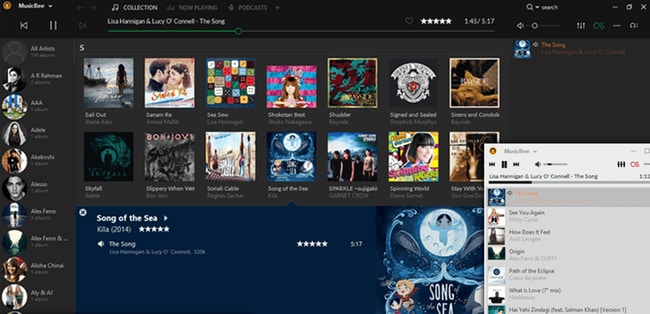
Part 4 How to Trim Mp3 on Windows 10 Easily
For this next part, we’re going to go over how you might go about trimming your converted audio with an MP3 cutter for Windows. (Note, a lot of the audio editors that we introduced in Part 2 of this article should be capable of this! And, they all work in much the same way.)
01Step 1: Launch MP3 Cutter for Windows 10! Start!
First, launch the MP3 cutter for Windows 10 that you downloaded.
For this example, we’ll be using Joyoshare Media Cutter. And, the way to start is to select the “Open” button, which will prompt you to choose which audio you want to cut.
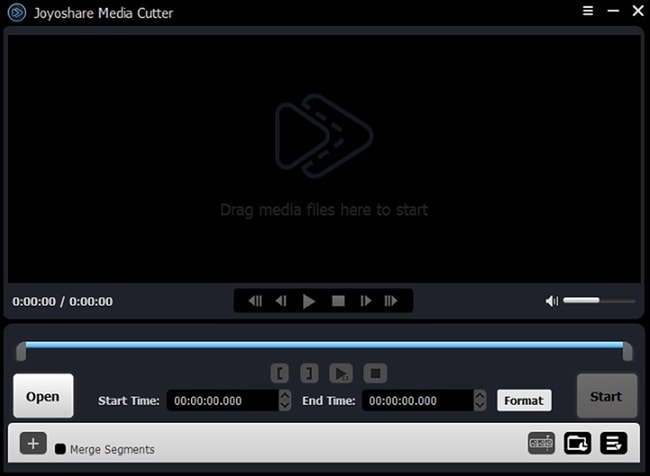
02Step 2: Choose Output Option
Next, select the output format that you want your audio to be exported in. (Most MP3 cutters for Windows 10 offers a variety for you to choose from).
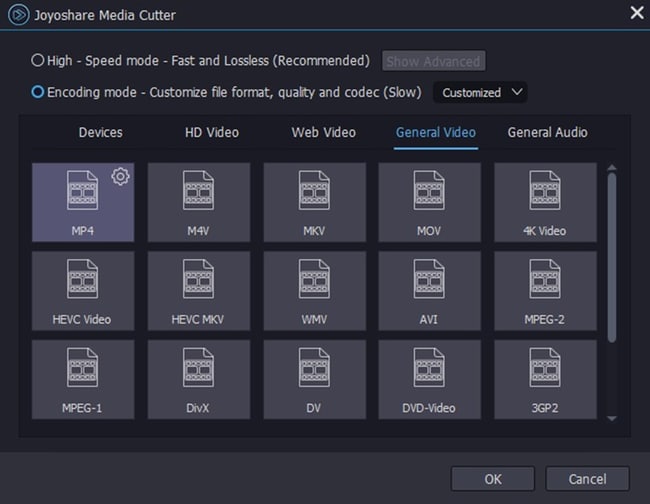
03Step 3: Select and Trim Mode!
Joyoshare has two methods of trimming available. The first is the select and trim mode, which is shown in the image below! For this, you use the sliders provider to select which portion of the audio you want to keep!

04Step 4: Use Encoder Trimmer
If you want a cleaner trim, you click the “Edit” icon beside the audio that you want to trim until you are moved to the encoder window (shown in the image below). This will allow you to pinpoint the best place to cut your audio!
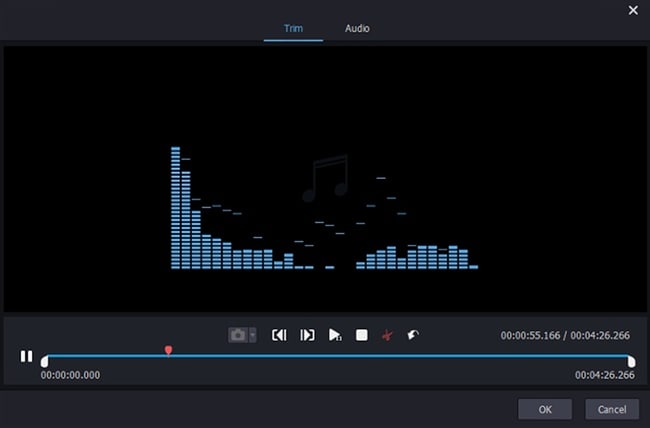
05Step 5: Save Your Audio!
Once you’re done trimming, remember to save!
With Joyoshare, the method of doing this is to select the “Start” button, which will prompt the trimmer to begin cutting the audio.
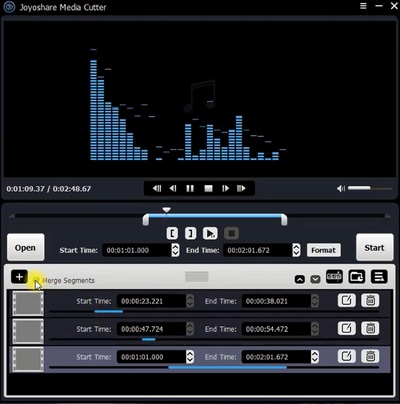
Key Takeaways from This Episode
● There are multiple MP3 converters for Windows and Mac that you can use in order to convert videos to an audio file that you can use for certain projects.
● Of course, if you want your finished project to sound clean, you’ll probably need a functional audio editor for that! And, for this matter, we recommend advanced video editing software like Filmora Pro.
● Just in case you want to review what your converted audio sounds like, consider one of the audio players that are available for Windows and Mac!
● If you find that your audio needs some trimming, a quick trim with an audio cutter should do the trick. It’s very simple to do!
We’ve got you there! In this article, not only have we compiled a list of the best FREE MP3 converters for Windows 10/11.
We’ve also included a list of the best MP3 editor Windows & Mac, and a list for the best MP3 player Windows & Mac! There’s even a quick tutorial in the end that can help you trim MP3 (Windows) files that you’ve converted so that you can more cleanly include it in your own project.
In this article
01 [6 Best Free MP3 Converter for Windows 10 / 11](#Part 1)
02 [6 Best Free and Paid Audio Editor for PC and Mac](#Part 2)
03 [5 MP3 Music Players for Windows 10/11 PC](#Part 3)
04 [How to Trim Mp3 on Windows 10 Easily](#Part 4)
Part 1 6 Best Free MP3 Converter for Windows 10 / 11
As promised, we start this off with the best audio converter (Windows 10/11) tools. We’ve decided to go very simple with this list, providing a brief description of all of the FREE MP3 Converters (Windows), a URL that will lead you to the website where you can get the converter, and an image that should show you how the converter’s interface looks like.
01EaseUs MobiMover
EaseUs MobiMover is an audio converter for Windows 10 and 11 that you can use in order to easily convert videos (in various formats) into MP3 (as is shown in the image below. It’s a FREEmium software though — which means that it’s use is limited until you purchase the paid version of the software.

02Freemake Video Converter
Freemake Video Converter is the first 100% FREE MP3 converter for Windows 10 on this list! They keep the software updated from donations, so you can choose how much money you can spare for using the service! It’s a very simple software besides (as is shown in the image below). It does feature some video editing tools, but its main function is conversion (which includes video-to-audio conversion!)

03VSDC
Much like Freemake, our next MP3 converter for Windows 10 and 11, called VSDC, is completely FREE — as they run primarily on donations. That does mean that it’s not the most advanced program though — evident from the rather old-school interface (shown in the image below). But, regardless of the lack of abundance in tools, it should function just fine as an audio-video-converter for Windows 10 (and vice versa.)

04Convertio.co
With Convertio.co, we break the mold a bit! This is not a software, but it does still work for Windows users — as it requires only that you have a working browser from which you can access the website (URL linked below!) As you can see from the image, it works much like most online MP3 converters — you upload a file from your desktop, wait for it to finish converting, and then download it!

05Free Convert
Free Convert is another online MP3 convert for Windows 10 users that would prefer not to download or install software. And, just like Covertio, it works by uploading the files you want to convert from your computer, waiting for the converters tool to finish converting it, and then downloading the finished product. It is, of course, FREE — but, similar to the first tool on this list, if you want to unlock some of its features, you’ll have to pay for the premium version.

06DVDVideoSoft
With DVDVideoSoft, we’re back to an audio-video converter for Windows 10 that you have to download and install to work! It’s a FREEmium software too. That means that you’ll have to pay in order to unlock certain features. But, it works as a solid converter even without that.

Part 2 6 Best Free and Paid Audio Editor for PC and Mac
For this next section, we turn our attention to a couple of MP3 editors (Windows 10 and Mac compatible.) This list will be a little more detailed than the first, since there are many differences between the tools that we’ll be introducing (both FREE and PAID), but it should give you a clear idea on which would work best for you.
01Wondershare Filmora
Operating System: Windows/Mac
Today’s Best Deals: US$89.99 (one-time)
The first on our list is the MP3 editor Windows 10 and Mac compatible, Wondershare Filmora Video Editor This is an advanced video editing software that you can use in order to work on just about any digital project — including, of course, editing your MP3 audio files.
Reasons to Buy:
● Lots of editing tools for MP3 files
● Exports high-quality end-products
● FREE to try, multiple-packages available
Reasons to Avoid:
● Premium software (subscription/one-time fee)
● Advanced tools might make it harder to get used to
● Download and installation is required

02Audacity
Operating System: Windows/Mac/Linux
Today’s Best Deals: FREE
Audacity is an MP3 editor (Windows 10, Max, and Linux compatible!) The difference between this tool and our first pick, Filmora Pro, is that Audacity is an open-source software — this means that it is free to use, but it also means that it might not be the most reliable as it is not updated quite as often.
Reasons to Buy:
● FREE, open-source software
● Advanced video and audio editing tools
● MP3 trimming/cutting feature
Reasons to Avoid:
● Not updated as often
● Confusing interface
● Difficult to use for beginners

03Ashampoo Music Studio 8
Operating System: Windows
Today’s Best Deals: US$29.99
Next up is Ashampoo’s Music Studio 8! Here’s another freemium software that you can try for free — just to make sure it’s the tool that you’re looking for, but you’ll have to pay a price to use in its entirety! As you can see from the interface (shown in the image below) though, it’s quite the effective MP3 cutter for Windows 10 (among other things). So, if that’s what you’re looking for, then it’s a good choice to consider.
Reasons to Buy:
● Clean, modern interface
● Beginner-friendly editing tools
● One-time fee only
Reasons to Avoid:
● Freemium software (one-time payment required)
● Available only for Windows!
● Cannot support multiple tracks

04Ocenaudio
Operating System: Windows/Mac/Linux
Today’s Best Deals: FREE
As far as audio-editing goes, you’re probably going to have a difficult time finding one that is as specialized as Ocenaudio. As you can probably guess from the name, it is, primarily, an audio editing tool. Making it a good choice if that’s all you’re looking for in a software, as it certainly keeps things simpler.
Reasons to Buy:
● Beginner-friendly audio editor
● Simple, clean interface
● Available for Windows/Mac/Linux
Reasons to Avoid:
● Older software
● Open-source, not updated as often
● Only an audio-editing software

05Acoustica
Operating System: Windows
Today’s Best Deals: FREE
Our next pick is another open-source, MP3 editor for Windows 10. It’s called Acoustica. And, as you can see from the image shared below, it’s a fairly advanced audio editing tool. You should note, however, that the newer versions of this product are PAID (only older models are free), which is the topic of our discussion today.
Reasons to Buy:
● FREE, open-source product
● Advanced audio editing tools
● Advanced exporting formats
Reasons to Avoid:
● Older version of the software
● Updated version is PAID
● Available only for Windows

06Audiotool
Operating System: Windows/Mac/Linux
Today’s Best Deals: FREE
Finally, we finish things off with Audiotool, it’s certainly not your traditional audio editor (as is evident from the image shown below). But, the funky interface doesn’t mean that it won’t work for you! You never know, it might be exactly the kind that helps you zoom through your projects more quickly.
Reasons to Buy:
● FREE, open-source software
● Available for Windows/Mac/Linux users
● Advanced audio editing
Reasons to Avoid:
● Complex editing interface
● Requires internet to work (Linux)
● Not regularly updated

Part 3 5 MP3 Music Players for Windows 10/11 PC
The last of the lists in this article is a short one for the best MP3 players for Windows 10! This is a straightforward list, much like the first. And, we’ll be focusing on MP3 players for Windows 10 only (although some of these will work for Mac as well!)
01iTunes
Despite appearances, iTunes actually makes for a great MP3 player for Windows 10 users. After all, it’s interface is clean and it is regularly updated. So, you never have to deal with bugs! (And just in case you weren’t aware, you can add your own original audio to your iTunes library! So, it isn’t like you have to purchase media from the iTunes store just to listen to it.)

02Groove Music
Groove Music is a local Mp3 player for Windows 10 that you can download from the Microsoft App Store. It functions much like iTunes — in that you can add original music or audio to the app library (as well as purchase audio from the store — if that’s what you want.)

03Macgo Media Player
Our next pick, Macgo, is not strictly an MP3 player for Windows 10, but it can work for that purpose if that’s all you need it for. As a media player though, it does function as a video player as well. And, like our previous picks, it’s FREE so you don’t have to worry about paying in order to use it.

04PowerDVD
Again, our next pick is more of a general media player than strictly a MP3 Player for Windows 10 users, but it works just as well if all you’re looking for is to occasionally play the audio that you’ve converted or trimmed!

05Musicbee
We’re back to strictly MP3 players for Windows with Musicbee! The best part of this app is, undoubtedly, the fact that it has several view options. So, if you want, you have your audio playing from a mini audio player (rather than the full interface — as is shown below). It’s also useful for organizing your media collection!

Part 4 How to Trim Mp3 on Windows 10 Easily
For this next part, we’re going to go over how you might go about trimming your converted audio with an MP3 cutter for Windows. (Note, a lot of the audio editors that we introduced in Part 2 of this article should be capable of this! And, they all work in much the same way.)
01Step 1: Launch MP3 Cutter for Windows 10! Start!
First, launch the MP3 cutter for Windows 10 that you downloaded.
For this example, we’ll be using Joyoshare Media Cutter. And, the way to start is to select the “Open” button, which will prompt you to choose which audio you want to cut.

02Step 2: Choose Output Option
Next, select the output format that you want your audio to be exported in. (Most MP3 cutters for Windows 10 offers a variety for you to choose from).

03Step 3: Select and Trim Mode!
Joyoshare has two methods of trimming available. The first is the select and trim mode, which is shown in the image below! For this, you use the sliders provider to select which portion of the audio you want to keep!

04Step 4: Use Encoder Trimmer
If you want a cleaner trim, you click the “Edit” icon beside the audio that you want to trim until you are moved to the encoder window (shown in the image below). This will allow you to pinpoint the best place to cut your audio!

05Step 5: Save Your Audio!
Once you’re done trimming, remember to save!
With Joyoshare, the method of doing this is to select the “Start” button, which will prompt the trimmer to begin cutting the audio.

Key Takeaways from This Episode
● There are multiple MP3 converters for Windows and Mac that you can use in order to convert videos to an audio file that you can use for certain projects.
● Of course, if you want your finished project to sound clean, you’ll probably need a functional audio editor for that! And, for this matter, we recommend advanced video editing software like Filmora Pro.
● Just in case you want to review what your converted audio sounds like, consider one of the audio players that are available for Windows and Mac!
● If you find that your audio needs some trimming, a quick trim with an audio cutter should do the trick. It’s very simple to do!
We’ve got you there! In this article, not only have we compiled a list of the best FREE MP3 converters for Windows 10/11.
We’ve also included a list of the best MP3 editor Windows & Mac, and a list for the best MP3 player Windows & Mac! There’s even a quick tutorial in the end that can help you trim MP3 (Windows) files that you’ve converted so that you can more cleanly include it in your own project.
In this article
01 [6 Best Free MP3 Converter for Windows 10 / 11](#Part 1)
02 [6 Best Free and Paid Audio Editor for PC and Mac](#Part 2)
03 [5 MP3 Music Players for Windows 10/11 PC](#Part 3)
04 [How to Trim Mp3 on Windows 10 Easily](#Part 4)
Part 1 6 Best Free MP3 Converter for Windows 10 / 11
As promised, we start this off with the best audio converter (Windows 10/11) tools. We’ve decided to go very simple with this list, providing a brief description of all of the FREE MP3 Converters (Windows), a URL that will lead you to the website where you can get the converter, and an image that should show you how the converter’s interface looks like.
01EaseUs MobiMover
EaseUs MobiMover is an audio converter for Windows 10 and 11 that you can use in order to easily convert videos (in various formats) into MP3 (as is shown in the image below. It’s a FREEmium software though — which means that it’s use is limited until you purchase the paid version of the software.

02Freemake Video Converter
Freemake Video Converter is the first 100% FREE MP3 converter for Windows 10 on this list! They keep the software updated from donations, so you can choose how much money you can spare for using the service! It’s a very simple software besides (as is shown in the image below). It does feature some video editing tools, but its main function is conversion (which includes video-to-audio conversion!)

03VSDC
Much like Freemake, our next MP3 converter for Windows 10 and 11, called VSDC, is completely FREE — as they run primarily on donations. That does mean that it’s not the most advanced program though — evident from the rather old-school interface (shown in the image below). But, regardless of the lack of abundance in tools, it should function just fine as an audio-video-converter for Windows 10 (and vice versa.)

04Convertio.co
With Convertio.co, we break the mold a bit! This is not a software, but it does still work for Windows users — as it requires only that you have a working browser from which you can access the website (URL linked below!) As you can see from the image, it works much like most online MP3 converters — you upload a file from your desktop, wait for it to finish converting, and then download it!

05Free Convert
Free Convert is another online MP3 convert for Windows 10 users that would prefer not to download or install software. And, just like Covertio, it works by uploading the files you want to convert from your computer, waiting for the converters tool to finish converting it, and then downloading the finished product. It is, of course, FREE — but, similar to the first tool on this list, if you want to unlock some of its features, you’ll have to pay for the premium version.

06DVDVideoSoft
With DVDVideoSoft, we’re back to an audio-video converter for Windows 10 that you have to download and install to work! It’s a FREEmium software too. That means that you’ll have to pay in order to unlock certain features. But, it works as a solid converter even without that.

Part 2 6 Best Free and Paid Audio Editor for PC and Mac
For this next section, we turn our attention to a couple of MP3 editors (Windows 10 and Mac compatible.) This list will be a little more detailed than the first, since there are many differences between the tools that we’ll be introducing (both FREE and PAID), but it should give you a clear idea on which would work best for you.
01Wondershare Filmora
Operating System: Windows/Mac
Today’s Best Deals: US$89.99 (one-time)
The first on our list is the MP3 editor Windows 10 and Mac compatible, Wondershare Filmora Video Editor This is an advanced video editing software that you can use in order to work on just about any digital project — including, of course, editing your MP3 audio files.
Reasons to Buy:
● Lots of editing tools for MP3 files
● Exports high-quality end-products
● FREE to try, multiple-packages available
Reasons to Avoid:
● Premium software (subscription/one-time fee)
● Advanced tools might make it harder to get used to
● Download and installation is required

02Audacity
Operating System: Windows/Mac/Linux
Today’s Best Deals: FREE
Audacity is an MP3 editor (Windows 10, Max, and Linux compatible!) The difference between this tool and our first pick, Filmora Pro, is that Audacity is an open-source software — this means that it is free to use, but it also means that it might not be the most reliable as it is not updated quite as often.
Reasons to Buy:
● FREE, open-source software
● Advanced video and audio editing tools
● MP3 trimming/cutting feature
Reasons to Avoid:
● Not updated as often
● Confusing interface
● Difficult to use for beginners

03Ashampoo Music Studio 8
Operating System: Windows
Today’s Best Deals: US$29.99
Next up is Ashampoo’s Music Studio 8! Here’s another freemium software that you can try for free — just to make sure it’s the tool that you’re looking for, but you’ll have to pay a price to use in its entirety! As you can see from the interface (shown in the image below) though, it’s quite the effective MP3 cutter for Windows 10 (among other things). So, if that’s what you’re looking for, then it’s a good choice to consider.
Reasons to Buy:
● Clean, modern interface
● Beginner-friendly editing tools
● One-time fee only
Reasons to Avoid:
● Freemium software (one-time payment required)
● Available only for Windows!
● Cannot support multiple tracks

04Ocenaudio
Operating System: Windows/Mac/Linux
Today’s Best Deals: FREE
As far as audio-editing goes, you’re probably going to have a difficult time finding one that is as specialized as Ocenaudio. As you can probably guess from the name, it is, primarily, an audio editing tool. Making it a good choice if that’s all you’re looking for in a software, as it certainly keeps things simpler.
Reasons to Buy:
● Beginner-friendly audio editor
● Simple, clean interface
● Available for Windows/Mac/Linux
Reasons to Avoid:
● Older software
● Open-source, not updated as often
● Only an audio-editing software

05Acoustica
Operating System: Windows
Today’s Best Deals: FREE
Our next pick is another open-source, MP3 editor for Windows 10. It’s called Acoustica. And, as you can see from the image shared below, it’s a fairly advanced audio editing tool. You should note, however, that the newer versions of this product are PAID (only older models are free), which is the topic of our discussion today.
Reasons to Buy:
● FREE, open-source product
● Advanced audio editing tools
● Advanced exporting formats
Reasons to Avoid:
● Older version of the software
● Updated version is PAID
● Available only for Windows

06Audiotool
Operating System: Windows/Mac/Linux
Today’s Best Deals: FREE
Finally, we finish things off with Audiotool, it’s certainly not your traditional audio editor (as is evident from the image shown below). But, the funky interface doesn’t mean that it won’t work for you! You never know, it might be exactly the kind that helps you zoom through your projects more quickly.
Reasons to Buy:
● FREE, open-source software
● Available for Windows/Mac/Linux users
● Advanced audio editing
Reasons to Avoid:
● Complex editing interface
● Requires internet to work (Linux)
● Not regularly updated

Part 3 5 MP3 Music Players for Windows 10/11 PC
The last of the lists in this article is a short one for the best MP3 players for Windows 10! This is a straightforward list, much like the first. And, we’ll be focusing on MP3 players for Windows 10 only (although some of these will work for Mac as well!)
01iTunes
Despite appearances, iTunes actually makes for a great MP3 player for Windows 10 users. After all, it’s interface is clean and it is regularly updated. So, you never have to deal with bugs! (And just in case you weren’t aware, you can add your own original audio to your iTunes library! So, it isn’t like you have to purchase media from the iTunes store just to listen to it.)

02Groove Music
Groove Music is a local Mp3 player for Windows 10 that you can download from the Microsoft App Store. It functions much like iTunes — in that you can add original music or audio to the app library (as well as purchase audio from the store — if that’s what you want.)

03Macgo Media Player
Our next pick, Macgo, is not strictly an MP3 player for Windows 10, but it can work for that purpose if that’s all you need it for. As a media player though, it does function as a video player as well. And, like our previous picks, it’s FREE so you don’t have to worry about paying in order to use it.

04PowerDVD
Again, our next pick is more of a general media player than strictly a MP3 Player for Windows 10 users, but it works just as well if all you’re looking for is to occasionally play the audio that you’ve converted or trimmed!

05Musicbee
We’re back to strictly MP3 players for Windows with Musicbee! The best part of this app is, undoubtedly, the fact that it has several view options. So, if you want, you have your audio playing from a mini audio player (rather than the full interface — as is shown below). It’s also useful for organizing your media collection!

Part 4 How to Trim Mp3 on Windows 10 Easily
For this next part, we’re going to go over how you might go about trimming your converted audio with an MP3 cutter for Windows. (Note, a lot of the audio editors that we introduced in Part 2 of this article should be capable of this! And, they all work in much the same way.)
01Step 1: Launch MP3 Cutter for Windows 10! Start!
First, launch the MP3 cutter for Windows 10 that you downloaded.
For this example, we’ll be using Joyoshare Media Cutter. And, the way to start is to select the “Open” button, which will prompt you to choose which audio you want to cut.

02Step 2: Choose Output Option
Next, select the output format that you want your audio to be exported in. (Most MP3 cutters for Windows 10 offers a variety for you to choose from).

03Step 3: Select and Trim Mode!
Joyoshare has two methods of trimming available. The first is the select and trim mode, which is shown in the image below! For this, you use the sliders provider to select which portion of the audio you want to keep!

04Step 4: Use Encoder Trimmer
If you want a cleaner trim, you click the “Edit” icon beside the audio that you want to trim until you are moved to the encoder window (shown in the image below). This will allow you to pinpoint the best place to cut your audio!

05Step 5: Save Your Audio!
Once you’re done trimming, remember to save!
With Joyoshare, the method of doing this is to select the “Start” button, which will prompt the trimmer to begin cutting the audio.

Key Takeaways from This Episode
● There are multiple MP3 converters for Windows and Mac that you can use in order to convert videos to an audio file that you can use for certain projects.
● Of course, if you want your finished project to sound clean, you’ll probably need a functional audio editor for that! And, for this matter, we recommend advanced video editing software like Filmora Pro.
● Just in case you want to review what your converted audio sounds like, consider one of the audio players that are available for Windows and Mac!
● If you find that your audio needs some trimming, a quick trim with an audio cutter should do the trick. It’s very simple to do!
We’ve got you there! In this article, not only have we compiled a list of the best FREE MP3 converters for Windows 10/11.
We’ve also included a list of the best MP3 editor Windows & Mac, and a list for the best MP3 player Windows & Mac! There’s even a quick tutorial in the end that can help you trim MP3 (Windows) files that you’ve converted so that you can more cleanly include it in your own project.
In this article
01 [6 Best Free MP3 Converter for Windows 10 / 11](#Part 1)
02 [6 Best Free and Paid Audio Editor for PC and Mac](#Part 2)
03 [5 MP3 Music Players for Windows 10/11 PC](#Part 3)
04 [How to Trim Mp3 on Windows 10 Easily](#Part 4)
Part 1 6 Best Free MP3 Converter for Windows 10 / 11
As promised, we start this off with the best audio converter (Windows 10/11) tools. We’ve decided to go very simple with this list, providing a brief description of all of the FREE MP3 Converters (Windows), a URL that will lead you to the website where you can get the converter, and an image that should show you how the converter’s interface looks like.
01EaseUs MobiMover
EaseUs MobiMover is an audio converter for Windows 10 and 11 that you can use in order to easily convert videos (in various formats) into MP3 (as is shown in the image below. It’s a FREEmium software though — which means that it’s use is limited until you purchase the paid version of the software.

02Freemake Video Converter
Freemake Video Converter is the first 100% FREE MP3 converter for Windows 10 on this list! They keep the software updated from donations, so you can choose how much money you can spare for using the service! It’s a very simple software besides (as is shown in the image below). It does feature some video editing tools, but its main function is conversion (which includes video-to-audio conversion!)

03VSDC
Much like Freemake, our next MP3 converter for Windows 10 and 11, called VSDC, is completely FREE — as they run primarily on donations. That does mean that it’s not the most advanced program though — evident from the rather old-school interface (shown in the image below). But, regardless of the lack of abundance in tools, it should function just fine as an audio-video-converter for Windows 10 (and vice versa.)

04Convertio.co
With Convertio.co, we break the mold a bit! This is not a software, but it does still work for Windows users — as it requires only that you have a working browser from which you can access the website (URL linked below!) As you can see from the image, it works much like most online MP3 converters — you upload a file from your desktop, wait for it to finish converting, and then download it!

05Free Convert
Free Convert is another online MP3 convert for Windows 10 users that would prefer not to download or install software. And, just like Covertio, it works by uploading the files you want to convert from your computer, waiting for the converters tool to finish converting it, and then downloading the finished product. It is, of course, FREE — but, similar to the first tool on this list, if you want to unlock some of its features, you’ll have to pay for the premium version.

06DVDVideoSoft
With DVDVideoSoft, we’re back to an audio-video converter for Windows 10 that you have to download and install to work! It’s a FREEmium software too. That means that you’ll have to pay in order to unlock certain features. But, it works as a solid converter even without that.

Part 2 6 Best Free and Paid Audio Editor for PC and Mac
For this next section, we turn our attention to a couple of MP3 editors (Windows 10 and Mac compatible.) This list will be a little more detailed than the first, since there are many differences between the tools that we’ll be introducing (both FREE and PAID), but it should give you a clear idea on which would work best for you.
01Wondershare Filmora
Operating System: Windows/Mac
Today’s Best Deals: US$89.99 (one-time)
The first on our list is the MP3 editor Windows 10 and Mac compatible, Wondershare Filmora Video Editor This is an advanced video editing software that you can use in order to work on just about any digital project — including, of course, editing your MP3 audio files.
Reasons to Buy:
● Lots of editing tools for MP3 files
● Exports high-quality end-products
● FREE to try, multiple-packages available
Reasons to Avoid:
● Premium software (subscription/one-time fee)
● Advanced tools might make it harder to get used to
● Download and installation is required

02Audacity
Operating System: Windows/Mac/Linux
Today’s Best Deals: FREE
Audacity is an MP3 editor (Windows 10, Max, and Linux compatible!) The difference between this tool and our first pick, Filmora Pro, is that Audacity is an open-source software — this means that it is free to use, but it also means that it might not be the most reliable as it is not updated quite as often.
Reasons to Buy:
● FREE, open-source software
● Advanced video and audio editing tools
● MP3 trimming/cutting feature
Reasons to Avoid:
● Not updated as often
● Confusing interface
● Difficult to use for beginners

03Ashampoo Music Studio 8
Operating System: Windows
Today’s Best Deals: US$29.99
Next up is Ashampoo’s Music Studio 8! Here’s another freemium software that you can try for free — just to make sure it’s the tool that you’re looking for, but you’ll have to pay a price to use in its entirety! As you can see from the interface (shown in the image below) though, it’s quite the effective MP3 cutter for Windows 10 (among other things). So, if that’s what you’re looking for, then it’s a good choice to consider.
Reasons to Buy:
● Clean, modern interface
● Beginner-friendly editing tools
● One-time fee only
Reasons to Avoid:
● Freemium software (one-time payment required)
● Available only for Windows!
● Cannot support multiple tracks

04Ocenaudio
Operating System: Windows/Mac/Linux
Today’s Best Deals: FREE
As far as audio-editing goes, you’re probably going to have a difficult time finding one that is as specialized as Ocenaudio. As you can probably guess from the name, it is, primarily, an audio editing tool. Making it a good choice if that’s all you’re looking for in a software, as it certainly keeps things simpler.
Reasons to Buy:
● Beginner-friendly audio editor
● Simple, clean interface
● Available for Windows/Mac/Linux
Reasons to Avoid:
● Older software
● Open-source, not updated as often
● Only an audio-editing software

05Acoustica
Operating System: Windows
Today’s Best Deals: FREE
Our next pick is another open-source, MP3 editor for Windows 10. It’s called Acoustica. And, as you can see from the image shared below, it’s a fairly advanced audio editing tool. You should note, however, that the newer versions of this product are PAID (only older models are free), which is the topic of our discussion today.
Reasons to Buy:
● FREE, open-source product
● Advanced audio editing tools
● Advanced exporting formats
Reasons to Avoid:
● Older version of the software
● Updated version is PAID
● Available only for Windows

06Audiotool
Operating System: Windows/Mac/Linux
Today’s Best Deals: FREE
Finally, we finish things off with Audiotool, it’s certainly not your traditional audio editor (as is evident from the image shown below). But, the funky interface doesn’t mean that it won’t work for you! You never know, it might be exactly the kind that helps you zoom through your projects more quickly.
Reasons to Buy:
● FREE, open-source software
● Available for Windows/Mac/Linux users
● Advanced audio editing
Reasons to Avoid:
● Complex editing interface
● Requires internet to work (Linux)
● Not regularly updated

Part 3 5 MP3 Music Players for Windows 10/11 PC
The last of the lists in this article is a short one for the best MP3 players for Windows 10! This is a straightforward list, much like the first. And, we’ll be focusing on MP3 players for Windows 10 only (although some of these will work for Mac as well!)
01iTunes
Despite appearances, iTunes actually makes for a great MP3 player for Windows 10 users. After all, it’s interface is clean and it is regularly updated. So, you never have to deal with bugs! (And just in case you weren’t aware, you can add your own original audio to your iTunes library! So, it isn’t like you have to purchase media from the iTunes store just to listen to it.)

02Groove Music
Groove Music is a local Mp3 player for Windows 10 that you can download from the Microsoft App Store. It functions much like iTunes — in that you can add original music or audio to the app library (as well as purchase audio from the store — if that’s what you want.)

03Macgo Media Player
Our next pick, Macgo, is not strictly an MP3 player for Windows 10, but it can work for that purpose if that’s all you need it for. As a media player though, it does function as a video player as well. And, like our previous picks, it’s FREE so you don’t have to worry about paying in order to use it.

04PowerDVD
Again, our next pick is more of a general media player than strictly a MP3 Player for Windows 10 users, but it works just as well if all you’re looking for is to occasionally play the audio that you’ve converted or trimmed!

05Musicbee
We’re back to strictly MP3 players for Windows with Musicbee! The best part of this app is, undoubtedly, the fact that it has several view options. So, if you want, you have your audio playing from a mini audio player (rather than the full interface — as is shown below). It’s also useful for organizing your media collection!

Part 4 How to Trim Mp3 on Windows 10 Easily
For this next part, we’re going to go over how you might go about trimming your converted audio with an MP3 cutter for Windows. (Note, a lot of the audio editors that we introduced in Part 2 of this article should be capable of this! And, they all work in much the same way.)
01Step 1: Launch MP3 Cutter for Windows 10! Start!
First, launch the MP3 cutter for Windows 10 that you downloaded.
For this example, we’ll be using Joyoshare Media Cutter. And, the way to start is to select the “Open” button, which will prompt you to choose which audio you want to cut.

02Step 2: Choose Output Option
Next, select the output format that you want your audio to be exported in. (Most MP3 cutters for Windows 10 offers a variety for you to choose from).

03Step 3: Select and Trim Mode!
Joyoshare has two methods of trimming available. The first is the select and trim mode, which is shown in the image below! For this, you use the sliders provider to select which portion of the audio you want to keep!

04Step 4: Use Encoder Trimmer
If you want a cleaner trim, you click the “Edit” icon beside the audio that you want to trim until you are moved to the encoder window (shown in the image below). This will allow you to pinpoint the best place to cut your audio!

05Step 5: Save Your Audio!
Once you’re done trimming, remember to save!
With Joyoshare, the method of doing this is to select the “Start” button, which will prompt the trimmer to begin cutting the audio.

Key Takeaways from This Episode
● There are multiple MP3 converters for Windows and Mac that you can use in order to convert videos to an audio file that you can use for certain projects.
● Of course, if you want your finished project to sound clean, you’ll probably need a functional audio editor for that! And, for this matter, we recommend advanced video editing software like Filmora Pro.
● Just in case you want to review what your converted audio sounds like, consider one of the audio players that are available for Windows and Mac!
● If you find that your audio needs some trimming, a quick trim with an audio cutter should do the trick. It’s very simple to do!
Analyze and Align Image Ratios
You might have noticed that earlier DVDs came with full screen or widescreen viewing choices. Moreover, when you choose the wrong option, it cuts off the movie parts, or the video gets surrounded by black padding.
The standard resolution of your screen stretched from a 4:3 aspect ratio to the wider one. So, producers started making movies that fit on both screens. After the standardization of aspect ratio display, broadcasters pay attention to the image ratio of clips.
So, below is the guide to find, calculate and adjust image ratio with a picture ratio calculator. Let’s get started.
In this article
01 [What is the image ratio?](#Part 1)
02 [Where Can I Find the Image ratio?](#Part 2)
03 [How to adjust image ratio](#Part 3)
Part 1 What is the image ratio?
The image or aspect ratio is the ratio of width to the height of a picture without any pixels attached. It is expressed with two a colon that separates two numbers, for example, 16:9.
In cinematography, common image ratios are 1.85:1 and 2.39:1, and in TV photography, it is 4:3 and 16:9. However, in still photography, the standard aspect ratio is 3:2.
Part 2 Where Can I Find the Image ratio?
To select the right photo print size, you must consider the photo ratio and the print ratio. You can not accidentally choose the balance that needs cropping from the sides of the photo.
So, first, you must know how or where you can find the image ratio. The following are the methods to do so:
Method 1: Check your Camera
The image ratio depends directly on the camera’s sensor. You can find the correct balance for photo print based on your camera type. For example, APS-C and Full-frame cameras shoot in a 3:2 ratio. But compact cameras often shoot in a 4:3 ratio.
The photos that you click with your smartphones have a 16:9 or 4:3 ratio. The picture below shows some common photo ratios by type of camera and where it will look great in the home.

Method 2: Find Image Information
Unlike the photo ratios, image information determines the original width and height of the image in pixels. You can measure the picture dimensions in any unit, but you will always see the web or digital images in pixels.
Always remember that two different pictures with the same image ratio may not have the same dimensions. For example, a picture with size 1920X1080 pixels and a photo with size 1280x720 pixels can both have a 16:9 aspect ratio.
Method 3: Check with Photoshop
You can quickly check the image ratio in Photoshop (picture ratio calculator) using a crop tool. To do so, follow the steps mentioned below:
● Open the image in Photoshop.
● Choose a crop tool.
● Select the photo ratio.
● Test different image ratios. You can begin with the standard ratios like 3:2, 16:9, 4:3, or 5:4.
● If the crop frame captures the whole picture, it means you have already found the correct ratio.
Do you want a photo print in panorama or square shape? If yes, crop the picture to make it fit a different image ratio. For instance, edit the photo to fit a 1:1 ratio for a square shape.
Or crop a picture to 2:1. 3:1. 4:1, 5:1, or 6:1 ratio for a panorama photo.

Method 4: Image Ratio Calculation
You can find the image ratio using the resolution of a photo easily on a window’s system. To do so, right-click on an image file and scroll down to the Properties. Under details, you will notice, size of a photo in pixels.
To calculate the photo ratio, divide the width by the height of an image. If the total is an integer, multiply it by other numbers. These numbers are photo ratios.
Example 1:
● Photo is 4966px by 3312px
● Divide 4966 by 3312= 1.5
● Now, multiply 1.5 with 2 to obtain a whole number (1.5 X 2= 3)
● The photo’s ratio is 3:2
Example 2:
● Photo is 4416 x 3312 px
● Divide 4416 by 3312= 1.3
● Multiply 1.3 with 3 to obtain a whole number(1.3 x 3= 3.9 or approx. 4)
● The photo’s ratio is 4:3
Part 3 How to adjust image ratio
Image ratio is significant in the videography business. But adjusting the video aspect ratio is more critical. Therefore, if you are a video editor, you must know how to do it. There are plenty of options to adjust the aspect ratio, and one of them is to use a photo aspect ratio calculator.
If you want to make permanent adjustments, use a convertor or editor. “Wondershare Filmora” is the best video editor that allows you to create videos with different aspect ratios and adjust these ratios easily.

Wondershare Filmora - Best Video Editor for Mac/Windows
5,481,435 people have downloaded it.
Build unique custom animations without breaking a sweat.
Focus on creating epic stories and leave the details to Filmora’s auto features.
Start a creative adventure with drag & drop effects and endless possibilities.
Filmora simplifies advanced features to save you time and effort.
Filmora cuts out repetition so you can move on to your next creative breakthrough.
The following are different methods to adjust the aspect ratio in Wondershare Filmora:
Method 1: Adjust Aspect Ratio at the Starting Interface
Wondershare Filmora helps you to adjust the video aspect ratio once you launch the editor program. To begin, go to the “drop-down” menu button. Now, press on it to check some commonly used photo ratios such as 16:9, 1:1, 4:3, 9:16, or 21:9.
Choose the ratio that you want by simply clicking on it.

Method 2: Adjust Aspect Ratio under Project Settings
You can adjust the aspect ratio by clicking on the “Project Settings.” Then, decide the target aspect ratio depending on the aspect ratio of the media source.
For instance, if the aspect ratio of media source files is 4:3, select the standard aspect ratio of 4:3. Then, media files with other aspect ratios will shoe black bars.
So, if any discordance occurs or you want to change the video aspect ratio, select the proper balance from project settings.

Method 3: Adjust Aspect Ratio during Editing
Once you import the videos into the timeline of the Wondershare Filmora, you can easily adjust the ratio from the Crop and Zoom tool.
● Go to timeline and right-click on the video clip. Then, select “Crop and Zoom.” You will see the pop-up window.
● Click on 16:9, 4:3, 1:1, or 9:16 manually at the bottom to change the video aspect ratio.
● You can also manually enter the video aspect ratio. Then, click on the “Ok” button.

Once you make the adjustments in the aspect ratio, add background blur effects if you notice a black bar. It will enhance the video. You can also intensify your video by using filters, visual effects, overlays, or titles.

Method 4: Adjust Video Aspect Ratio with Auto-Reframe
If you use the latest versions of Filmora, you will see Auto Reframe helps adjust the aspect ratio. Other
Wondershare Filmora
Get started easily with Filmora’s powerful performance, intuitive interface, and countless effects!
Try It Free Try It Free Try It Free Learn More about Filmora>

The following are steps to change the aspect ratio using the Auto-Reframe option:
Step1
Once you upload the video clips to the media library, right-click on it and select the Auto-Reframe option.

Step2
You will see the Auto Reframe window appear on the screen. Replace the existing video with a new clip. Then, change the video aspect ratio and video motion speed. Make sure to change the aspect ratio that fits most with different social media platforms.

Step3
Once you select the aspect ratio, click on the “Analyze” button. Filmora will Auto-Reframe the video itself. Once the process completes, you can see results in the preview window. Drag box to adjust the frame or to keep the object in it. It will automatically delete the content outside the box.

Step4
After completing adjustment or reframing, click on the “Export” button to save your video.
Change the name of the video and select the location where you want to save the video.
Now, click on the “Export” again to save.

Method 5: Adjust Aspect Ratio at Exporting
You can save the clip to your system or smartphones, depending on your requirements. Then, upload them directly to Youtube or burn them into DVD by clicking on the “Export button.” In this way, you can watch it on widescreen or standard TV whenever you want with an image size aspect ratio calculator.

● Adjust Aspect Ratio for the Local Computer
First, you will see the “Local” tab. There you can save the clip in a particular aspect ratio to your system. You can see all resolutions with various aspect ratios after selecting the format. The output video depends on the media click resolution.
● Adjust Aspect Ratio for a Device
Change the “Device” tab to save the video in formats compatible with popular devices, including iPod, iPhone, PSP, iPad, etc. Choose your favorite or the best resolution. Once you choose the device, you will see all resolutions.
The video quality will continue improving with higher resolutions. But it will also increase the size of the file.
● Adjust Aspect Ratio for YouTube
Go to the “YouTube” tab and fill in the information. Then, click the “Export” button. Selecting the aspect ratio again is not necessary. It will directly upload your videos to YouTube.
● Adjust Aspect Ratio for DVD TV
When you go to the “DVD” tab, you will notice various aspect ratio options. Switching the aspect ratio for TV from 4:3 to 16:9 is pretty straightforward. To do so, select what you think is right. Try to use image size aspect ratio calculator to get the right ratio.
Conclusion
● Aspect ratio holds great importance in the proper display. So, it would be best to learn the calculation and adjustment of the image ratio using photo aspect ratio calculator or image size proportion calculator.
● Hopefully, the above points will help you to learn calculation and adjustment processes. Also, do not forget to use Wondersahe Filmora to set the image ratio and edit the video with ease.
02 [Where Can I Find the Image ratio?](#Part 2)
03 [How to adjust image ratio](#Part 3)
Part 1 What is the image ratio?
The image or aspect ratio is the ratio of width to the height of a picture without any pixels attached. It is expressed with two a colon that separates two numbers, for example, 16:9.
In cinematography, common image ratios are 1.85:1 and 2.39:1, and in TV photography, it is 4:3 and 16:9. However, in still photography, the standard aspect ratio is 3:2.
Part 2 Where Can I Find the Image ratio?
To select the right photo print size, you must consider the photo ratio and the print ratio. You can not accidentally choose the balance that needs cropping from the sides of the photo.
So, first, you must know how or where you can find the image ratio. The following are the methods to do so:
Method 1: Check your Camera
The image ratio depends directly on the camera’s sensor. You can find the correct balance for photo print based on your camera type. For example, APS-C and Full-frame cameras shoot in a 3:2 ratio. But compact cameras often shoot in a 4:3 ratio.
The photos that you click with your smartphones have a 16:9 or 4:3 ratio. The picture below shows some common photo ratios by type of camera and where it will look great in the home.

Method 2: Find Image Information
Unlike the photo ratios, image information determines the original width and height of the image in pixels. You can measure the picture dimensions in any unit, but you will always see the web or digital images in pixels.
Always remember that two different pictures with the same image ratio may not have the same dimensions. For example, a picture with size 1920X1080 pixels and a photo with size 1280x720 pixels can both have a 16:9 aspect ratio.
Method 3: Check with Photoshop
You can quickly check the image ratio in Photoshop (picture ratio calculator) using a crop tool. To do so, follow the steps mentioned below:
● Open the image in Photoshop.
● Choose a crop tool.
● Select the photo ratio.
● Test different image ratios. You can begin with the standard ratios like 3:2, 16:9, 4:3, or 5:4.
● If the crop frame captures the whole picture, it means you have already found the correct ratio.
Do you want a photo print in panorama or square shape? If yes, crop the picture to make it fit a different image ratio. For instance, edit the photo to fit a 1:1 ratio for a square shape.
Or crop a picture to 2:1. 3:1. 4:1, 5:1, or 6:1 ratio for a panorama photo.

Method 4: Image Ratio Calculation
You can find the image ratio using the resolution of a photo easily on a window’s system. To do so, right-click on an image file and scroll down to the Properties. Under details, you will notice, size of a photo in pixels.
To calculate the photo ratio, divide the width by the height of an image. If the total is an integer, multiply it by other numbers. These numbers are photo ratios.
Example 1:
● Photo is 4966px by 3312px
● Divide 4966 by 3312= 1.5
● Now, multiply 1.5 with 2 to obtain a whole number (1.5 X 2= 3)
● The photo’s ratio is 3:2
Example 2:
● Photo is 4416 x 3312 px
● Divide 4416 by 3312= 1.3
● Multiply 1.3 with 3 to obtain a whole number(1.3 x 3= 3.9 or approx. 4)
● The photo’s ratio is 4:3
Part 3 How to adjust image ratio
Image ratio is significant in the videography business. But adjusting the video aspect ratio is more critical. Therefore, if you are a video editor, you must know how to do it. There are plenty of options to adjust the aspect ratio, and one of them is to use a photo aspect ratio calculator.
If you want to make permanent adjustments, use a convertor or editor. “Wondershare Filmora” is the best video editor that allows you to create videos with different aspect ratios and adjust these ratios easily.

Wondershare Filmora - Best Video Editor for Mac/Windows
5,481,435 people have downloaded it.
Build unique custom animations without breaking a sweat.
Focus on creating epic stories and leave the details to Filmora’s auto features.
Start a creative adventure with drag & drop effects and endless possibilities.
Filmora simplifies advanced features to save you time and effort.
Filmora cuts out repetition so you can move on to your next creative breakthrough.
The following are different methods to adjust the aspect ratio in Wondershare Filmora:
Method 1: Adjust Aspect Ratio at the Starting Interface
Wondershare Filmora helps you to adjust the video aspect ratio once you launch the editor program. To begin, go to the “drop-down” menu button. Now, press on it to check some commonly used photo ratios such as 16:9, 1:1, 4:3, 9:16, or 21:9.
Choose the ratio that you want by simply clicking on it.

Method 2: Adjust Aspect Ratio under Project Settings
You can adjust the aspect ratio by clicking on the “Project Settings.” Then, decide the target aspect ratio depending on the aspect ratio of the media source.
For instance, if the aspect ratio of media source files is 4:3, select the standard aspect ratio of 4:3. Then, media files with other aspect ratios will shoe black bars.
So, if any discordance occurs or you want to change the video aspect ratio, select the proper balance from project settings.

Method 3: Adjust Aspect Ratio during Editing
Once you import the videos into the timeline of the Wondershare Filmora, you can easily adjust the ratio from the Crop and Zoom tool.
● Go to timeline and right-click on the video clip. Then, select “Crop and Zoom.” You will see the pop-up window.
● Click on 16:9, 4:3, 1:1, or 9:16 manually at the bottom to change the video aspect ratio.
● You can also manually enter the video aspect ratio. Then, click on the “Ok” button.

Once you make the adjustments in the aspect ratio, add background blur effects if you notice a black bar. It will enhance the video. You can also intensify your video by using filters, visual effects, overlays, or titles.

Method 4: Adjust Video Aspect Ratio with Auto-Reframe
If you use the latest versions of Filmora, you will see Auto Reframe helps adjust the aspect ratio. Other
Wondershare Filmora
Get started easily with Filmora’s powerful performance, intuitive interface, and countless effects!
Try It Free Try It Free Try It Free Learn More about Filmora>

The following are steps to change the aspect ratio using the Auto-Reframe option:
Step1
Once you upload the video clips to the media library, right-click on it and select the Auto-Reframe option.

Step2
You will see the Auto Reframe window appear on the screen. Replace the existing video with a new clip. Then, change the video aspect ratio and video motion speed. Make sure to change the aspect ratio that fits most with different social media platforms.

Step3
Once you select the aspect ratio, click on the “Analyze” button. Filmora will Auto-Reframe the video itself. Once the process completes, you can see results in the preview window. Drag box to adjust the frame or to keep the object in it. It will automatically delete the content outside the box.

Step4
After completing adjustment or reframing, click on the “Export” button to save your video.
Change the name of the video and select the location where you want to save the video.
Now, click on the “Export” again to save.

Method 5: Adjust Aspect Ratio at Exporting
You can save the clip to your system or smartphones, depending on your requirements. Then, upload them directly to Youtube or burn them into DVD by clicking on the “Export button.” In this way, you can watch it on widescreen or standard TV whenever you want with an image size aspect ratio calculator.

● Adjust Aspect Ratio for the Local Computer
First, you will see the “Local” tab. There you can save the clip in a particular aspect ratio to your system. You can see all resolutions with various aspect ratios after selecting the format. The output video depends on the media click resolution.
● Adjust Aspect Ratio for a Device
Change the “Device” tab to save the video in formats compatible with popular devices, including iPod, iPhone, PSP, iPad, etc. Choose your favorite or the best resolution. Once you choose the device, you will see all resolutions.
The video quality will continue improving with higher resolutions. But it will also increase the size of the file.
● Adjust Aspect Ratio for YouTube
Go to the “YouTube” tab and fill in the information. Then, click the “Export” button. Selecting the aspect ratio again is not necessary. It will directly upload your videos to YouTube.
● Adjust Aspect Ratio for DVD TV
When you go to the “DVD” tab, you will notice various aspect ratio options. Switching the aspect ratio for TV from 4:3 to 16:9 is pretty straightforward. To do so, select what you think is right. Try to use image size aspect ratio calculator to get the right ratio.
Conclusion
● Aspect ratio holds great importance in the proper display. So, it would be best to learn the calculation and adjustment of the image ratio using photo aspect ratio calculator or image size proportion calculator.
● Hopefully, the above points will help you to learn calculation and adjustment processes. Also, do not forget to use Wondersahe Filmora to set the image ratio and edit the video with ease.
02 [Where Can I Find the Image ratio?](#Part 2)
03 [How to adjust image ratio](#Part 3)
Part 1 What is the image ratio?
The image or aspect ratio is the ratio of width to the height of a picture without any pixels attached. It is expressed with two a colon that separates two numbers, for example, 16:9.
In cinematography, common image ratios are 1.85:1 and 2.39:1, and in TV photography, it is 4:3 and 16:9. However, in still photography, the standard aspect ratio is 3:2.
Part 2 Where Can I Find the Image ratio?
To select the right photo print size, you must consider the photo ratio and the print ratio. You can not accidentally choose the balance that needs cropping from the sides of the photo.
So, first, you must know how or where you can find the image ratio. The following are the methods to do so:
Method 1: Check your Camera
The image ratio depends directly on the camera’s sensor. You can find the correct balance for photo print based on your camera type. For example, APS-C and Full-frame cameras shoot in a 3:2 ratio. But compact cameras often shoot in a 4:3 ratio.
The photos that you click with your smartphones have a 16:9 or 4:3 ratio. The picture below shows some common photo ratios by type of camera and where it will look great in the home.

Method 2: Find Image Information
Unlike the photo ratios, image information determines the original width and height of the image in pixels. You can measure the picture dimensions in any unit, but you will always see the web or digital images in pixels.
Always remember that two different pictures with the same image ratio may not have the same dimensions. For example, a picture with size 1920X1080 pixels and a photo with size 1280x720 pixels can both have a 16:9 aspect ratio.
Method 3: Check with Photoshop
You can quickly check the image ratio in Photoshop (picture ratio calculator) using a crop tool. To do so, follow the steps mentioned below:
● Open the image in Photoshop.
● Choose a crop tool.
● Select the photo ratio.
● Test different image ratios. You can begin with the standard ratios like 3:2, 16:9, 4:3, or 5:4.
● If the crop frame captures the whole picture, it means you have already found the correct ratio.
Do you want a photo print in panorama or square shape? If yes, crop the picture to make it fit a different image ratio. For instance, edit the photo to fit a 1:1 ratio for a square shape.
Or crop a picture to 2:1. 3:1. 4:1, 5:1, or 6:1 ratio for a panorama photo.

Method 4: Image Ratio Calculation
You can find the image ratio using the resolution of a photo easily on a window’s system. To do so, right-click on an image file and scroll down to the Properties. Under details, you will notice, size of a photo in pixels.
To calculate the photo ratio, divide the width by the height of an image. If the total is an integer, multiply it by other numbers. These numbers are photo ratios.
Example 1:
● Photo is 4966px by 3312px
● Divide 4966 by 3312= 1.5
● Now, multiply 1.5 with 2 to obtain a whole number (1.5 X 2= 3)
● The photo’s ratio is 3:2
Example 2:
● Photo is 4416 x 3312 px
● Divide 4416 by 3312= 1.3
● Multiply 1.3 with 3 to obtain a whole number(1.3 x 3= 3.9 or approx. 4)
● The photo’s ratio is 4:3
Part 3 How to adjust image ratio
Image ratio is significant in the videography business. But adjusting the video aspect ratio is more critical. Therefore, if you are a video editor, you must know how to do it. There are plenty of options to adjust the aspect ratio, and one of them is to use a photo aspect ratio calculator.
If you want to make permanent adjustments, use a convertor or editor. “Wondershare Filmora” is the best video editor that allows you to create videos with different aspect ratios and adjust these ratios easily.

Wondershare Filmora - Best Video Editor for Mac/Windows
5,481,435 people have downloaded it.
Build unique custom animations without breaking a sweat.
Focus on creating epic stories and leave the details to Filmora’s auto features.
Start a creative adventure with drag & drop effects and endless possibilities.
Filmora simplifies advanced features to save you time and effort.
Filmora cuts out repetition so you can move on to your next creative breakthrough.
The following are different methods to adjust the aspect ratio in Wondershare Filmora:
Method 1: Adjust Aspect Ratio at the Starting Interface
Wondershare Filmora helps you to adjust the video aspect ratio once you launch the editor program. To begin, go to the “drop-down” menu button. Now, press on it to check some commonly used photo ratios such as 16:9, 1:1, 4:3, 9:16, or 21:9.
Choose the ratio that you want by simply clicking on it.

Method 2: Adjust Aspect Ratio under Project Settings
You can adjust the aspect ratio by clicking on the “Project Settings.” Then, decide the target aspect ratio depending on the aspect ratio of the media source.
For instance, if the aspect ratio of media source files is 4:3, select the standard aspect ratio of 4:3. Then, media files with other aspect ratios will shoe black bars.
So, if any discordance occurs or you want to change the video aspect ratio, select the proper balance from project settings.

Method 3: Adjust Aspect Ratio during Editing
Once you import the videos into the timeline of the Wondershare Filmora, you can easily adjust the ratio from the Crop and Zoom tool.
● Go to timeline and right-click on the video clip. Then, select “Crop and Zoom.” You will see the pop-up window.
● Click on 16:9, 4:3, 1:1, or 9:16 manually at the bottom to change the video aspect ratio.
● You can also manually enter the video aspect ratio. Then, click on the “Ok” button.

Once you make the adjustments in the aspect ratio, add background blur effects if you notice a black bar. It will enhance the video. You can also intensify your video by using filters, visual effects, overlays, or titles.

Method 4: Adjust Video Aspect Ratio with Auto-Reframe
If you use the latest versions of Filmora, you will see Auto Reframe helps adjust the aspect ratio. Other
Wondershare Filmora
Get started easily with Filmora’s powerful performance, intuitive interface, and countless effects!
Try It Free Try It Free Try It Free Learn More about Filmora>

The following are steps to change the aspect ratio using the Auto-Reframe option:
Step1
Once you upload the video clips to the media library, right-click on it and select the Auto-Reframe option.

Step2
You will see the Auto Reframe window appear on the screen. Replace the existing video with a new clip. Then, change the video aspect ratio and video motion speed. Make sure to change the aspect ratio that fits most with different social media platforms.

Step3
Once you select the aspect ratio, click on the “Analyze” button. Filmora will Auto-Reframe the video itself. Once the process completes, you can see results in the preview window. Drag box to adjust the frame or to keep the object in it. It will automatically delete the content outside the box.

Step4
After completing adjustment or reframing, click on the “Export” button to save your video.
Change the name of the video and select the location where you want to save the video.
Now, click on the “Export” again to save.

Method 5: Adjust Aspect Ratio at Exporting
You can save the clip to your system or smartphones, depending on your requirements. Then, upload them directly to Youtube or burn them into DVD by clicking on the “Export button.” In this way, you can watch it on widescreen or standard TV whenever you want with an image size aspect ratio calculator.

● Adjust Aspect Ratio for the Local Computer
First, you will see the “Local” tab. There you can save the clip in a particular aspect ratio to your system. You can see all resolutions with various aspect ratios after selecting the format. The output video depends on the media click resolution.
● Adjust Aspect Ratio for a Device
Change the “Device” tab to save the video in formats compatible with popular devices, including iPod, iPhone, PSP, iPad, etc. Choose your favorite or the best resolution. Once you choose the device, you will see all resolutions.
The video quality will continue improving with higher resolutions. But it will also increase the size of the file.
● Adjust Aspect Ratio for YouTube
Go to the “YouTube” tab and fill in the information. Then, click the “Export” button. Selecting the aspect ratio again is not necessary. It will directly upload your videos to YouTube.
● Adjust Aspect Ratio for DVD TV
When you go to the “DVD” tab, you will notice various aspect ratio options. Switching the aspect ratio for TV from 4:3 to 16:9 is pretty straightforward. To do so, select what you think is right. Try to use image size aspect ratio calculator to get the right ratio.
Conclusion
● Aspect ratio holds great importance in the proper display. So, it would be best to learn the calculation and adjustment of the image ratio using photo aspect ratio calculator or image size proportion calculator.
● Hopefully, the above points will help you to learn calculation and adjustment processes. Also, do not forget to use Wondersahe Filmora to set the image ratio and edit the video with ease.
02 [Where Can I Find the Image ratio?](#Part 2)
03 [How to adjust image ratio](#Part 3)
Part 1 What is the image ratio?
The image or aspect ratio is the ratio of width to the height of a picture without any pixels attached. It is expressed with two a colon that separates two numbers, for example, 16:9.
In cinematography, common image ratios are 1.85:1 and 2.39:1, and in TV photography, it is 4:3 and 16:9. However, in still photography, the standard aspect ratio is 3:2.
Part 2 Where Can I Find the Image ratio?
To select the right photo print size, you must consider the photo ratio and the print ratio. You can not accidentally choose the balance that needs cropping from the sides of the photo.
So, first, you must know how or where you can find the image ratio. The following are the methods to do so:
Method 1: Check your Camera
The image ratio depends directly on the camera’s sensor. You can find the correct balance for photo print based on your camera type. For example, APS-C and Full-frame cameras shoot in a 3:2 ratio. But compact cameras often shoot in a 4:3 ratio.
The photos that you click with your smartphones have a 16:9 or 4:3 ratio. The picture below shows some common photo ratios by type of camera and where it will look great in the home.

Method 2: Find Image Information
Unlike the photo ratios, image information determines the original width and height of the image in pixels. You can measure the picture dimensions in any unit, but you will always see the web or digital images in pixels.
Always remember that two different pictures with the same image ratio may not have the same dimensions. For example, a picture with size 1920X1080 pixels and a photo with size 1280x720 pixels can both have a 16:9 aspect ratio.
Method 3: Check with Photoshop
You can quickly check the image ratio in Photoshop (picture ratio calculator) using a crop tool. To do so, follow the steps mentioned below:
● Open the image in Photoshop.
● Choose a crop tool.
● Select the photo ratio.
● Test different image ratios. You can begin with the standard ratios like 3:2, 16:9, 4:3, or 5:4.
● If the crop frame captures the whole picture, it means you have already found the correct ratio.
Do you want a photo print in panorama or square shape? If yes, crop the picture to make it fit a different image ratio. For instance, edit the photo to fit a 1:1 ratio for a square shape.
Or crop a picture to 2:1. 3:1. 4:1, 5:1, or 6:1 ratio for a panorama photo.

Method 4: Image Ratio Calculation
You can find the image ratio using the resolution of a photo easily on a window’s system. To do so, right-click on an image file and scroll down to the Properties. Under details, you will notice, size of a photo in pixels.
To calculate the photo ratio, divide the width by the height of an image. If the total is an integer, multiply it by other numbers. These numbers are photo ratios.
Example 1:
● Photo is 4966px by 3312px
● Divide 4966 by 3312= 1.5
● Now, multiply 1.5 with 2 to obtain a whole number (1.5 X 2= 3)
● The photo’s ratio is 3:2
Example 2:
● Photo is 4416 x 3312 px
● Divide 4416 by 3312= 1.3
● Multiply 1.3 with 3 to obtain a whole number(1.3 x 3= 3.9 or approx. 4)
● The photo’s ratio is 4:3
Part 3 How to adjust image ratio
Image ratio is significant in the videography business. But adjusting the video aspect ratio is more critical. Therefore, if you are a video editor, you must know how to do it. There are plenty of options to adjust the aspect ratio, and one of them is to use a photo aspect ratio calculator.
If you want to make permanent adjustments, use a convertor or editor. “Wondershare Filmora” is the best video editor that allows you to create videos with different aspect ratios and adjust these ratios easily.

Wondershare Filmora - Best Video Editor for Mac/Windows
5,481,435 people have downloaded it.
Build unique custom animations without breaking a sweat.
Focus on creating epic stories and leave the details to Filmora’s auto features.
Start a creative adventure with drag & drop effects and endless possibilities.
Filmora simplifies advanced features to save you time and effort.
Filmora cuts out repetition so you can move on to your next creative breakthrough.
The following are different methods to adjust the aspect ratio in Wondershare Filmora:
Method 1: Adjust Aspect Ratio at the Starting Interface
Wondershare Filmora helps you to adjust the video aspect ratio once you launch the editor program. To begin, go to the “drop-down” menu button. Now, press on it to check some commonly used photo ratios such as 16:9, 1:1, 4:3, 9:16, or 21:9.
Choose the ratio that you want by simply clicking on it.

Method 2: Adjust Aspect Ratio under Project Settings
You can adjust the aspect ratio by clicking on the “Project Settings.” Then, decide the target aspect ratio depending on the aspect ratio of the media source.
For instance, if the aspect ratio of media source files is 4:3, select the standard aspect ratio of 4:3. Then, media files with other aspect ratios will shoe black bars.
So, if any discordance occurs or you want to change the video aspect ratio, select the proper balance from project settings.

Method 3: Adjust Aspect Ratio during Editing
Once you import the videos into the timeline of the Wondershare Filmora, you can easily adjust the ratio from the Crop and Zoom tool.
● Go to timeline and right-click on the video clip. Then, select “Crop and Zoom.” You will see the pop-up window.
● Click on 16:9, 4:3, 1:1, or 9:16 manually at the bottom to change the video aspect ratio.
● You can also manually enter the video aspect ratio. Then, click on the “Ok” button.

Once you make the adjustments in the aspect ratio, add background blur effects if you notice a black bar. It will enhance the video. You can also intensify your video by using filters, visual effects, overlays, or titles.

Method 4: Adjust Video Aspect Ratio with Auto-Reframe
If you use the latest versions of Filmora, you will see Auto Reframe helps adjust the aspect ratio. Other
Wondershare Filmora
Get started easily with Filmora’s powerful performance, intuitive interface, and countless effects!
Try It Free Try It Free Try It Free Learn More about Filmora>

The following are steps to change the aspect ratio using the Auto-Reframe option:
Step1
Once you upload the video clips to the media library, right-click on it and select the Auto-Reframe option.

Step2
You will see the Auto Reframe window appear on the screen. Replace the existing video with a new clip. Then, change the video aspect ratio and video motion speed. Make sure to change the aspect ratio that fits most with different social media platforms.

Step3
Once you select the aspect ratio, click on the “Analyze” button. Filmora will Auto-Reframe the video itself. Once the process completes, you can see results in the preview window. Drag box to adjust the frame or to keep the object in it. It will automatically delete the content outside the box.

Step4
After completing adjustment or reframing, click on the “Export” button to save your video.
Change the name of the video and select the location where you want to save the video.
Now, click on the “Export” again to save.

Method 5: Adjust Aspect Ratio at Exporting
You can save the clip to your system or smartphones, depending on your requirements. Then, upload them directly to Youtube or burn them into DVD by clicking on the “Export button.” In this way, you can watch it on widescreen or standard TV whenever you want with an image size aspect ratio calculator.

● Adjust Aspect Ratio for the Local Computer
First, you will see the “Local” tab. There you can save the clip in a particular aspect ratio to your system. You can see all resolutions with various aspect ratios after selecting the format. The output video depends on the media click resolution.
● Adjust Aspect Ratio for a Device
Change the “Device” tab to save the video in formats compatible with popular devices, including iPod, iPhone, PSP, iPad, etc. Choose your favorite or the best resolution. Once you choose the device, you will see all resolutions.
The video quality will continue improving with higher resolutions. But it will also increase the size of the file.
● Adjust Aspect Ratio for YouTube
Go to the “YouTube” tab and fill in the information. Then, click the “Export” button. Selecting the aspect ratio again is not necessary. It will directly upload your videos to YouTube.
● Adjust Aspect Ratio for DVD TV
When you go to the “DVD” tab, you will notice various aspect ratio options. Switching the aspect ratio for TV from 4:3 to 16:9 is pretty straightforward. To do so, select what you think is right. Try to use image size aspect ratio calculator to get the right ratio.
Conclusion
● Aspect ratio holds great importance in the proper display. So, it would be best to learn the calculation and adjustment of the image ratio using photo aspect ratio calculator or image size proportion calculator.
● Hopefully, the above points will help you to learn calculation and adjustment processes. Also, do not forget to use Wondersahe Filmora to set the image ratio and edit the video with ease.
Windows Movie Maker Alternatives: The Ultimate Roundup
Windows Movie Maker has been a cornerstone tool for video editors for quite a while. There are a lot of amateurs who’ve made use of the free program and have done wonders with it. As it is discontinued, many Windows Movie Maker alternatives claim to offer ‘just the right video editing tool for you,’ few can live up to their promises—and most are very expensive.
We have ten other programs that can be used to create videos that include everything from Apple iMovie to other basic alternatives.
So whether you’re a beginner who wants to learn how to make a movie, a pro looking for an excellent alternative to Windows Movie Maker, or someone who wants to make a simple slide presentation or online video, you’re bound to find a video creation program here.
- Wondershare Filmora
- Avidemux Video Editor
- VirtualDub
- Sony Vegas Movie Studio
- WeVideo
- Lightworks
- ShotCut
- OpenShot
- Movavi Video Editor Plus
- VSDC Free Video Editor
- VideoPad Video Editor
- HitFilm
- Magix Movie Studio
- How To Edit a Video With a Windows Movie Maker Alternative
- Hot FAQs on Windows Movie Maker Alternatives
Part 1: Top 3 Picks for Windows Movie Maker Alternatives
The world’s best video editing software is about to change. We look at three of the most popular and valuable alternatives to Windows Movie Maker.
You will need to consider these alternatives to ensure they meet your expectations and needs.
1. Wondershare Filmora - Best Overall

Filmora is the best Windows Movie Maker Alternative designed according to your convenience.
Ratings: 4.4 Stars out 5
Starting from $49.99
2. Magix Movie Studio - Best for Collages

This alternative offers a variety of tools and plugins for anyone who wants to create professional-level videos in under a minute.
Download on Windows
Ratings: 4 stars out of 5
30-day free trials, then starts from $69.99 all the way to $129
3. Avidemux Video Editor - Best Open-Source Editor

An open-source editor that supports a wide range of formats is free! Avidemux has an interface similar to Windows Movie Maker, which makes it a perfect alternative.
Download on Windows
Ratings: 4.0 stars out of 5
Free Trial
Part 2: Ultimate Overview on 13 Best Alternatives to Windows Movie Maker
We live in visual culture, and we constantly see, capture, upload, and share videos on our smartphones, tablets, and laptops. So, it is only natural that more people seek ways to edit their videos. Windows Movie Maker was one of the most popular video editing apps. So it’s time to dig into the best Windows Movie Maker alternatives, which are arguably better and feature-rich.
| Software | OS | Media Resources | AI editing | Easy to Use | Free Trial |
|---|---|---|---|---|---|
| Wondershare Filmora | WindowsMacMobile | Yes | Yes | Yes | Yes |
| Avidemux | WindowsOS XLinuxBSD | Yes | No | Yes | Yes |
| Virtual Dub | Windows | No | No | Yes | Yes |
| Vegas Movie Studio | Windows | Yes | Yes | No | No |
| WeVideo | Online | Yes | No | Yes | Yes |
| Lightworks | LinuxOS X Windows | Yes | Yes | No | No |
| ShotCut | WindowsMacLinuxBSD | Yes | No | No | Yes |
| OpenShot | WindowsMacLinuxChrome OS | Yes | No | Yes | Yes |
| Movavi Plus | WindowsMac | Yes | No | Yes | Yes |
| VSDC | Windows | Yes | No | Yes | Yes |
| VideoPad | WindowsMaciPad/iPhone | Yes | No | Yes | Yes |
| HitFilm | WindowsMac | Yes | Yes | Yes | Yes |
| Magix Movie Studio | Windows | Yes | Yes | No | Yes |
Part 3: 13 Best Windows Movie Maker Alternatives for Windows
As we all know, Windows Movie Maker is the most used and trusted tool for creating videos in Windows. With its unique features and user-friendly interface, people often use this software to develop short and entertaining videos.
However, the fact is that Windows Movie Maker is not the current best video editing software for creating complex video projects. For this reason, we compiled a list of the 12 best alternatives to offer you a better option for Windows Movie Maker.
1. Wondershare Filmora
Filmora 11 is a powerful, easy-to-use video editor specially designed to streamline your workflow and save you hours weekly. It supports everything from Windows, Mac, and IOS to Android. The latest update to the flagship app includes several key enhancements that result in a much more efficient video creation workflow and one that’s easier to use than its rivals.
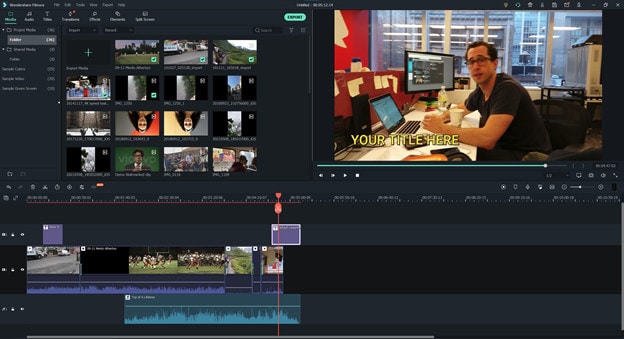
Key features
- Preset Templates
- Instant Mode
- Motion Tracking
- AI Editing Effects
- Auto Synchronization
- Plug-ins
Price
- Annual Plan: $49.99
- Perpetual Plan: $79.99
Pros
- Seamless interface for beginners
- Great customer support
- Plenty of effects and preset templates
- 4K video output options
Cons
- Rendering requires too much time
- The mobile app requires separate subscription
Supported OS: Windows , Mac , iOS , Android , iPad
G2 Ratings: 4.4 stars out of 5
Summary
Filmora’s intuitive interface allows experienced and brand-new users to create incredible videos with flawless special effects. Its high ratings and multiple supported formats make it quite popular among users.
2. Avidemux Video Editor
If you are a beginner and want to use a free, open-source software program for basic video editing, then Avidemux is a good choice. The interface is not as fancy as it could be, but there are some presets that’ll save you a lot of time. Avidemux is a cross-platform video editor that allows you to create custom videos, but it doesn’t feature the ability to share the edited footage to social media directly,
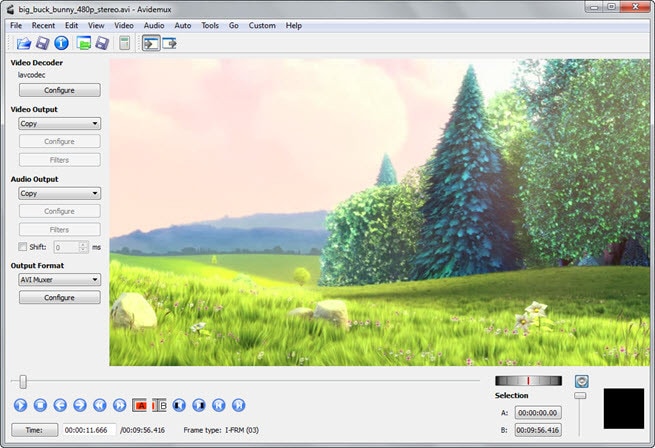
Key features
- Video and Audio Filters
- Support Popular Formats
- Convert Video For Archiving or Publishing
Price: Free
Pros
- It can convert Video To A Smaller Size
- Easy cut, trim, split video
Cons
- Out-dated UI
- Lacks sharing option
Supported OS: Windows , OS X , Linux , BSD
Uptodown Ratings: 4.0 stars out of 5
Summary
An open-source video editor that supports most formats. Due to its obsolete UI and lack of sharing features, Avidemux has average ratings.
3. VirtualDub
This open-source software is user-friendly and allows users with little experience to navigate the software without much trouble. It supports 3rd party apps and also offers batch-processing, which means working on multiple videos simultaneously makes it possible.
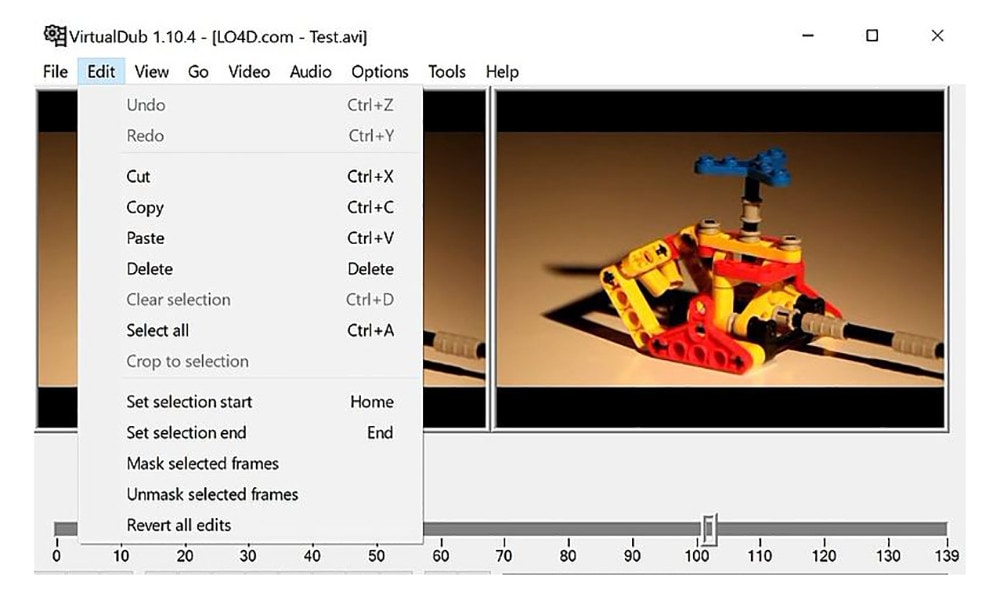
Key features
- Integrated volume and histogram meter
- Optimized disk
- Noise reduction
- Fractional frame rates
Price: Free
Pros
- Clean interface, easy to use
- Keyboard and mouse shortcuts for faster operation
- Free to use
Cons
- Not suitable for 4K editing
- Lack learning material
- Obsolete Interface
Supported OS: Windows
Compare Camp Ratings: 4.0 stars out of 5
Summary
Virtual Dub supports multitasking, and its features are pretty helpful. However, it lacks 4k editing and a friendly interface. Overall Virtual Dub is a good choice.
4. Sony Vegas Movie Studio
This video editing software makes it easy to create professional-looking videos in minimum time and effort. Vegas Movie Studio software is best for video editing professionals who have been doing it for some time and are looking for something a little more sophisticated than free alternatives. Not only does it has a high retail price, but its internal elements can be too complex for those just beginning.
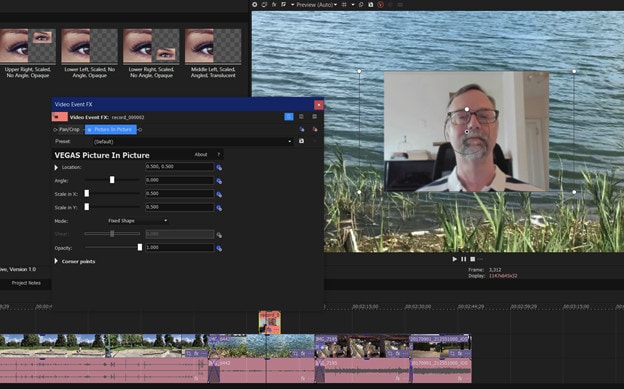
Key features
- Color correction
- HDV and AVCHD-editing
- DV batch capture
- Wide variety of file formats and codecs
Price: Starting from $7.99 USD per month
Pros
- Customizable interface
- Multicam editing
- Lots of effects and transitions, with plug-in capability
- Good slow motion and warp flow transition tools
Cons
- Less intuitive interface than competitors
- Import from camcorder not ideal
- Some tools are complex
Supported OS: Windows
G2 Ratings: 4.4 out of 5
Summary
Vegas Movie Studio is the choice of professionals. It does all the work without taking up a lot of resources, and like most programs, there is a learning curve. It’s not always intuitive for beginners, but its professional and powerful features score decent in most reviews.
5. WeVideo
This cloud-based application is a simple-to-use video editing and sharing suite. WeVideo is a full-featured video editing application that uses JumpStart technology to create amazing videos. It’s an innovative app that offers a seamless editing experience as it supports multiple formats of video, images, audio, and graphics.
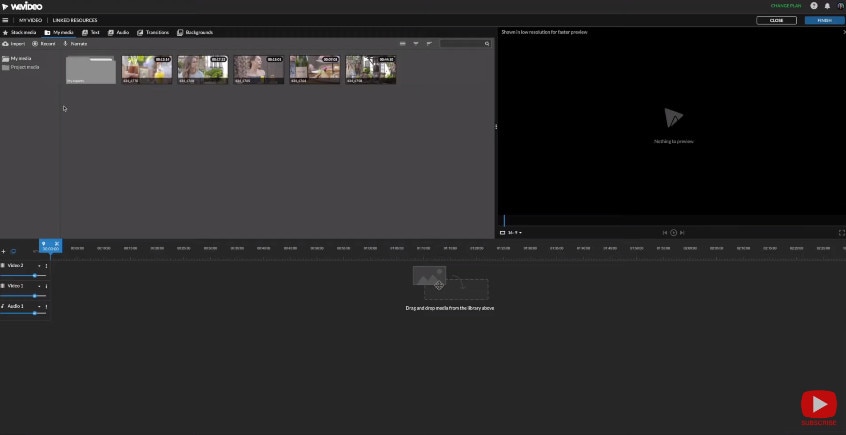
Key features
- WeVideo JumpStart
- Cloud storage
- Built-in graphics
- Customizable environment
- Advanced text editing
- Multi-track editing and storyboard
Price
- Free trial
- Power Plan: $9.99/month
- Unlimited Plan: $15.99/month
- Professional Plan: $39.99/month
- Business Plan: $73.99/month
Pros
- Constantly improving features
- Ease of use
- Storage is cloud-based
Cons
- Old fashion transition
- Leaves a watermark on free trial
Supported OS: Online
Trustpilot Ratings: 4 stars out of 5
Summary
WeVideo is a straightforward yet robust video editor. It offers a variety of features and supports multiple formats, plus its comprehensive pricing plan makes it useful for everyone.
6. Lightworks
Lightworks is the most powerful video editor in its class and an excellent tool for professionals who want to make amazing videos quickly. Lightworks is very fast and straightforward to use, and it has some great features you won’t find in any other video editor. It is available on all popular OS.
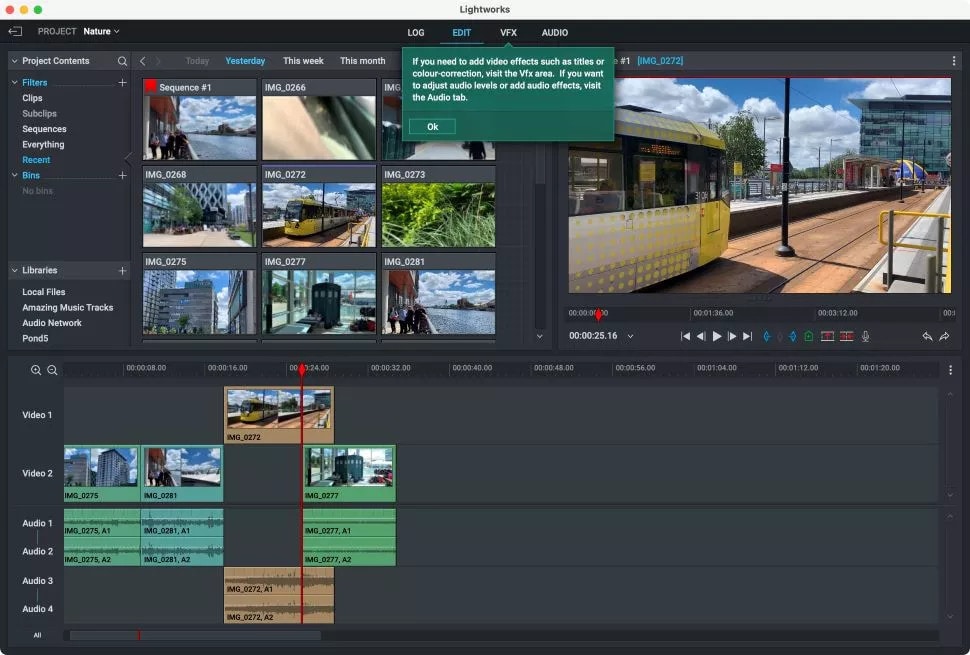
Key features
- Audio and Video Effect Plugin Support
- Cloud Connected
- Motion Graphics
- Advanced Metadata
- Proxy Workflows
- Apple ProRes decoding
Price
- Monthly Plan: $9.99/user
- Yearly Plan: $9.99/user
- Perpetual: $154.99
Pros
- High-resolution timeline rendering
- It has social media export templates
- Interfaces for multiple OS are consistent
- Instant autosave
Cons
- Commands are not always intuitive
- A bit pricey as compared to its competitors
Supported OS: Windows , Mac , Linux
Techradar Pro Ratings: 4 stars out of 5
Summary
Lightworks is not any other video editing tool available on the market of video editing tools. This video editing tool provides amateurs with the most sophisticated features in an optimized platform. Its scores are the highest on almost every review site.
7. ShotCut
Shotcut is a multiplatform video editor that lets you work with various formats for audio, video, image files, etc. This video editor makes it easy to mix and match the resolution and frame rates in a video file. All the changes you make in the editor can be undone and redone often. Shotcut is the best choice for video editing, without question.

Key features
- Webcam capture
- Audio scopes and filters
- Deinterlacing
- Eyedropper tool
- Video wipe transitions
- Keyframes for filter parameters
Price: Free
Pros
- Support for 4K resolutions
- Free
Cons
- Less intuitive than commercial apps
- Lacks built-in sharing to popular sites
Supported OS: Windows , Mac , Linux
GetApp Ratings: 4.5 out of 5 stars
Summary
Shotcut is an open-source video editor for creative professionals and is available on mac, Windows, and Linux. The free version of Shotcut has many excellent features, but it doesn’t have the slick interface or advanced techniques of the top paid editors.
8. OpenShot
An award-winning open-source video editor that creates stunning videos. OpenShot is a fast, easy-to-use, and surprisingly powerful video editor. OpenShot Video Editor allows you to work with many different types of tracks so that your edits will seem natural. OpenShot Video Editor allows you to add your custom animations or titles. The options are endless, so it all depends on your time and interest. It is available in more than 70 languages, making it ideal for all types of users.
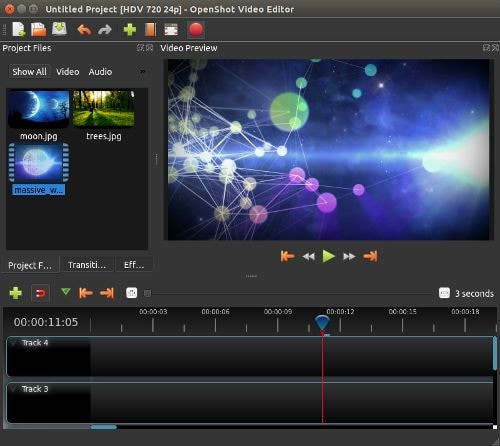
Key features
- 3D animations
- Animation and keyframes
- Multiple languages and formats
- Cross-platform
- Video-effects
Price: Free
Pros
- It is a non-linear editor with infinite tracks
- 100% free without watermark
- Frequent updates
Cons
- Obsolete interface
- Unstable performance
- Lacks some editing features
Supported OS: Window , Mac , Linux , Chrome OS
Getapp Ratings: 4.2 stars out of 5
Summary
Another open-source video-editor in the list is named OpenShot. It’s a multi-lingual and multi-supported app with unique features. Despite its unstable performance, OpenShot is still an ideal choice for many users.
9. Movavi Video Editor Plus
Movavi Video Editor Plus is the perfect tool to bring your creative ideas to life. It has special effects, ready-made intros, and keyframe animation. Using chroma keying, you can change the background of your video clips to any color or pattern that suits your need. Movavi has now redesigned its user interface to make it easy to use.
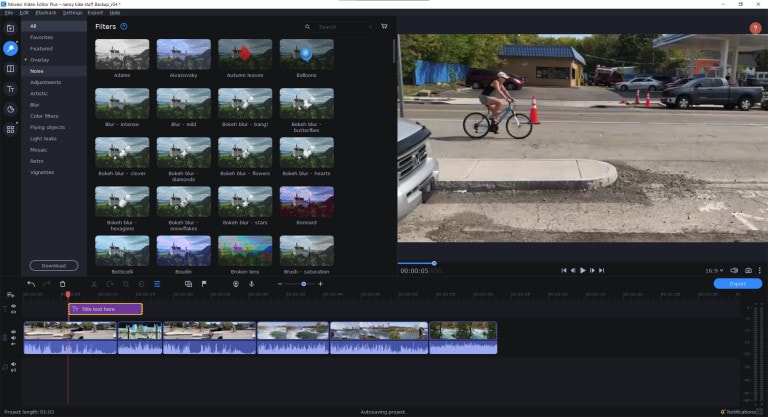
Key features
- Effects and transitions
- Built-in media pack
- Fast processing of 4K videos
- Keyframe animation
- Automatic video creation
- Cutting, trimming, joining
Price
- Free version: 7 days
- Video Editor Plus 1 year /1 PC: $49.95
- Video Editor Plus Lifetime /1 PC: $69.95
- Video Suite Lifetime /1 PC: $89.95
Pros
- Easy-to-understand user interface
- Transitions with sound
- Motion tracking and picture-in-picture tools
- Chroma-key capability
- Quick movie-creation tool
Cons
- Lacks advanced trim modes
- Slow rendering
PCMag Ratings: 4.0 stars out of 5
Summary
If you want to edit your videos with a minimal learning curve, try Movavi. You get PiP, chroma-keying, titling, basic keying, and motion tracking. The program is simple to use but doesn’t have all the features and stands four stars.
10. VSDC Free Video Editor
VSDC Free Video Editor is an online tool that lets you edit audio and video files to make your creations like movies, YouTube tutorial videos, and more. The audio and video files supported are extensive, and the software includes a codec manager. The Pro version isn’t necessary if you’re using the free edition of the software; it’s more than enough to get the job done.
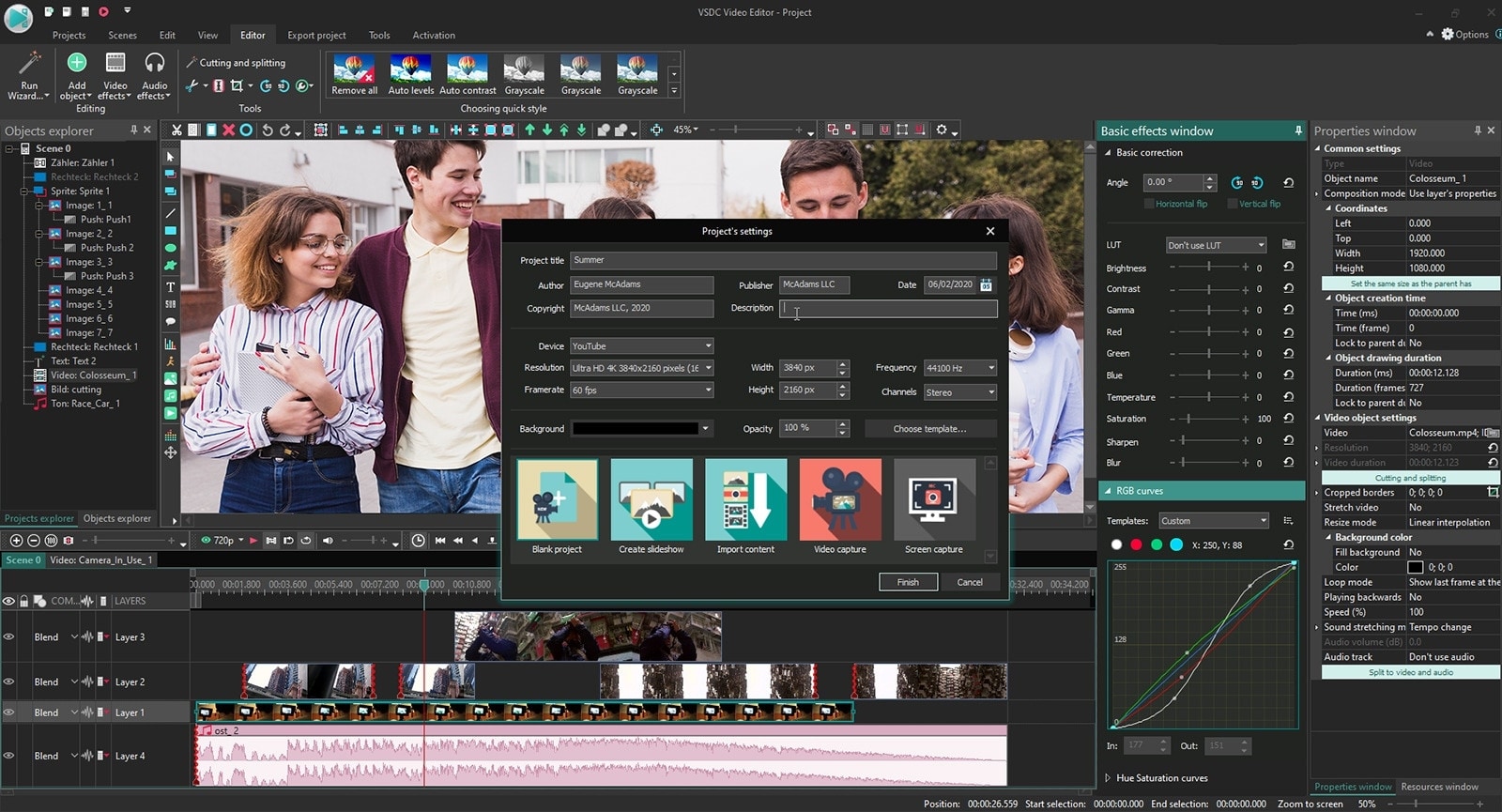
Key features
- Dark theme
- Subpixel Accuracy
- Powerful Chroma Key tool
- Trendy video effects, filters, and transitions
- Color Blending And Filters
- Built-In DVD Burning Tool
Price: Free
Pros
- Non-linear
- Video effects library
- Video stabilization
- Masking
Cons
- Outdated interface
- Lack keyboard shortcuts
- Only available on Windows
Supported OS: Windows
Capterra Ratings: 4.5 stars out 5
Summary
VSDC is a non-linear editor with extensive format support. It includes all the essential features an editor requires but with an obsolete UI. It is also ideal for many who need a powerful yet free video editor.
11. VideoPad Video Editor
VideoPad is a free video editor that can create stunning videos and perform basic editing tasks. A good video editor can help you to create videos for different social media platforms. You can make your videos look professional and polished with a few clicks and some simple editing skills. There’s nothing particularly exciting or advanced about this app; it’s simple enough for anyone new to video editing or even for seasoned editors. But the simple and easy-to-use interface makes the entire process very exciting.
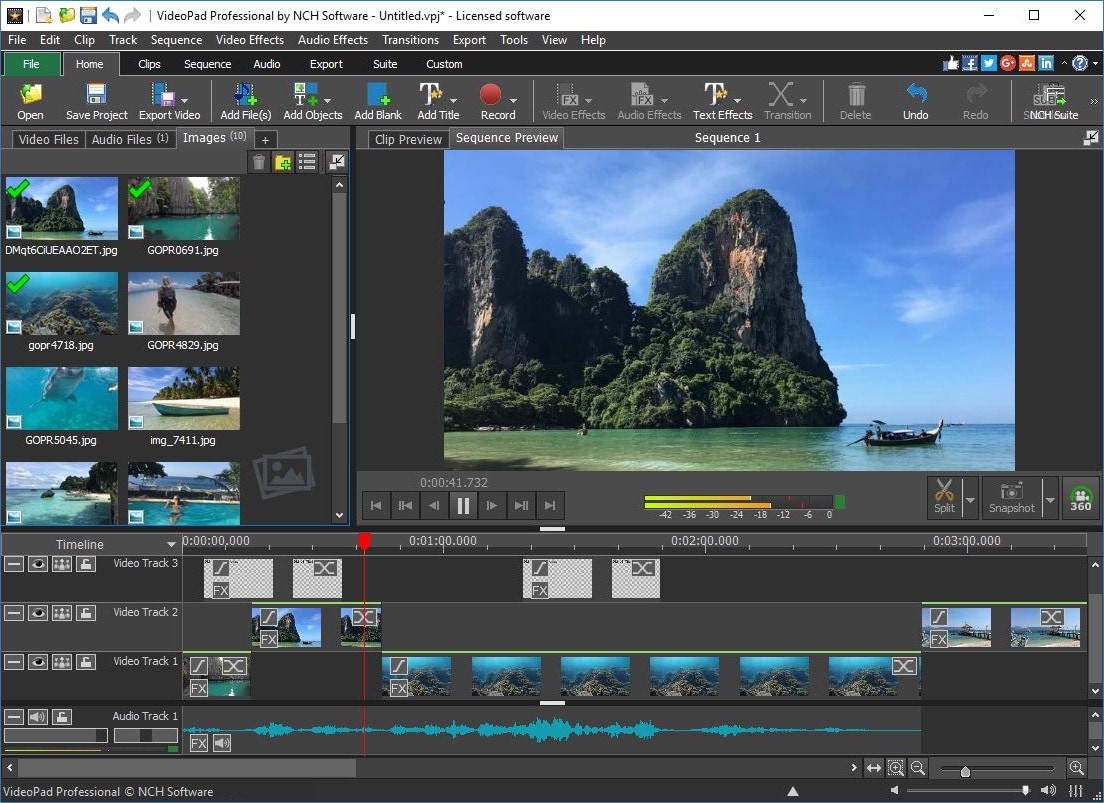
Key features
- Text snippets
- Range of transitional effects
- Plug-ins Library
- Burn finished videos to Blu-Ray, DVD, etc.
- Color correction and light balance.
Price: Free
Pros
- Simple and clean interface
- Supports multiple file formats
- Includes video effects
- Lightweight on system resources
Cons
- Lack of advanced features
Supported OS: Windows , Mac , iPad/iPhone
Tom’s guide Ratings: 3.5 stars out of 5
Summary
Video pad is a free video editor designed for beginners that is lightweight and simple. VideoPad is also great for creating quick videos for social media purposes like Youtube and Facebook. The software has a high rating, as shown above, and it’s available on Windows.
12. HitFilm
HitFilm is a helpful video editing software that makes editing easier for users. In addition to basic features, the program also provides advanced-level functions that make edited videos pop. Hitfilm Express Download has more than 400 features to help casual video editors save time. Features like: visual effects, cinematic elements, and compositing tools preset help unleash your creativity.
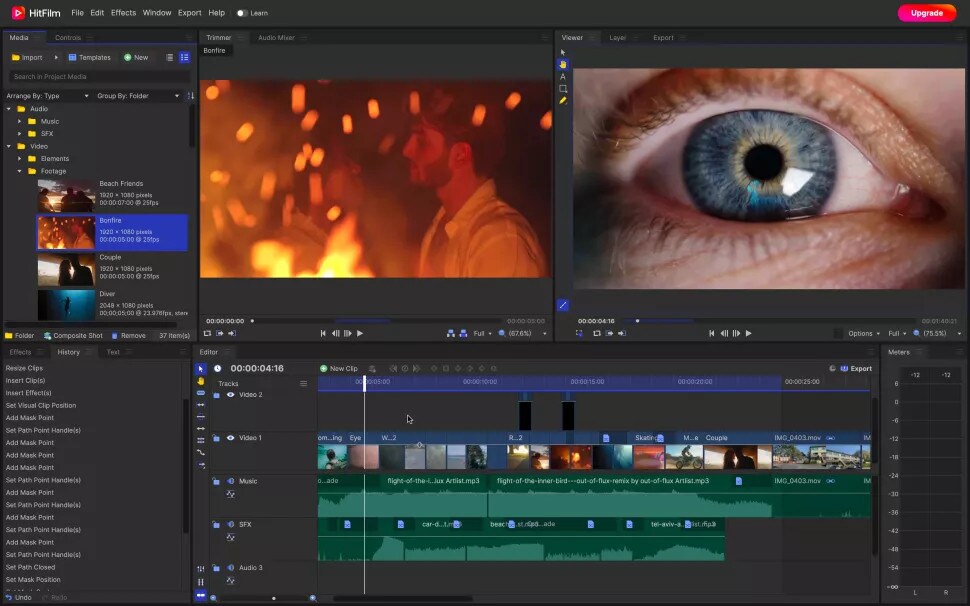
Key features
- Color Grading and correction
- Smart search
- Commentator recorder
- Lightning and lens flares
- 3D camera tracker
Price
- Free trial
- Creator: $7.50
- Pro: $12.50
- Enterprise: Custom pricing
Pros
- Intuitive interface
- It offers free tutorials and masterclasses
- Works on both Windows and Mac
Cons
- It requires heavy system requirements
TechRadar Ratings: 4.5 stars out of 5
Summary
HitFilm Express 15 is a powerful free video editing program that enables you to create high-quality videos in minutes with an intuitive interface. It offers advanced editing features such as advanced video trimming, 3D editing, and more.
13. Magix Movie Studio
Magix is the world’s leading professional audiovisual media software, with Sequoia being its industry-standard audio editing software. This movie editor is an enthusiast-level video editing software that competes with software from Adobe and CyberLink, and it even boasts support for 4K content and 360 degrees. There are many reasons to upgrade. This year’s update includes stabilization, 8K editing, motion tracking, and an in-app plug-in store.
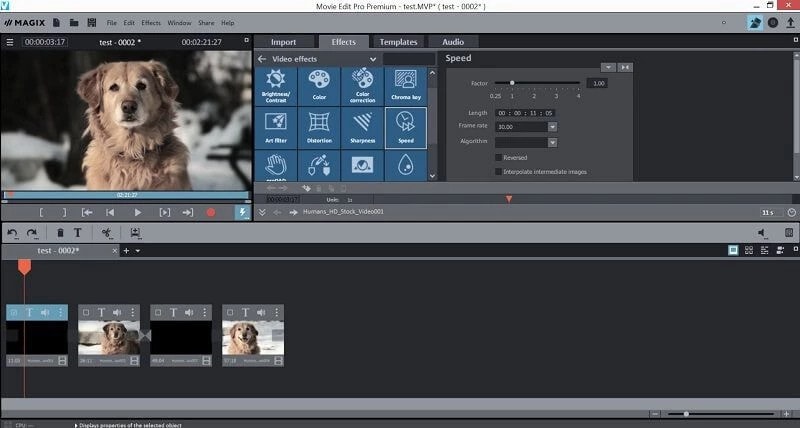
Key features
- NewBlue effects
- Fly-in animation
- New filter view
- Stabilization
- Motion tracking
- 8k support
Price
- Movie Studio 2024: $69.99 (30-day free trial)
- Movie Studio 2024 Platinum: $99.99 (30-day free trial)
- Movie Studio 2024 Suite: $129.00 (30-day free trial)
Pros
- Lots of video effects
- Responsive editing interface
- Multicam
- Trailer-like movie templates
- Solid audio editing
Cons
- Slower project rendering than others
- Lacks import and organization tools
Supported OS: Windows
PCMag Ratings: 3 stars out of 5
Summary
Magix movie studio is a powerful all-around video editing tool with many features that professional users have come to expect. It’s also relatively simple to use. But usability and performance are poor compared to other software programs like Filmora .
Part 4: How To Edit a Video With a Windows Movie Maker Alternative
Windows Movie Maker was great for editing a video, but it’s no match for some of the best video editing software. We’re talking about software capable of creating a cinematic experience in seconds, all on your computer.
When you need to edit a video with simple, quick edits, like adding a special effect or changing the background, try Filmora . Filmora is an easy-to-use application that allows you to create a movie using simple tools that don’t require additional training. You can’t beat this option if you want to create a professional-quality video for your blog or website.
Let’s dive into a quick tutorial on editing videos in Filmora:
Free Download For Win 7 or later(64-bit)
Free Download For macOS 10.14 or later
Step1 Open Wondershare Filmora on your PC or Mac
You can start a new project by clicking on ‘New Project’. And you can also change the ‘Aspect Ratio’ according to your project demand.

Step2 Import Videos
You can import your file by clicking the import tab on the upper-left side or clicking the import icon on the main window.
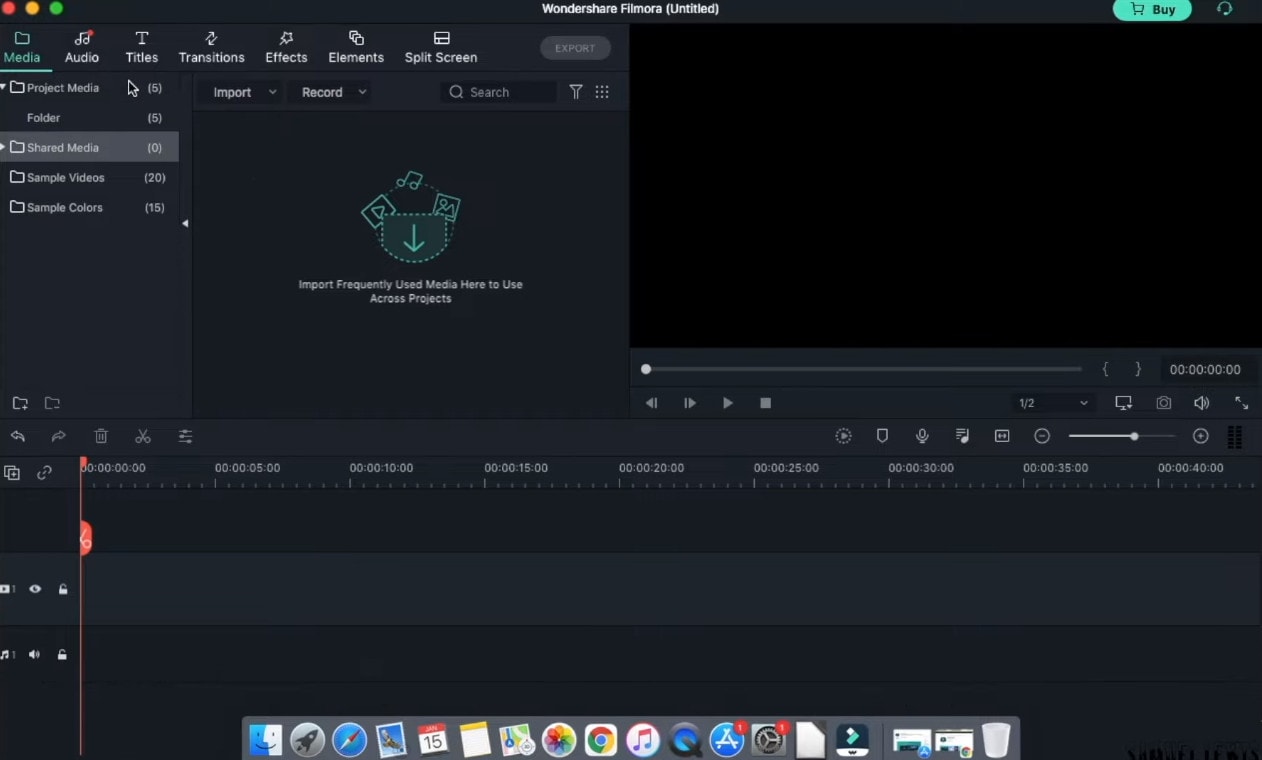
Step3 Drag and drop your footage to the timeline
After importing all the files, click and hold each individual video and drag and drop it to the timeline area according to your ideal sequence.
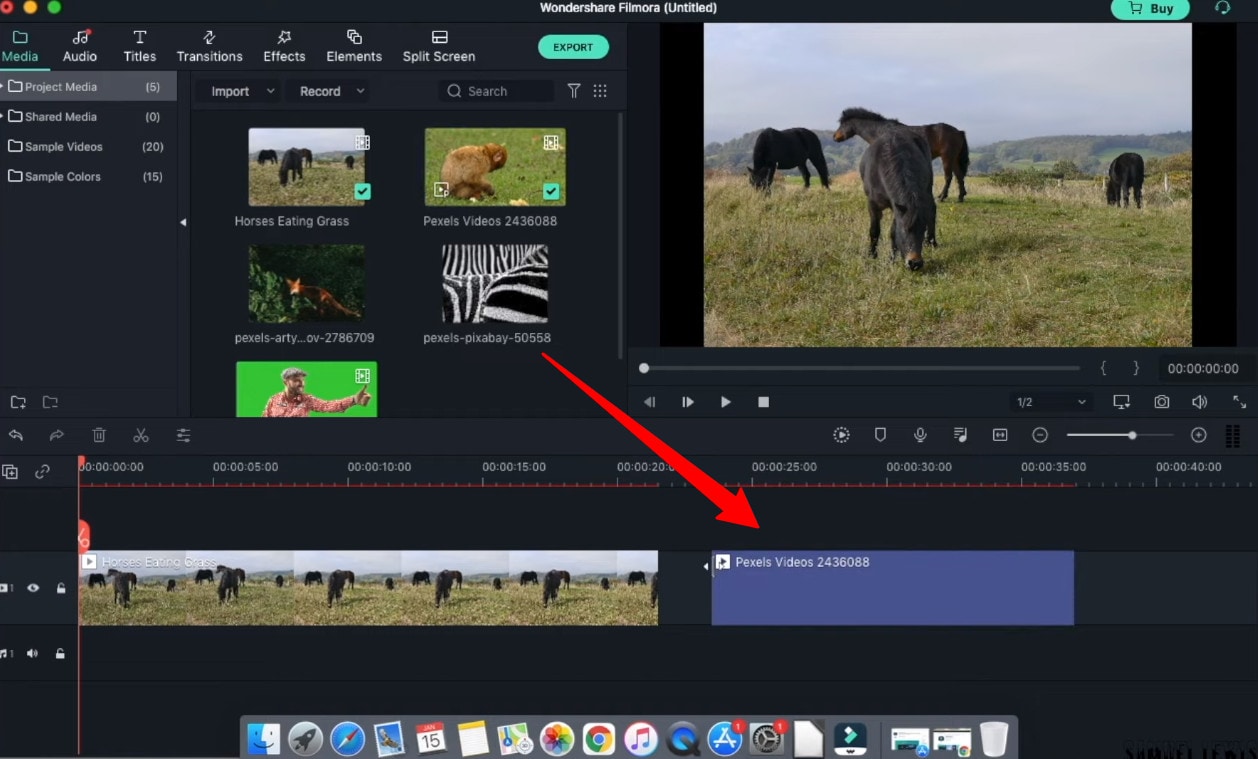
Step4 Add Audio
Go to the ‘Audio’ tab and select the audio file from the audio library. Once selected, drag and drop the audio file into the music timeline.
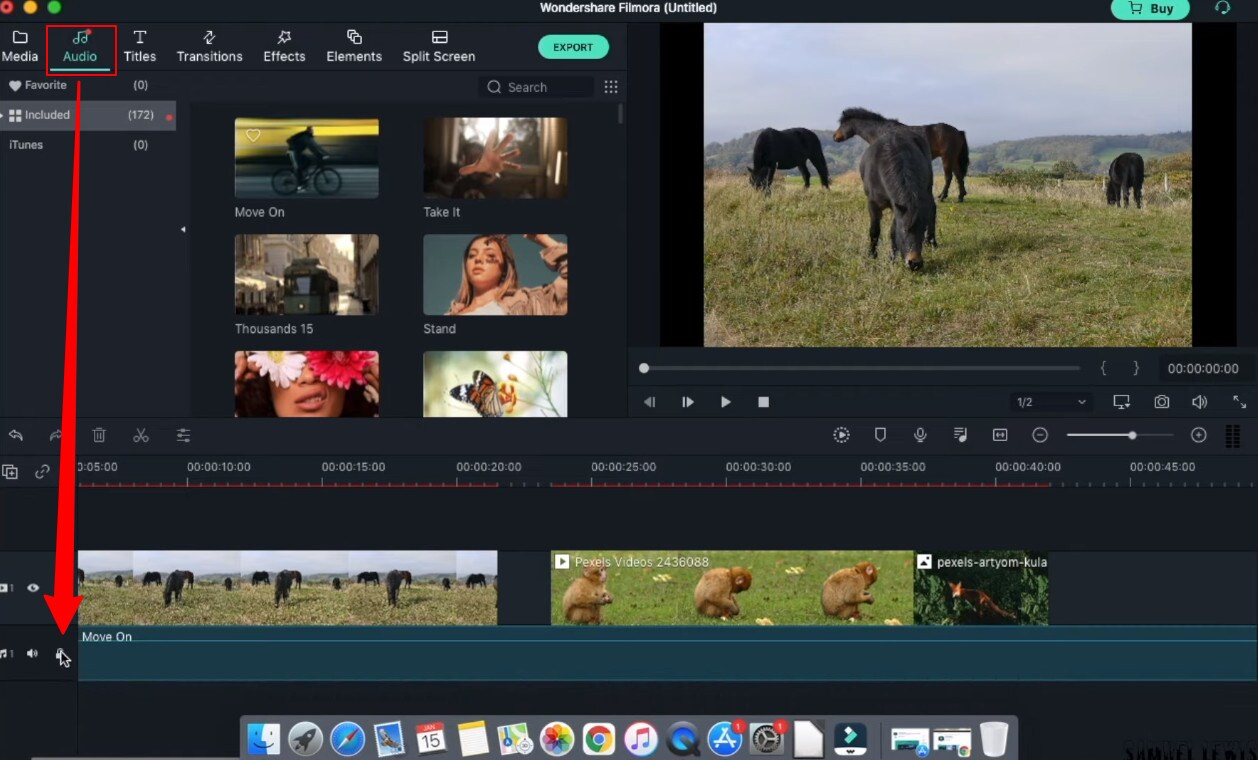
Step5 Add Titles
In your video intro, you can insert some title text. Go to the ‘Titles’ tab and select the one you like, and drag and drop it on top of the timeline. Double-click and edit the text and state your ideal statements. You can customize your text fonts and color too.
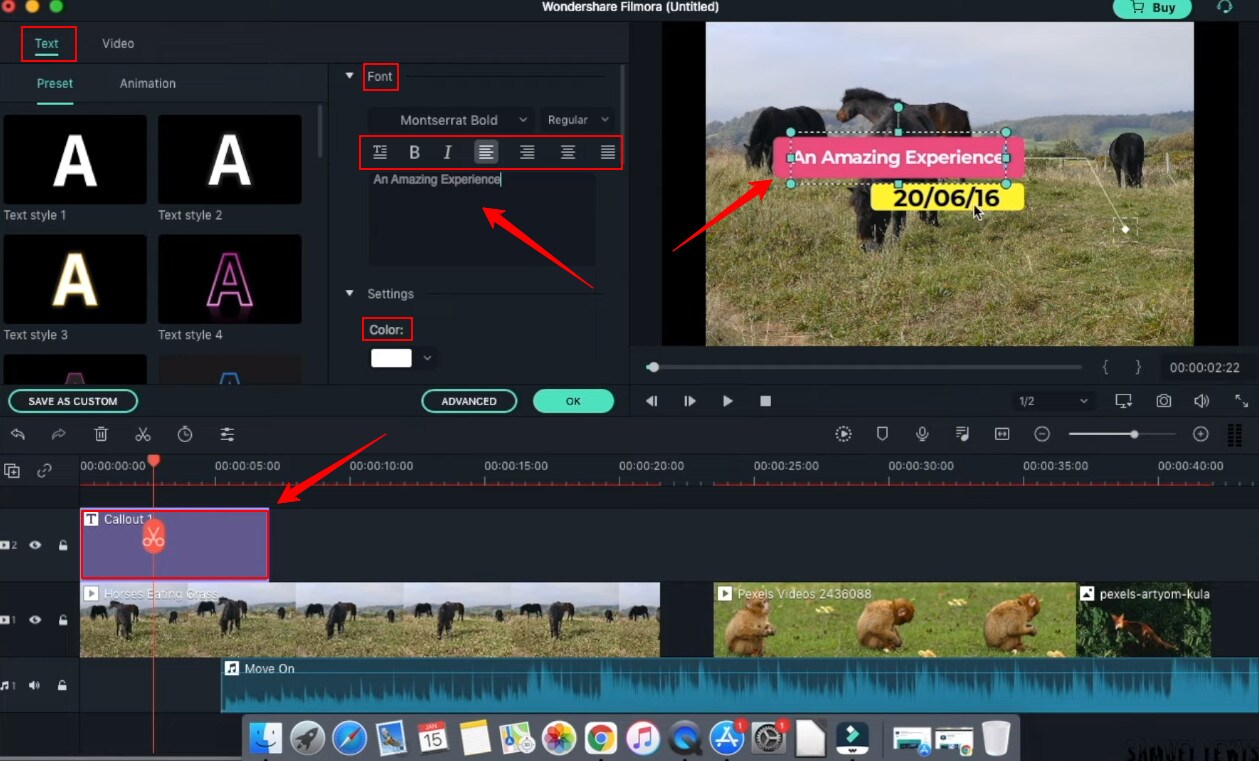
Step6 Add Transitions
You can add transition effects to ensure a smooth transition from one scene to another. The overall will get more professional look.

Step7 Add Effects
Next; you can get special effects to your video to make them more attractive and engaging to watch. Simple drag down the effect to your video and watch the effect take place in your selective scene.
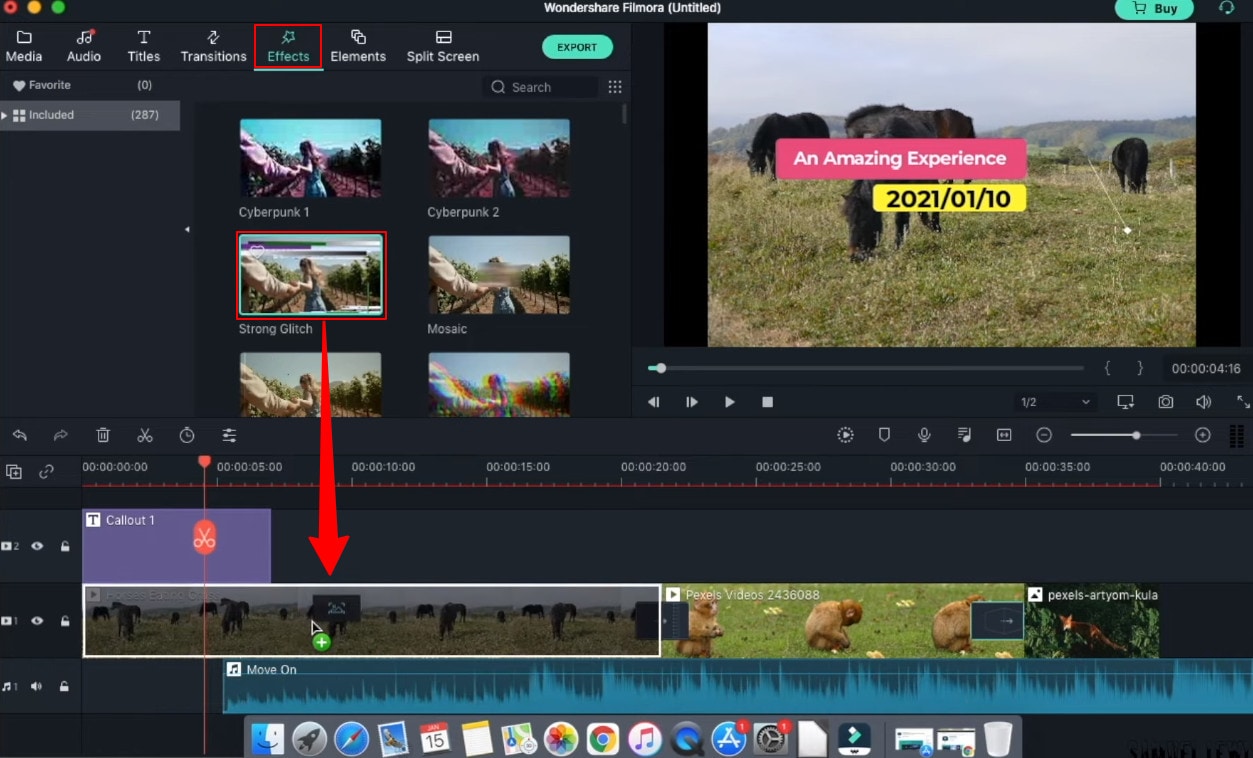
Step8 Export your work
Once all the changes have been made, hit ‘export’ from the top tab. A window will appear where you can change the settings, resolution, frame rate, bit rate, etc. Next, click the ‘export’ button down on that window, and then you can save the file in your drive.
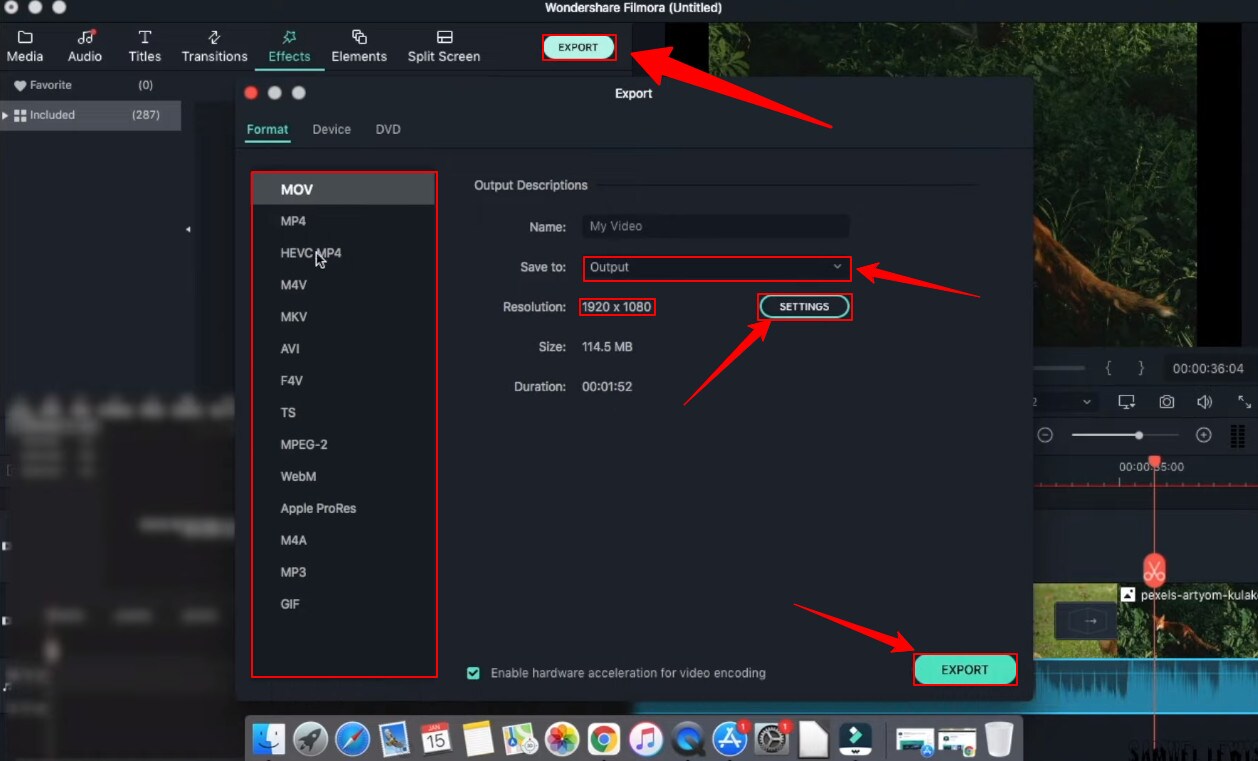
Part 5: Hot FAQs on Windows Movie Maker Alternatives
1. Why is Windows Movie Maker discontinued?
Microsoft’s video editing program, Windows Movie Maker, did not become a big hit with the public because it failed to do well on the market. Microsoft couldn’t get the support they were looking for from the program’s users. As a result, Microsoft had to cease its support of the program.
2. Is there a free version of Windows Movie Maker?
Microsoft Windows Movie maker was always accessible and pre-installed every windows product. Microsoft has discontinued support for Movie Maker and warns about free downloads of Movie Maker provided by third parties that might contain malware, viruses, or other issues.
3. What are the best free Windows Movie Maker Alternatives for Mac?
After switching to a Mac, you’ll find that the Windows Movie Maker alternatives offer much more than just a simple video editor. They provide advanced features, easy transitions, and less technical know-how to create pro-quality results. You should try using these platforms on your Mac if you have a video to edit.
- Wondershare Filmora
- Movavi
- OpenShot
Final Words
Windows Movie Maker is an excellent Windows video editor application for Windows users. But in recent years, it has become outdated due to the continuous development of new technologies. There are many alternatives for Windows Movie Maker, and here we listed some of the best ones. Most of them are free and featured packs. Each program has its unique set of features and capabilities, and each one excels in different areas. Check them out and see what you think.
Free Download For Win 7 or later(64-bit)
Free Download For macOS 10.14 or later
Part 1: Top 3 Picks for Windows Movie Maker Alternatives
The world’s best video editing software is about to change. We look at three of the most popular and valuable alternatives to Windows Movie Maker.
You will need to consider these alternatives to ensure they meet your expectations and needs.
1. Wondershare Filmora - Best Overall

Filmora is the best Windows Movie Maker Alternative designed according to your convenience.
Ratings: 4.4 Stars out 5
Starting from $49.99
2. Magix Movie Studio - Best for Collages

This alternative offers a variety of tools and plugins for anyone who wants to create professional-level videos in under a minute.
Download on Windows
Ratings: 4 stars out of 5
30-day free trials, then starts from $69.99 all the way to $129
3. Avidemux Video Editor - Best Open-Source Editor

An open-source editor that supports a wide range of formats is free! Avidemux has an interface similar to Windows Movie Maker, which makes it a perfect alternative.
Download on Windows
Ratings: 4.0 stars out of 5
Free Trial
Part 2: Ultimate Overview on 13 Best Alternatives to Windows Movie Maker
We live in visual culture, and we constantly see, capture, upload, and share videos on our smartphones, tablets, and laptops. So, it is only natural that more people seek ways to edit their videos. Windows Movie Maker was one of the most popular video editing apps. So it’s time to dig into the best Windows Movie Maker alternatives, which are arguably better and feature-rich.
| Software | OS | Media Resources | AI editing | Easy to Use | Free Trial |
|---|---|---|---|---|---|
| Wondershare Filmora | WindowsMacMobile | Yes | Yes | Yes | Yes |
| Avidemux | WindowsOS XLinuxBSD | Yes | No | Yes | Yes |
| Virtual Dub | Windows | No | No | Yes | Yes |
| Vegas Movie Studio | Windows | Yes | Yes | No | No |
| WeVideo | Online | Yes | No | Yes | Yes |
| Lightworks | LinuxOS X Windows | Yes | Yes | No | No |
| ShotCut | WindowsMacLinuxBSD | Yes | No | No | Yes |
| OpenShot | WindowsMacLinuxChrome OS | Yes | No | Yes | Yes |
| Movavi Plus | WindowsMac | Yes | No | Yes | Yes |
| VSDC | Windows | Yes | No | Yes | Yes |
| VideoPad | WindowsMaciPad/iPhone | Yes | No | Yes | Yes |
| HitFilm | WindowsMac | Yes | Yes | Yes | Yes |
| Magix Movie Studio | Windows | Yes | Yes | No | Yes |
Part 3: 13 Best Windows Movie Maker Alternatives for Windows
As we all know, Windows Movie Maker is the most used and trusted tool for creating videos in Windows. With its unique features and user-friendly interface, people often use this software to develop short and entertaining videos.
However, the fact is that Windows Movie Maker is not the current best video editing software for creating complex video projects. For this reason, we compiled a list of the 12 best alternatives to offer you a better option for Windows Movie Maker.
1. Wondershare Filmora
Filmora 11 is a powerful, easy-to-use video editor specially designed to streamline your workflow and save you hours weekly. It supports everything from Windows, Mac, and IOS to Android. The latest update to the flagship app includes several key enhancements that result in a much more efficient video creation workflow and one that’s easier to use than its rivals.

Key features
- Preset Templates
- Instant Mode
- Motion Tracking
- AI Editing Effects
- Auto Synchronization
- Plug-ins
Price
- Annual Plan: $49.99
- Perpetual Plan: $79.99
Pros
- Seamless interface for beginners
- Great customer support
- Plenty of effects and preset templates
- 4K video output options
Cons
- Rendering requires too much time
- The mobile app requires separate subscription
Supported OS: Windows , Mac , iOS , Android , iPad
G2 Ratings: 4.4 stars out of 5
Summary
Filmora’s intuitive interface allows experienced and brand-new users to create incredible videos with flawless special effects. Its high ratings and multiple supported formats make it quite popular among users.
2. Avidemux Video Editor
If you are a beginner and want to use a free, open-source software program for basic video editing, then Avidemux is a good choice. The interface is not as fancy as it could be, but there are some presets that’ll save you a lot of time. Avidemux is a cross-platform video editor that allows you to create custom videos, but it doesn’t feature the ability to share the edited footage to social media directly,

Key features
- Video and Audio Filters
- Support Popular Formats
- Convert Video For Archiving or Publishing
Price: Free
Pros
- It can convert Video To A Smaller Size
- Easy cut, trim, split video
Cons
- Out-dated UI
- Lacks sharing option
Supported OS: Windows , OS X , Linux , BSD
Uptodown Ratings: 4.0 stars out of 5
Summary
An open-source video editor that supports most formats. Due to its obsolete UI and lack of sharing features, Avidemux has average ratings.
3. VirtualDub
This open-source software is user-friendly and allows users with little experience to navigate the software without much trouble. It supports 3rd party apps and also offers batch-processing, which means working on multiple videos simultaneously makes it possible.

Key features
- Integrated volume and histogram meter
- Optimized disk
- Noise reduction
- Fractional frame rates
Price: Free
Pros
- Clean interface, easy to use
- Keyboard and mouse shortcuts for faster operation
- Free to use
Cons
- Not suitable for 4K editing
- Lack learning material
- Obsolete Interface
Supported OS: Windows
Compare Camp Ratings: 4.0 stars out of 5
Summary
Virtual Dub supports multitasking, and its features are pretty helpful. However, it lacks 4k editing and a friendly interface. Overall Virtual Dub is a good choice.
4. Sony Vegas Movie Studio
This video editing software makes it easy to create professional-looking videos in minimum time and effort. Vegas Movie Studio software is best for video editing professionals who have been doing it for some time and are looking for something a little more sophisticated than free alternatives. Not only does it has a high retail price, but its internal elements can be too complex for those just beginning.

Key features
- Color correction
- HDV and AVCHD-editing
- DV batch capture
- Wide variety of file formats and codecs
Price: Starting from $7.99 USD per month
Pros
- Customizable interface
- Multicam editing
- Lots of effects and transitions, with plug-in capability
- Good slow motion and warp flow transition tools
Cons
- Less intuitive interface than competitors
- Import from camcorder not ideal
- Some tools are complex
Supported OS: Windows
G2 Ratings: 4.4 out of 5
Summary
Vegas Movie Studio is the choice of professionals. It does all the work without taking up a lot of resources, and like most programs, there is a learning curve. It’s not always intuitive for beginners, but its professional and powerful features score decent in most reviews.
5. WeVideo
This cloud-based application is a simple-to-use video editing and sharing suite. WeVideo is a full-featured video editing application that uses JumpStart technology to create amazing videos. It’s an innovative app that offers a seamless editing experience as it supports multiple formats of video, images, audio, and graphics.

Key features
- WeVideo JumpStart
- Cloud storage
- Built-in graphics
- Customizable environment
- Advanced text editing
- Multi-track editing and storyboard
Price
- Free trial
- Power Plan: $9.99/month
- Unlimited Plan: $15.99/month
- Professional Plan: $39.99/month
- Business Plan: $73.99/month
Pros
- Constantly improving features
- Ease of use
- Storage is cloud-based
Cons
- Old fashion transition
- Leaves a watermark on free trial
Supported OS: Online
Trustpilot Ratings: 4 stars out of 5
Summary
WeVideo is a straightforward yet robust video editor. It offers a variety of features and supports multiple formats, plus its comprehensive pricing plan makes it useful for everyone.
6. Lightworks
Lightworks is the most powerful video editor in its class and an excellent tool for professionals who want to make amazing videos quickly. Lightworks is very fast and straightforward to use, and it has some great features you won’t find in any other video editor. It is available on all popular OS.

Key features
- Audio and Video Effect Plugin Support
- Cloud Connected
- Motion Graphics
- Advanced Metadata
- Proxy Workflows
- Apple ProRes decoding
Price
- Monthly Plan: $9.99/user
- Yearly Plan: $9.99/user
- Perpetual: $154.99
Pros
- High-resolution timeline rendering
- It has social media export templates
- Interfaces for multiple OS are consistent
- Instant autosave
Cons
- Commands are not always intuitive
- A bit pricey as compared to its competitors
Supported OS: Windows , Mac , Linux
Techradar Pro Ratings: 4 stars out of 5
Summary
Lightworks is not any other video editing tool available on the market of video editing tools. This video editing tool provides amateurs with the most sophisticated features in an optimized platform. Its scores are the highest on almost every review site.
7. ShotCut
Shotcut is a multiplatform video editor that lets you work with various formats for audio, video, image files, etc. This video editor makes it easy to mix and match the resolution and frame rates in a video file. All the changes you make in the editor can be undone and redone often. Shotcut is the best choice for video editing, without question.

Key features
- Webcam capture
- Audio scopes and filters
- Deinterlacing
- Eyedropper tool
- Video wipe transitions
- Keyframes for filter parameters
Price: Free
Pros
- Support for 4K resolutions
- Free
Cons
- Less intuitive than commercial apps
- Lacks built-in sharing to popular sites
Supported OS: Windows , Mac , Linux
GetApp Ratings: 4.5 out of 5 stars
Summary
Shotcut is an open-source video editor for creative professionals and is available on mac, Windows, and Linux. The free version of Shotcut has many excellent features, but it doesn’t have the slick interface or advanced techniques of the top paid editors.
8. OpenShot
An award-winning open-source video editor that creates stunning videos. OpenShot is a fast, easy-to-use, and surprisingly powerful video editor. OpenShot Video Editor allows you to work with many different types of tracks so that your edits will seem natural. OpenShot Video Editor allows you to add your custom animations or titles. The options are endless, so it all depends on your time and interest. It is available in more than 70 languages, making it ideal for all types of users.

Key features
- 3D animations
- Animation and keyframes
- Multiple languages and formats
- Cross-platform
- Video-effects
Price: Free
Pros
- It is a non-linear editor with infinite tracks
- 100% free without watermark
- Frequent updates
Cons
- Obsolete interface
- Unstable performance
- Lacks some editing features
Supported OS: Window , Mac , Linux , Chrome OS
Getapp Ratings: 4.2 stars out of 5
Summary
Another open-source video-editor in the list is named OpenShot. It’s a multi-lingual and multi-supported app with unique features. Despite its unstable performance, OpenShot is still an ideal choice for many users.
9. Movavi Video Editor Plus
Movavi Video Editor Plus is the perfect tool to bring your creative ideas to life. It has special effects, ready-made intros, and keyframe animation. Using chroma keying, you can change the background of your video clips to any color or pattern that suits your need. Movavi has now redesigned its user interface to make it easy to use.

Key features
- Effects and transitions
- Built-in media pack
- Fast processing of 4K videos
- Keyframe animation
- Automatic video creation
- Cutting, trimming, joining
Price
- Free version: 7 days
- Video Editor Plus 1 year /1 PC: $49.95
- Video Editor Plus Lifetime /1 PC: $69.95
- Video Suite Lifetime /1 PC: $89.95
Pros
- Easy-to-understand user interface
- Transitions with sound
- Motion tracking and picture-in-picture tools
- Chroma-key capability
- Quick movie-creation tool
Cons
- Lacks advanced trim modes
- Slow rendering
PCMag Ratings: 4.0 stars out of 5
Summary
If you want to edit your videos with a minimal learning curve, try Movavi. You get PiP, chroma-keying, titling, basic keying, and motion tracking. The program is simple to use but doesn’t have all the features and stands four stars.
10. VSDC Free Video Editor
VSDC Free Video Editor is an online tool that lets you edit audio and video files to make your creations like movies, YouTube tutorial videos, and more. The audio and video files supported are extensive, and the software includes a codec manager. The Pro version isn’t necessary if you’re using the free edition of the software; it’s more than enough to get the job done.

Key features
- Dark theme
- Subpixel Accuracy
- Powerful Chroma Key tool
- Trendy video effects, filters, and transitions
- Color Blending And Filters
- Built-In DVD Burning Tool
Price: Free
Pros
- Non-linear
- Video effects library
- Video stabilization
- Masking
Cons
- Outdated interface
- Lack keyboard shortcuts
- Only available on Windows
Supported OS: Windows
Capterra Ratings: 4.5 stars out 5
Summary
VSDC is a non-linear editor with extensive format support. It includes all the essential features an editor requires but with an obsolete UI. It is also ideal for many who need a powerful yet free video editor.
11. VideoPad Video Editor
VideoPad is a free video editor that can create stunning videos and perform basic editing tasks. A good video editor can help you to create videos for different social media platforms. You can make your videos look professional and polished with a few clicks and some simple editing skills. There’s nothing particularly exciting or advanced about this app; it’s simple enough for anyone new to video editing or even for seasoned editors. But the simple and easy-to-use interface makes the entire process very exciting.

Key features
- Text snippets
- Range of transitional effects
- Plug-ins Library
- Burn finished videos to Blu-Ray, DVD, etc.
- Color correction and light balance.
Price: Free
Pros
- Simple and clean interface
- Supports multiple file formats
- Includes video effects
- Lightweight on system resources
Cons
- Lack of advanced features
Supported OS: Windows , Mac , iPad/iPhone
Tom’s guide Ratings: 3.5 stars out of 5
Summary
Video pad is a free video editor designed for beginners that is lightweight and simple. VideoPad is also great for creating quick videos for social media purposes like Youtube and Facebook. The software has a high rating, as shown above, and it’s available on Windows.
12. HitFilm
HitFilm is a helpful video editing software that makes editing easier for users. In addition to basic features, the program also provides advanced-level functions that make edited videos pop. Hitfilm Express Download has more than 400 features to help casual video editors save time. Features like: visual effects, cinematic elements, and compositing tools preset help unleash your creativity.

Key features
- Color Grading and correction
- Smart search
- Commentator recorder
- Lightning and lens flares
- 3D camera tracker
Price
- Free trial
- Creator: $7.50
- Pro: $12.50
- Enterprise: Custom pricing
Pros
- Intuitive interface
- It offers free tutorials and masterclasses
- Works on both Windows and Mac
Cons
- It requires heavy system requirements
TechRadar Ratings: 4.5 stars out of 5
Summary
HitFilm Express 15 is a powerful free video editing program that enables you to create high-quality videos in minutes with an intuitive interface. It offers advanced editing features such as advanced video trimming, 3D editing, and more.
13. Magix Movie Studio
Magix is the world’s leading professional audiovisual media software, with Sequoia being its industry-standard audio editing software. This movie editor is an enthusiast-level video editing software that competes with software from Adobe and CyberLink, and it even boasts support for 4K content and 360 degrees. There are many reasons to upgrade. This year’s update includes stabilization, 8K editing, motion tracking, and an in-app plug-in store.

Key features
- NewBlue effects
- Fly-in animation
- New filter view
- Stabilization
- Motion tracking
- 8k support
Price
- Movie Studio 2024: $69.99 (30-day free trial)
- Movie Studio 2024 Platinum: $99.99 (30-day free trial)
- Movie Studio 2024 Suite: $129.00 (30-day free trial)
Pros
- Lots of video effects
- Responsive editing interface
- Multicam
- Trailer-like movie templates
- Solid audio editing
Cons
- Slower project rendering than others
- Lacks import and organization tools
Supported OS: Windows
PCMag Ratings: 3 stars out of 5
Summary
Magix movie studio is a powerful all-around video editing tool with many features that professional users have come to expect. It’s also relatively simple to use. But usability and performance are poor compared to other software programs like Filmora .
Part 4: How To Edit a Video With a Windows Movie Maker Alternative
Windows Movie Maker was great for editing a video, but it’s no match for some of the best video editing software. We’re talking about software capable of creating a cinematic experience in seconds, all on your computer.
When you need to edit a video with simple, quick edits, like adding a special effect or changing the background, try Filmora . Filmora is an easy-to-use application that allows you to create a movie using simple tools that don’t require additional training. You can’t beat this option if you want to create a professional-quality video for your blog or website.
Let’s dive into a quick tutorial on editing videos in Filmora:
Free Download For Win 7 or later(64-bit)
Free Download For macOS 10.14 or later
Step1 Open Wondershare Filmora on your PC or Mac
You can start a new project by clicking on ‘New Project’. And you can also change the ‘Aspect Ratio’ according to your project demand.

Step2 Import Videos
You can import your file by clicking the import tab on the upper-left side or clicking the import icon on the main window.

Step3 Drag and drop your footage to the timeline
After importing all the files, click and hold each individual video and drag and drop it to the timeline area according to your ideal sequence.

Step4 Add Audio
Go to the ‘Audio’ tab and select the audio file from the audio library. Once selected, drag and drop the audio file into the music timeline.

Step5 Add Titles
In your video intro, you can insert some title text. Go to the ‘Titles’ tab and select the one you like, and drag and drop it on top of the timeline. Double-click and edit the text and state your ideal statements. You can customize your text fonts and color too.

Step6 Add Transitions
You can add transition effects to ensure a smooth transition from one scene to another. The overall will get more professional look.

Step7 Add Effects
Next; you can get special effects to your video to make them more attractive and engaging to watch. Simple drag down the effect to your video and watch the effect take place in your selective scene.

Step8 Export your work
Once all the changes have been made, hit ‘export’ from the top tab. A window will appear where you can change the settings, resolution, frame rate, bit rate, etc. Next, click the ‘export’ button down on that window, and then you can save the file in your drive.

Part 5: Hot FAQs on Windows Movie Maker Alternatives
1. Why is Windows Movie Maker discontinued?
Microsoft’s video editing program, Windows Movie Maker, did not become a big hit with the public because it failed to do well on the market. Microsoft couldn’t get the support they were looking for from the program’s users. As a result, Microsoft had to cease its support of the program.
2. Is there a free version of Windows Movie Maker?
Microsoft Windows Movie maker was always accessible and pre-installed every windows product. Microsoft has discontinued support for Movie Maker and warns about free downloads of Movie Maker provided by third parties that might contain malware, viruses, or other issues.
3. What are the best free Windows Movie Maker Alternatives for Mac?
After switching to a Mac, you’ll find that the Windows Movie Maker alternatives offer much more than just a simple video editor. They provide advanced features, easy transitions, and less technical know-how to create pro-quality results. You should try using these platforms on your Mac if you have a video to edit.
- Wondershare Filmora
- Movavi
- OpenShot
Final Words
Windows Movie Maker is an excellent Windows video editor application for Windows users. But in recent years, it has become outdated due to the continuous development of new technologies. There are many alternatives for Windows Movie Maker, and here we listed some of the best ones. Most of them are free and featured packs. Each program has its unique set of features and capabilities, and each one excels in different areas. Check them out and see what you think.
Free Download For Win 7 or later(64-bit)
Free Download For macOS 10.14 or later
Also read:
- Updated Final Cut Pro X Not Responding? Heres the Fix
- YouTube to MP3 How to Choose the Right Converter for You
- For People Who Want to Perform some Simple Editing Tasks and Upload to YouTube or Play for There Own Amusement, There Are a Number of Excellent Choices for 2024
- New Edit Videos on Mac Download VN Video Editor or Explore Alternatives
- New Effortless Video Rotation Discover the Top 10 Online Tools
- 2024 Approved Final Cut Pro X Title Tutorial A Step-by-Step Guide
- Updated Best Free Video Splitters for WMV Files 2023 Edition
- In 2024, Free and Fabulous The Best 4K Video Editing Software Options
- Edit Like a Pro with Wax A Free Video Editing Software Guide
- Updated Best 4K Proxy Video Editing Software for Creators
- Waveform Generation Made Easy 10 Online Tools to Explore
- Instagram Music Downloader A Step-by-Step Guide
- Clean Audio, Clear Message Removing Unwanted Sounds in FCPX
- Rotate MOV Files for Free Top 5 Options
- 2024 Approved Unlock VLCs Hidden Feature Playing Videos in Slow Motion Made Easy
- Pro-Quality Video on a Budget Free Stabilization Software
- The Ultimate Guide to Converting YouTube Videos to MP3 Expert Reviews
- The Lowdown on Splice A Complete Review of Its Video Editing Capabilities
- Dont Lose Your Work! A Quick Guide to Saving FCP Projects
- In 2024, Capturing Moments How to Turn Videos Into Photos with 10 Easy Converters
- New MP3 Conversion Made Easy The Best Mac Software Solutions
- 2024 Approved Avidemux Video Editing A Beginners Guide to Cropping and Resizing
- 10 Easy-to-Use FRP Bypass Tools for Unlocking Google Accounts On Vivo Y200e 5G
- How To Repair Apple iPhone X System Issues? | Dr.fone
- Set Your Preferred Job Location on LinkedIn App of your Samsung Galaxy M34 | Dr.fone
- In 2024, Apple ID Unlock On iPhone 14 Pro? How to Fix it?
- In 2024, How To Bypass Infinix Note 30 VIP Racing Edition FRP In 3 Different Ways
- How to Fake Snapchat Location without Jailbreak On Realme C55 | Dr.fone
- 4 Things You Must Know About iPhone XS Max Activation Lock
- Apple ID Locked for Security Reasons From iPhone 6? Find the Best Solution Here
- In 2024, How To Stream Anything From Lenovo ThinkPhone to Apple TV | Dr.fone
- In 2024, How Can I Unlock My iPhone 7 Plus After Forgetting my PIN Code?
- Title: New Chromebook Linux Installation A Beginners Tutorial
- Author: Giselle
- Created at : 2024-05-19 07:45:39
- Updated at : 2024-05-20 07:45:39
- Link: https://ai-vdieo-software.techidaily.com/new-chromebook-linux-installation-a-beginners-tutorial/
- License: This work is licensed under CC BY-NC-SA 4.0.

